As a franchisor or franchisee, you understand how important marketing is for your business. However, with marketing happening on both sides of the franchise, there can a fair amount of confusion that results in marketing that cannibalizes itself.
Related: 4 keys to successful local marketing
There are many methods to handle franchise marketing. Sometimes, the franchisor and a corporate marketing team are wholly in charge. Other times, the franchisee takes on all marketing responsibilities. Most often, it’s a mix of the two.
It’s easy to see how this arrangement could cause confusion for your customers. But by coordinating your marketing efforts, your brand message will be strong and clear across all franchise locations.
Large-scale, national marketing campaigns
Here are some tips for coordinating large-scale marketing campaigns between the franchisor and franchisee.
Focus on the brand
In a franchise, the brand is often the selling point for customers. They know they can trust a certain brand and will support that franchise, no matter where they are. This is why it’s beneficial to focus on the overall brand image in your marketing efforts.
Provide a brand style guide
Franchisors can create a brand style guide for franchisees, to help them create on-brand materials and limit branding mistakes. It you aren’t sure how to create a brand style guide, take a look at this blog post for some killer examples.
Here at Lucidpress, we’re pretty obsessed with staying on-brand and empowering everyone (even franchise owners who have no design experience) to create visual content. If you’re curious how Lucidpress could streamline your franchise marketing, then check this out.
Communicate clearly & frequently
To maintain your brand image across multiple locations, communication is key. Set the precedent that there will be consistent communication regarding marketing efforts between the franchisor and franchise owners.
One area that’s often under-communicated is digital marketing strategy. The franchisor should coordinate website and social media creation with franchisees, so there aren’t multiple accounts that could confuse or misdirect customers.
Looking at these marketing strategies, the biggest factor is the brand. Build a strong brand identity that will give your franchises a good reputation, then give franchise owners the freedom to create their own marketing collateral using approved brand assets.
Small-scale, local marketing campaigns
Small-scale marketing strategies should focus on specific efforts in the local community. Franchises often have the good reputation of the larger brand, but localized marketing is what will win the community over and create a loyal fan-base.
By empowering franchisees to control their own marketing on a local level (and by giving them the tools to stay on-brand), individual franchise revenue will soar.
Here are more tips for localized, franchise-level marketing.
Find local sponsorships
Talk to local charities, sports teams or schools in the area to find opportunities to donate to a good cause and get some advertising. This is a great way to show community members that you’re invested in the area.
For example, when I was in high school, there was a Taco Time that always sponsored the school’s football and basketball teams. Their sponsorship included banners hanging up at the football field and inside the gym. They sold food at the concessions stand and had their logo printed on the game rosters. As you can imagine, my friends and I ate a lot of tacos.
This was a worthy investment for this franchisee, as it showed their support for the community and offered unique advertising opportunities. The owner of the Taco Time had a great relationship with the community and people loved going to his location.
Personalize your messages
When you’re advertising to a specific community, it’s important to personalize your messaging for your audience. Every community is different, and by catering to yours, customers will feel special and more inclined to support you.
A great example of marketing personalization is CrossFit gyms. Each gym (or “box,” in CrossFit lingo) has its own website and social media accounts that tailor their messages to the area where the gym is located. Whether it’s about the weather or events happening in the city, these gyms create a local identity for themselves that members can be part of.
Keep up-to-date
Encourage franchise owners to stay on top of trends and news as they create marketing for their franchises. Being in tune with the local news can help you spot opportunities and avoid embarrassing advertising mistakes.
Any time you post about current news or trends, make sure you do your research. An unfortunate example of this is DiGiorno. When the hashtags #whyistayed and #whyileft were trending on Twitter, DiGiorno tweeted “#whyistayed You had pizza.” The problem: these hashtags were dedicated to discussing and raising awareness of domestic abuse—an incredibly serious cause. Needless to say, many people were offended by the tweet and DiGiorno quickly apologized for its mistake.
Be where your audience is
This, of course, is one of the most important rules in marketing. No matter how clever and wonderful your marketing efforts are, if your audience doesn’t see them, then it’s a waste.
So, find out where your local audience is: Do they spend time on Facebook, Instagram or Twitter? Do they read the local newspaper? If so, that’s where you should be, too.
Be consistent with the brand
Much of the traction and business a franchise location enjoys comes from the brand name that it carries. To continue attracting and retaining that business, it’s important to stay true to the brand.
If the franchise brand is known for great customer service, then local managers have to make sure that customer service is a priority for them. Personalize each franchise to the local area, but stay true to the brand it represents. For example, maybe there’s a way to provide outstanding customer service that’s unique to your community.
A great example of this is Chick-fil-a. It’s a well-known fact that if you say “Thank you” to any Chick-fil-a employee, they will reply with “My pleasure.” Quality customer service is part of the Chick-fil-a brand, and customers can expect to receive the same level of customer service wherever they go. While each Chick-fil-a has its own concerted marketing efforts, they stay on-brand with their customer service.
Key takeaway
Marketing within a franchise can lead to miscommunication and overlap if the franchisor and franchisee do not coordinate their efforts. However, through communication and a good brand management system, your marketing efforts can complement one another and culminate in more success.
How can franchises maintain brand compliance across locations? Learn more in our free ebook, The complete guide to multi-location branding.
Our perception, to a large extent, is governed by vision. We’re attracted to visuals that make us feel good. It’s why retail stores promote special offers with balloons and other decorations, because they know shoppers will get curious enough to come over. The same principle applies to web design and digital marketing.
Related: 32 stats & facts that prove infographics aren’t dead
To illustrate just how effective visuals are in attracting visitors, consider these statistics:
- In 2016, over 60% of B2B marketers and small businesses planned to increase investments in video marketing strategies. (CMI)
- On average, tweets with images receive 150% more retweets than tweets without. (HubSpot)
- On average, Facebook posts with images receive 2.3x more engagement than posts without. (BuzzSumo)
Point is, visual design leaves an impression on visitors. You must learn how to use them wisely. In this post, let’s discuss how visual content like infographics and video can encourage your visitors to convert.
1. Create impact with the right typography
Unlike someone reading a book, visitors on a website don’t consume content from left to right then go down to the next line. In fact, virtually nothing happens in progression. Visitors will either go straight to what they need, or they’ll stop in their tracks if something more interesting catches their eye—like a 30% discount on another brand of detergent, for example.
Today’s designers are using typography to catch and keep visitors’ attention. The size, shape and placement of different fonts will enhance your message, and you can direct the focus where you want it most.
Consider the bold typography on this webpage. The cursive font complements the typewriter font, giving the site a vintage, personal feel. The use of color to emphasize certain words attracts the eye and sets a positive tone.
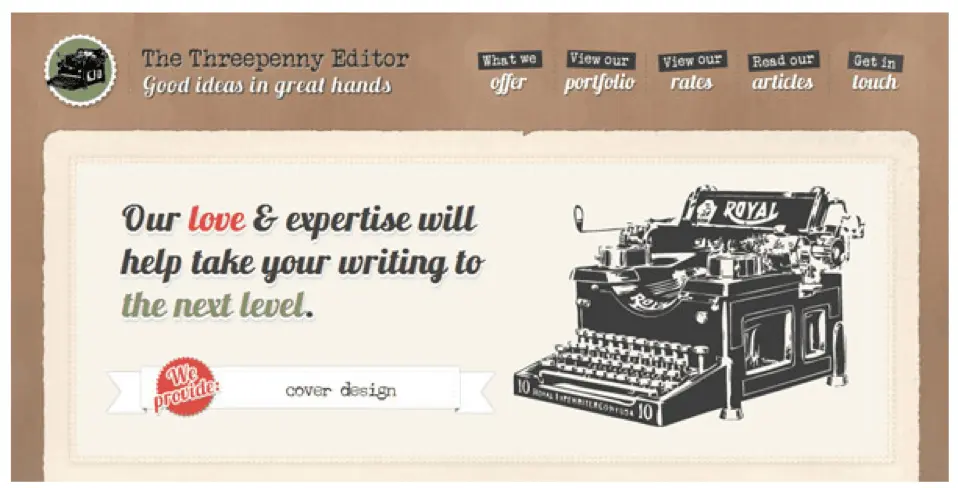
Source: Intechnic
2. Present data visually with infographics
Would you rather read through a bulky PDF filled with stats and long-winded sentences, or a colorful infographic which uses simple icons and text to display information? The choice is pretty obvious. Including a well-designed infographic in your blog post or webpage will persuade people to pause and see what you have to say.
But does it increase conversion? Here’s some compelling evidence:
- Images increase memory retention. People who hear information will only remember 10% of it three days later. But, if the information is paired with an image, they’re likely to remember 65% of it in the same timeframe. People will have an easier time reading and remembering an infographic detailing the health benefits of bananas than they would three paragraphs of text. And the more time visitors spend with your content, the more likely they are to convert.
* More shares lead to more exposure. According to NN Group, infographics are shared and liked on social media 3x more than any other type of content. Since people are more likely to share a post with an infographic, it helps you reach more people on social media faster.
3. Demonstrate your products with video
Studies show that 73% of consumers are likely to buy a product after they see a video explaining it. The medium has become many shoppers’ favorite way to find information.
Unfortunately, internet users have short attention spans and will only stick around to watch your video if the first few seconds get them hooked. With this in mind, here’s how you can make videos work for you.
- Focus on the product. Videos make it possible for brands to showcase their products in ways that might actually entice people to buy. Instructional videos provide an opportunity to familiarize an audience with your wares. For example, the furniture brand IKEA has its own YouTube channel where different how-to videos show viewers how to assemble the brand’s products.
* Focus on quality. Now that video is so popular and widespread, you have to compete on a professional level. Tailor your video for the platform it’s on. For example, Facebook visitors are more likely to stop and watch an auto-play video if it includes subtitles. If your video looks amateur or shaky, viewers will notice—and assume your brand is unprofessional.
4. Convey emotion with creative visual design
There’s a reason why people in life insurance ads are smiling. It’s to reassure us that, despite the somber nature of insurance, these folks are happy and secure with their purchase decision—and you will be, too.
Point is, humans are empathic creatures. We base our emotions on what we perceive around us. We find ourselves smiling involuntarily when we hear someone else laughing, or feeling sad when we see someone else looking miserable.
Brands can use this tendency to their advantage. All it takes is a little creativity. Consider the image on this landing page. Combined with the clever use of typography, it sends a powerful message to anyone who sees it.

Source: Scott Michael Davis
Key takeaway
To recap, even visual elements that seem simple—like the font you use—can impact conversion. Visuals that present information in appealing way, like infographics, help to retain visitors and persuade them to convert. If you’re making videos, aim for high quality polish and keep the focus on your products. Finally, visuals stir emotion. Use this to your advantage by getting creative with your visual design.
Create striking visual content in minutes with our easy-to-use desktop publishing software. Get started for free today!
Have you written off magazines because they remind you of the doctor’s office? Take another look. Digital publishing has opened up a new realm of possibilities for magazines.
And now is a great time to get into the industry—the percentage of magazine readers in the U.S. has more than quadrupled since 2013, and reports suggest that digital magazine subscriptions now outsell single issues three to one.
Related: 14 magazine layout design ideas for your inspiration
If you’re creating an online magazine, you’ll need to understand which revenue model to work with. In this post we’ll cover 5 ways you can turn a profit with your online magazine.
1. Use display advertising
As with traditional magazines, ads play a big role in funding e-magazines. Display advertising means showing an ad (text, video or audio) on a website.
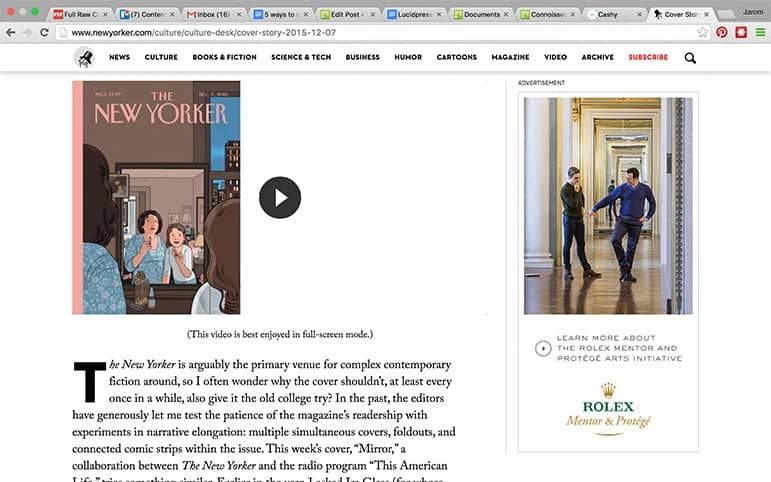
A display ad on the New Yorker website. It does a good job of targeting New Yorker readers who are, theoretically, into art.
Display advertising can take the form of banner ads or short-form video ads, both of which are viable options for bringing in revenue. Remember this:
- Decide on ad size. You may want to have a full banner ad or a smaller square one depending on what fits best into your website design.
- You also need to decide on ad position. Do you want the ad at the top of you website or to the side? You can also position the ad in between the article, as a “break” in the article. If you try that position, make sure to put a footer saying “article continued below.”
- Have an “Advertise with us” section. This will help potential clients get in touch with you easily. You can have direct ad sales or use a middleman like AdSense or BuySellAds.
2. Try native advertising
When an ad is integrated into the content, it becomes a native ad. The word “native” here signifies that it blends in with the website content, meaning it doesn’t look like a traditional ad. Native ads are viewed 53% more than banner ads.
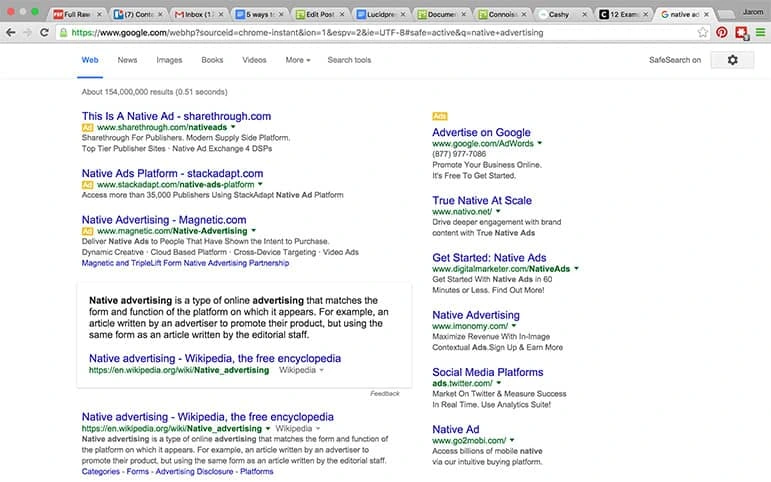
It’s easy to forget that the most common native advertisements are found in every Google search.
Remember this:
- Have a label clarifying that the ad is sponsored content. This solves the ethical dilemma for publishers.
- Make sure the content blends well with your website. This is the crux of native advertising.
- If the brand wants you to publish a story that doesn’t mesh with the character of your website, don’t do it. If you do, loyal readers will call you out as a phony and it will hurt your magazine’s reputation.
- Be creative while looking for native advertising topic ideas. Make sure the content is entertaining or educational.
3. Make an app
Right now, 45 of the top 50 lifestyle iPad apps are magazine brands. This year, the number of mobile-only internet users exceeded the number of desktop-only internet users in the U.S. A native app could add a lot of value for your readers, and if you’re ready to commit to making one, you can make it yourself using a tool like Adobe Digital Publishing Suite or hire someone to do it for you.
That’s a fairly big investment, though. If you’d like to prove out the concept first, you can use Lucidpress to create a digital magazine with interactive content and then publish it on a unique URL with password protection. This way, you can simulate the app experience and see how your readers respond. If it takes off, then you may want to invest in a native app. Remember this:
- Have ads for the app, just like you would for the website.
- Instead of having a paid app, offer a premium account that offers benefits to users.
- Ask for readers to rate and review your app.
4. Become a subscription service
If you become a trusted source for quality content that’s providing a unique perspective, you have a good chance of gaining a loyal following of subscribers. Subscriptions are a particular helpful source of revenue because they are more consistent than a one-time ad deal.
The New Yorker has found success here, attracting a loyal fanbase by consistently putting out fantastic content. Subscribers receive unrestricted access to all the articles and blogs on The New Yorker along with 90 years of archives. Tools like Lucidpress will let you place content behind a subscription paywall. Here’s one simple way to do it:
- Publish your magazine to the web.
- Set a password so only certain people can access the content.
- After readers pay for a subscription, email them the password.
Remember this:
- Price the subscription competitively. Readers expect online subscriptions to be cheaper because there are no printing costs involved.
- Give away a few free articles so that readers can test the waters. Have a plan where readers gain access to, say, 5 free articles in a month. After 5 articles, they will have to pay a subscription fee for unlimited access.
5. Ask for donations
Some magazines depend on the goodwill of their readers to increase revenue. An online tip jar gives readers the chance to contribute to what they consider a worthy cause.
BrainPickings does a great job with this model. It’s a well-designed site that presents quality content for free while asking for donations. Offering incentives for donating can also boost your cash flow. JoshReads and Loading Artist are two websites that provide reader shout-outs for big donors.
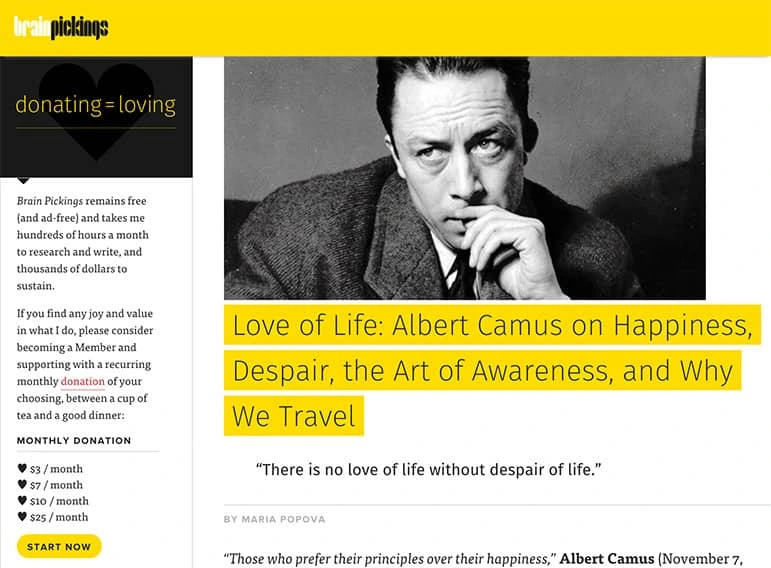
The BrainPickings’ appeal for donations.
Remember this:
- Use trusted payment apps like Patreon or PayPal on your website. These apps are designed for this purpose. They are easy to use and familiar to most web users.
- Make the donation button visible on each page. Don’t seem pushy, but write copy that strongly shows why readers should donate.
Ready to get started? Create & customize your own digital magazine with these free magazine templates in Lucidpress.
As designers, we know how important it is to deliver creative and compelling designs. Designs that catch the eye and gets the viewer thinking “That must be one hell of a product!” And over time, ads have gotten so creative and innovative that our expectations only get higher every time we see a head-turning advertisement.
Even in the age of digital marketing, print media advertising still plays a decisive role in the effectiveness of a marketing strategy. And as today’s world gets increasingly digitized, it might be easy to dismiss the idea of traditional print advertising, from cheap business cards to print flyers and product brochures.
Related: 5 elements of the perfect print job
If you want to increase your brand’s favorability and improve purchase intent, you must learn to adapt to the latest design trends and adopt new ways of doing print ads. Here are a few ways you can play with print layouts to achieve print perfection.
Experiment with your layouts
When designing print ads, you attempt to piece together the elements of the ad into a visually pleasing arrangement. The number of patterns you can use are endless, and it’s your duty to fit them into print advertisement mediums. You can do so by structuring them according to different layouts.
The frame-up

Easily frame a layout with the help of borders. This keeps the elements within bounds and sets them apart from other aspects of the page. The composition emphasizes a central component which surrounds the entirety of the ad, be it partially or wholly, focusing the attention on its center.
The big type
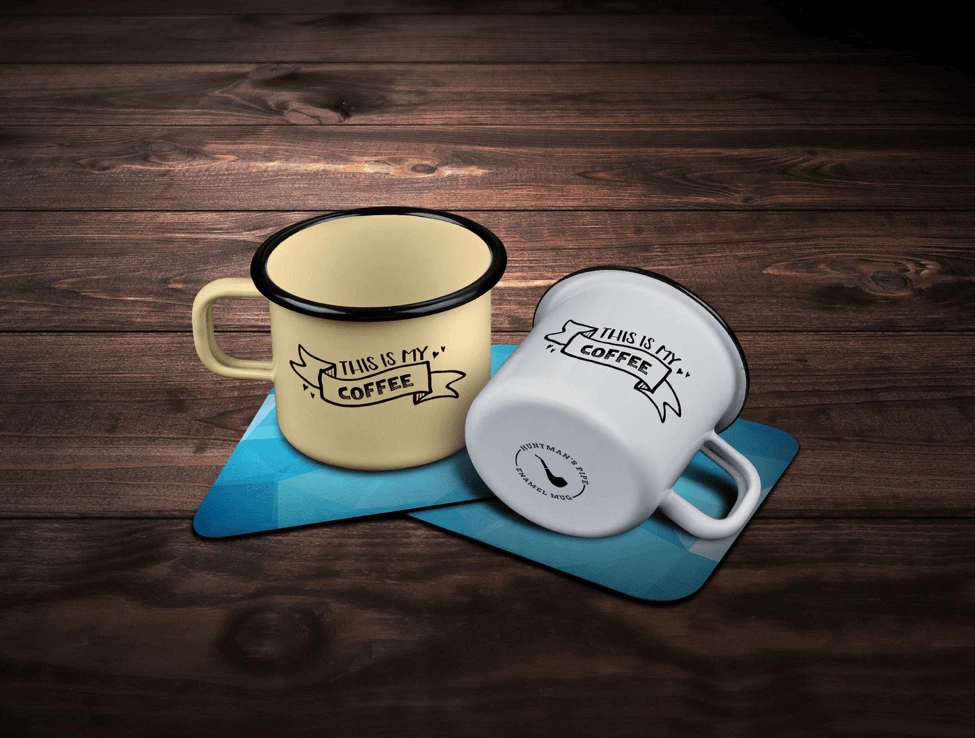
Types, especially in their larger forms, hold a particular appeal for viewers and even for artists themselves. Big types command greater attention due to their curves and stroke orders. They work seamlessly without the need for additional artwork or images, and designers can play with the typeface’s readability to convey different moods, from professional to playful.
The multi-panel layout
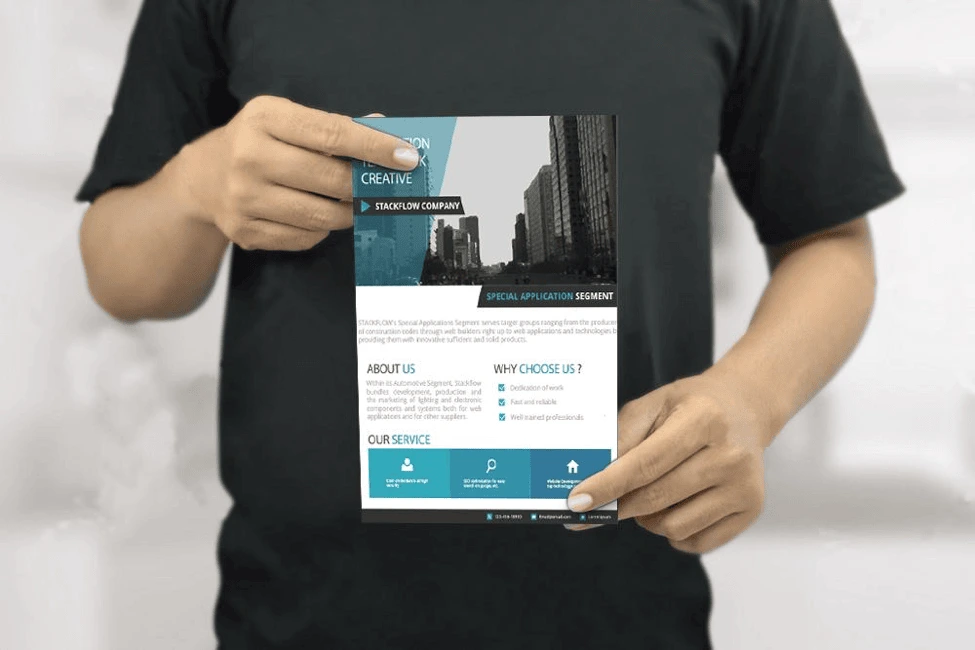
You can use panels for an variety of functions. They can be used to tell a story, or to display a set of information, or in our case, show off the products we want to advertise. This layout uses several frames to compare different perspectives or different features.
Designers often keep a proportional variation between every panel block to set the headline apart from the body and the signature. One of the most common examples is when you order business cards or promotional flyers online. You may notice that many designers opt for the clean, paneled look to help readers glide through the content.
Look at the bigger picture
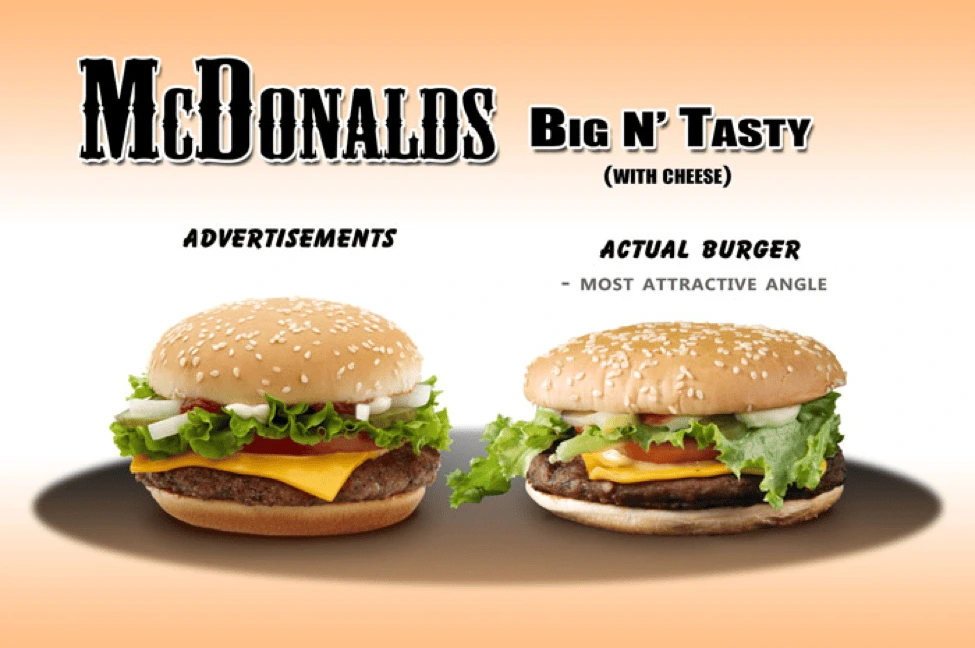
“Big Picture” layouts, also known as the picture-window layout, highlight the main visual—usually a single, large illustration that dominates the canvas. This type of layout shows the importance of the main visual without any further accents, other than the brand logo and a line of text. The image should speak for itself.
The Mondrian-esque

Inspired by Dutch painter Piet Mondrian, the Mondrian layout consists of black bars and solid areas of primary color, divided across the canvas into squares and rectangles. A Mondrian layout focuses on the proportion as the main design principle that proves to be an easily workable and logical way to showcase art and typefaces.
Incorporate different strategies
You have your product and design concepts with you, but the industry remains competitive, and consumers have higher expectations for your ads. To meet these expectations, here are four techniques to try out.
Show, don’t tell

“Show, don’t tell” is a well-known technique across many creative fields. It states that you should always take the chance to show something rather than explain it. Use your print designs to help consumers conceptualize the product with their five senses.
This Curtis tea poster is a great example. Instead of telling you how the tea would taste, they visually appeal to our senses of smell and taste to convey what the teas are like.
Play with the medium
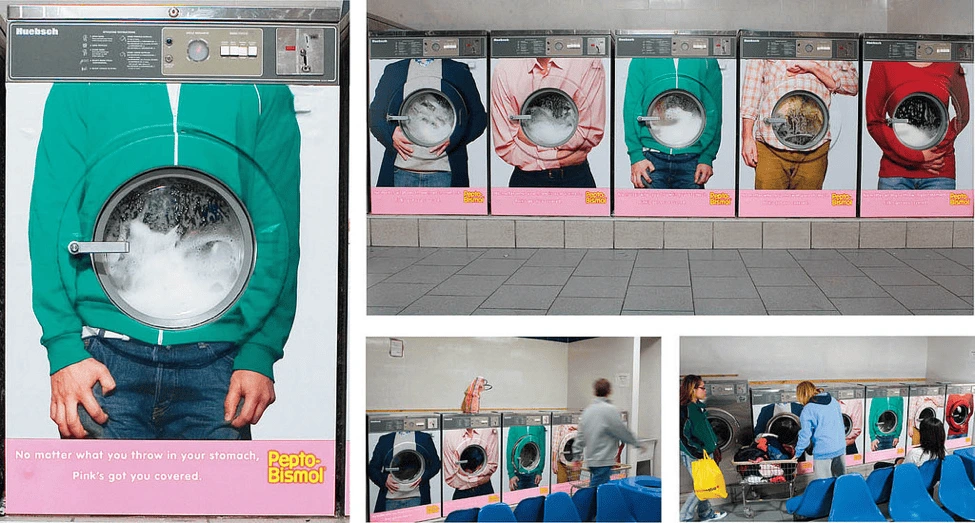
Make your design interactive using the physical parts of your print. You can make your centerfolds show motion every time you flip through the pages. Use your pages as transitional devices if you want to tell a story. For instance, you can print business cards with thin sliding panels that contain more information about your company.
Food for thought
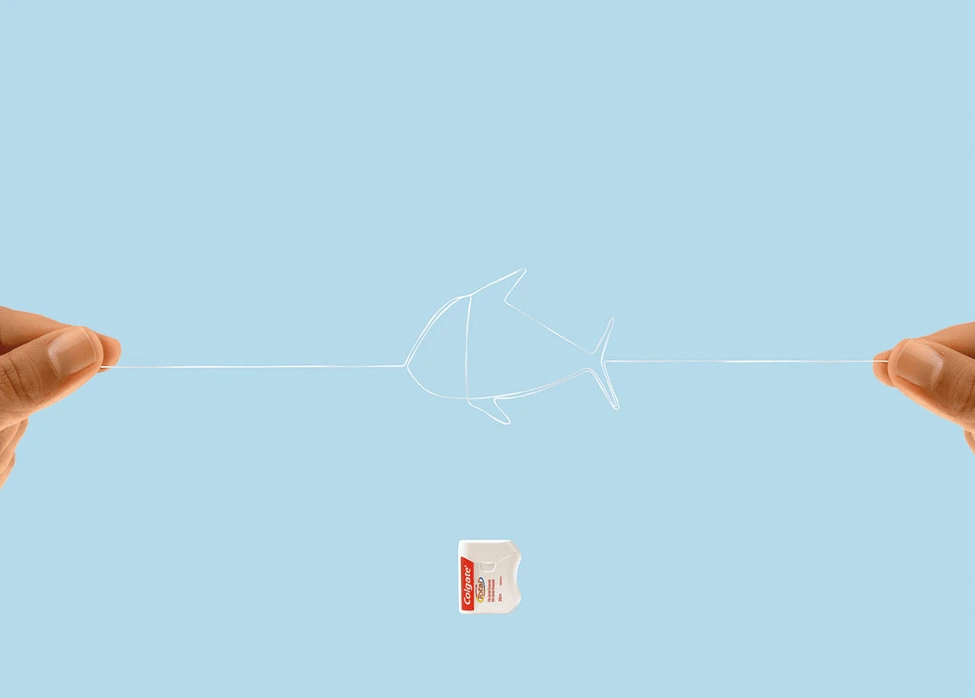
Print media is all about imagery and visualization. Use a series of images to draw the viewer into your message and show them what’s hidden underneath your clever design. Keep this famous mantra in mind: “If you have to explain it, then it probably isn’t that good.”
Invoke an emotional response

Be it via humor or deep subject matter, engage your audience through emotion. Designers can use emotional appeal to evoke sentiment and nostalgia from viewers. Consider your topic and tweak your design to enhance the emotional effect of your ads.
Key takeaway
As Pablo Picasso said: “Learn the rules like a pro so that you can break them like an artist.” To be a good designer, you need to know how to look at your product from the viewer’s perspective. You need to know how to apply different rules and techniques to create a compelling print ad. It’s up to you to decide: play by the rules, or dare to be different.
Ready to design your own print ideas? Lucidpress makes it easy to create beautifully branded content in a matter of minutes.
For savvy salespeople, it’s important to know how to craft convincing language. Words are powerful tools. They can evoke strong emotions and spur people towards taking specific actions. If you want to craft compelling messages that influence people to purchase, consider using these tried-and-true trigger words.
Related: 7 do’s and don’ts for your email signature
1. Free
Even with so many advertisements that use the word ‘free’ for things that actually come with a price, people are still attracted to this word because it taps into our overwhelming hunger for more. We envision all the new experiences we can have with the free product, and it starts to feel like a need rather than a desire. The word ‘free’ immediately ignites our imagination with new possibilities.
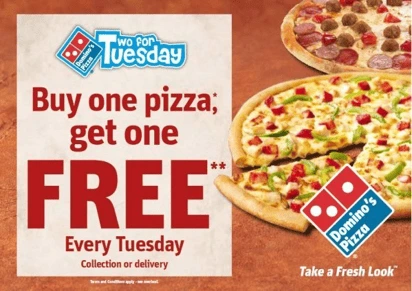
2. Easy
This one is self-explanatory. ‘Easy’ implies convenience, comfort and quickness—although it doesn’t actually guarantee that the service will be any of those things. Most of the time, marketers use this word to describe a simple, uncomplicated process, but the unspoken implications of this word help to sell it even more.

3. Now
The word ‘now’ is often used in a phrase to indicate time, which piques customer interest because people naturally like instant gratification. Think of all the ‘now’ phrases that you’ve seen in calls-to-action and promotions alike: Save Now, 30% off Now, Get Samples Now, etc. Simply indicating that the reward will be immediate makes the offer more enticing.

4. Save
Who doesn’t like saving? The word ‘save’ rings a bell and reminds us of our truest desire: to preserve and expand our resources. We’ve become so invested in this principle that promotions actually convince us to spend before we ‘save.’ It seems counterintuitive, but it still works because we believe that we can save money (or time, or hassle) by spending it first.
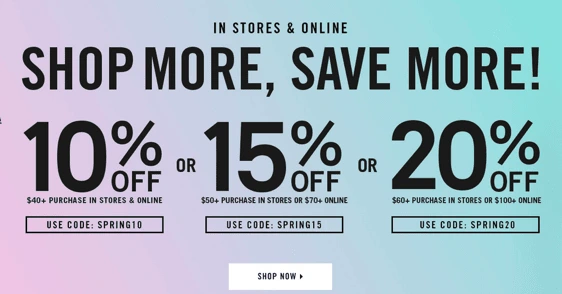
5. Package deal
As we know from the telecom and cable industries, bundling products together is a wise way to drive more sales. Giving your customers the opportunity to purchase package deals speaks to their desire to get more with less money. It’s the ‘bang for your buck’ mentality that drives this marketing phrase forward.
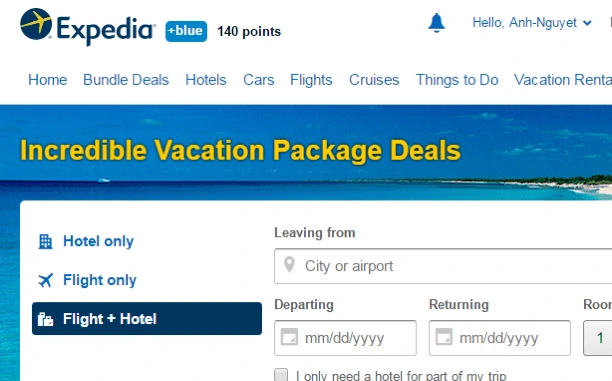
6. Premium
Labeling a product or service as premium might intimidate those who aren’t looking to spend more than they need to, but ‘premium’ works especially well with offers that indicate limited availability and discounted prices, such as Premium Package or Premium Deal. When paired with the right offer, ‘premium’ creates a sense of scarcity that encourages action.
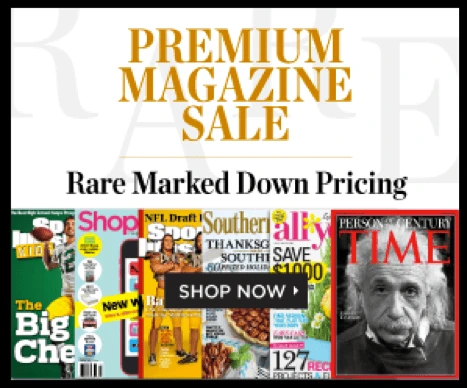
7. You
Addressing a customer directly singles them out from the crowd and creates a sense of conviction. One of the most popular advertisements that exemplifies this word was James Montgomery Flagg’s “I want YOU” poster for WWI recruitment. The Uncle Sam poster is possibly the most famous poster ever due to its iconic illustration and commanding punchline: “I want YOU for U.S. Army.” Using the word ‘you’ is much more persuasive than addressing the general public. Imagine if the poster simply illustrated a cross-armed Uncle Sam with the words, “I want everyone in the U.S. Army.” Since no one is being singled out, there would be much less conviction and the message wouldn’t have the same profound impact.

8. No obligation
Have you ever wondered why service providers always leverage the term “No contracts”? The thought of being forced into a commitment understandably repels customers. No one wants to be trapped by a contract. Therefore, to reduce friction, it’s important to state that a service or product does not come with any strings attached. Give customers the reassurance that they aren’t bound to any hidden obligations, so they can explore your brand without fear.
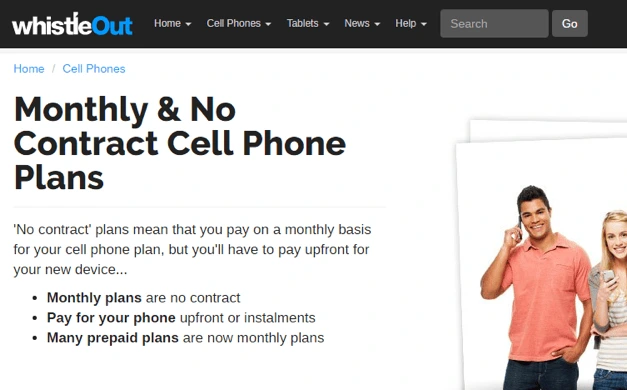
9. New
New Arrivals and New Markdowns sound tempting to the itchy buyer because it taps into the fear of missing out. They want to be the first one in, so they get to see what’s new before anyone else does. They get to be ‘in the know’ and have access to the best items or deals.
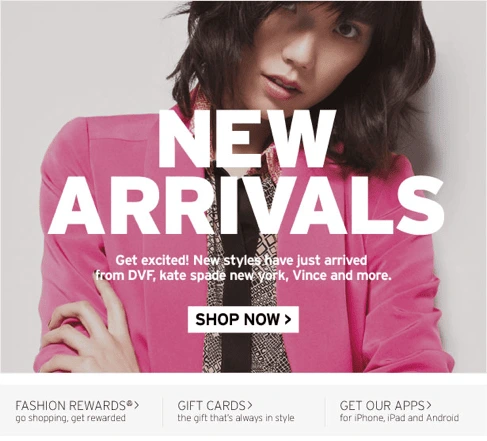
10. Limited
Similar to the word ‘premium,’ the word ‘limited’ creates a sense of scarcity that motivates consumers to make a purchase because the items won’t be there for long. The word ‘limited’ might even be better than ‘premium’ in some instances, because it doesn’t come with the implication that the limited item will be higher in price.
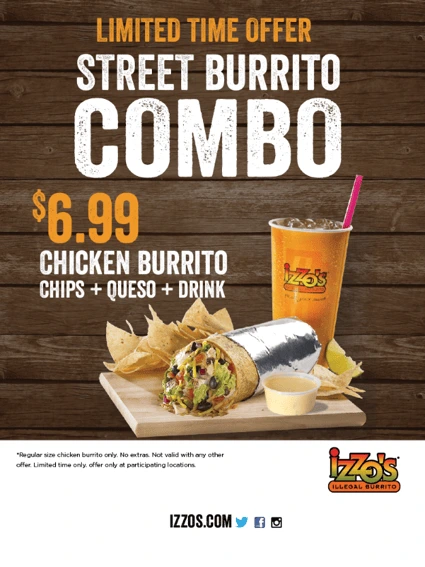
11. Ultimate
‘Ultimate’ often functions as a synonym of ‘best.’ It can also be used to indicate a comprehensive or all-encompassing experience. When a promotion contains the word ‘ultimate,’ there is an unspoken understanding that whatever is on offer must be of great quality. It might not be the first, but it’s the ultimate.
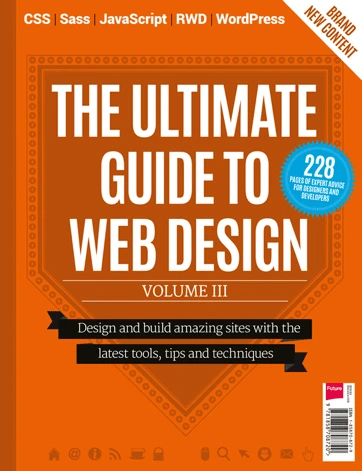
12. Professional
There’s something about the word ‘professional’ that gives an item or service more authority and credibility. It often implies a higher standard. Without being fully aware of it, when we see this word, it brings into our mind what professionalism should look like—and we apply that to the promoted product or service.
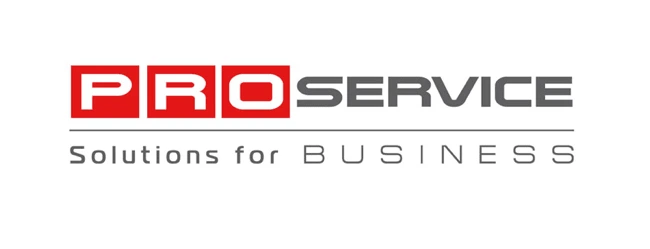
13. Competitive
Labeling a product or service as competitive helps the customer envision how multiple products could be compared to one another—and how the one that’s most ‘competitive’ is the winner. Everyone wants to be on the winning team, and competition drives us to constantly improve. When you say your brand is competitive, you’re making a promise to the customer that you’ll always strive to be the best.

14. Sale
The word ‘sale’ ties back into the idea of saving, because it implies that the consumer can save money by purchasing the sale items now. Sales have worked wonders since they were invented, because they wrap together so many concepts: discounts, limited time, availability. Just be careful not to run ‘sales’ all the time, because customers will get used to it and always expect your prices to be low. Sales should be events that your customers look forward to.
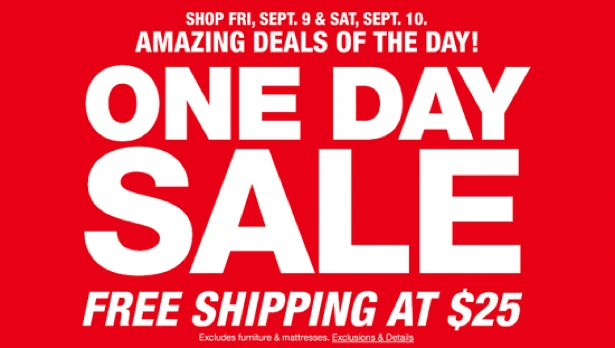
15. Results
‘Results’ plays on our desire for instant gratification. Seeing that the product or service promises fast results or even guaranteed results, we sometimes can’t help but jump at the opportunity. It also helps to have proof of what a product or service can do for us, so we can better envision how it will improve our lives.
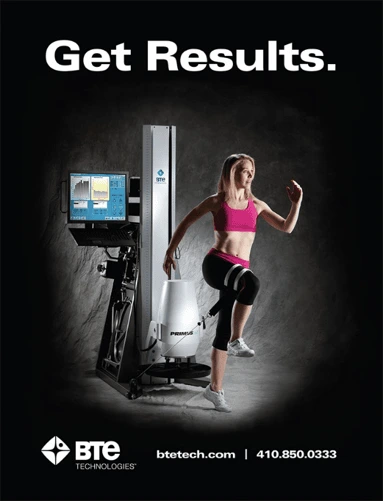
You may have seen all of these words used over and over again, yet they still retain their power. This is because our brains have learned to respond to these trigger words through social conditioning. We’re inclined to want more and higher quality at little to no cost, even if it seems unrealistic.
These trigger words might work in drawing customers in, but they won’t contribute to your brand’s longevity if they are only empty promises. To make the most of these words, use them sparingly and only when you can deliver exactly what you promise. That way, you’ll earn customer loyalty and a better reputation.
2017 was the year of digital marketing. Brands of every size depended on digital to raise awareness and win over their customers. As the year ended, digital marketers turned toward the future to strategize new plans and techniques.
Related: How to boost your brand identity with influencer marketing
Digital marketing is big, volatile and constantly evolving. While some experts believe this will be the year of AR and IoT, others see the market’s future as more complex. Let’s look at the top 10 trends currently dominating digital marketing in 2018.
Top digital marketing trends in 2018
1. AI might be the performer of the year
Yes, it’s true that AI is being adopted in nearly every consumer-facing industry today. But have you considered how AI could help your business on the backend? You know about chatbots and Siri, but what about using AI for trend analysis and customer profiling? This year, AI will help brands dig into the data, then reach their target audiences with more precision and effectiveness.
2. 2018 is seeing more video ads
According to recent reports, video marketing is set to capture about 82% of the internet’s traffic by the end of 2019. You can expect to see more video ads on all web platforms, especially social media. What may change is the duration and content of the videos as brands compete to hold viewers’ attention.
3. IoT is being used like never before
2017 saw the emergence of numerous products and applications for IoT, and its scale continues to grow. Together, IoT and data are expected to revolutionize industries like healthcare, education and manufacturing. They’re not only improving the efficiency of these sectors-they’re changing the very way these businesses perform their work.
4. Mobile marketing won’t flinch
After several delays, Google is soon expected to release its mobile-first algorithm. What remains to be seen is how this mobile index will impact the search results. It’ll no longer be enough to have an SEO-optimized site—or even just a “mobile-friendly” site. Google will examine the mobile performance of your website (and all of your competitors’) and rank you accordingly. Regardless of the devices your customers use, mobile compatibility is going to take precedence if you want to retain your search rankings.
5. AR could take the lead over VR
Despite the grand predictions, VR and AR haven’t impressed the general public much in the last two years. However, analysts predict that 2018 will bring major changes to the field of augmented reality. Since Apple has released its ARKit for app development, developers have been testing the limits and publishing some incredible new apps. It’s anyone’s guess as to which ones will catapult AR to the top.
6. Content marketing is going visual
The basis of any form of digital marketing is, essentially, content. However, the nature of content marketing is shifting based on the expectation that content is going mobile. There’s also a trend towards visual content as people have started engaging more with videos, images, data visualization, and infographics.
7. SEO is going mobile
As we already pointed out, simply having an SEO-optimized website might not work wonders for you this year. With Google shifting to the mobile-first algorithm, your SEO’s website auditing checklist is going through a revamp. On top of all the other signals Google likes to see, brands should re-examine their websites and get them optimized for mobile viewing now—rather than waiting to take a hit later.
8. Dark social offers new opportunities
It’s estimated that about 70% of social sharing is classified as “dark social.” This includes links shared on native mobile apps, via email messages, and in chat conversations (like WhatsApp or Slack). Though marketers don’t have perfect visibility into this data, it’s becoming easier to track. Brands are taking advantage of this by targeting audiences with ads, 1:1 messages, and chatbot experiences.
9. Advertising is exploring the blockchain
It’s not just for Bitcoin anymore. Today, the blockchain is offering new ways to track and verify online advertising. Imagine being able to verify each time an ad is consumed and for what duration—and then compensate the consumer for their time and attention. The blockchain can prevent ads from being over-served, ensure that influencers have real followers instead of bots, and verify voting for sponsored contests. Expect blockchain to take on more roles as the technology is adopted.
10. Dedicated apps are on the rise
Dedicated apps offer the benefits of a mobile-optimized website in a more convenient, accessible format. With Google’s app-indexing, brands are investing more in app development and discoverability. Often, these apps provide a better brand experience. Though apps have a long way to go before replacing websites, the love for apps is driving their growth and adoption.
These are some of the top trends driving digital marketing in 2018. As the year unfolds, we’ll see which ones rise to the top… and which ones fall to the wayside.
How many advertisements do you remember fondly? Probably not that many, considering we’re bombarded with content on a daily basis.
But the ones you do remember seem to creep into your subconscious. It’s like a catchy song that you can’t help but remember.
Good visual content has a lot to do with psychology. Appealing to human emotions will influence people to react to your ad a certain way.
Related: 4 ways to increase conversions with visual content
Corporate Executive Board did a survey on this in partnership with Google. They contacted marketing leaders, vendors, consultants, and over 3,000 B2B buyers to understand the rise of emotion-driven content marketing.
In their report From Promotion to Emotion, it’s revealed that 86% of buyers believe that brands are all selling the same stuff. Unique value propositions are not turning out to be… not so unique. But, brands that connect with customers on an emotional level will see 2x more impact than those trying to sell based on functional value alone.
If you’d like to tap into that influence, here are 7 emotions that drive people to connect with brands—and real-world examples of each.
1. Urgency
Even when your customers want your product, they can still be hesitant. Maybe they feel like they can buy from you any time, so why spend money now? Later, they say, later.
This is when you need to infuse a bit of urgency. Add a timer or an expiration date in your email newsletter or video ad, and buyers will take the cue. No one wants to miss out on a good deal.
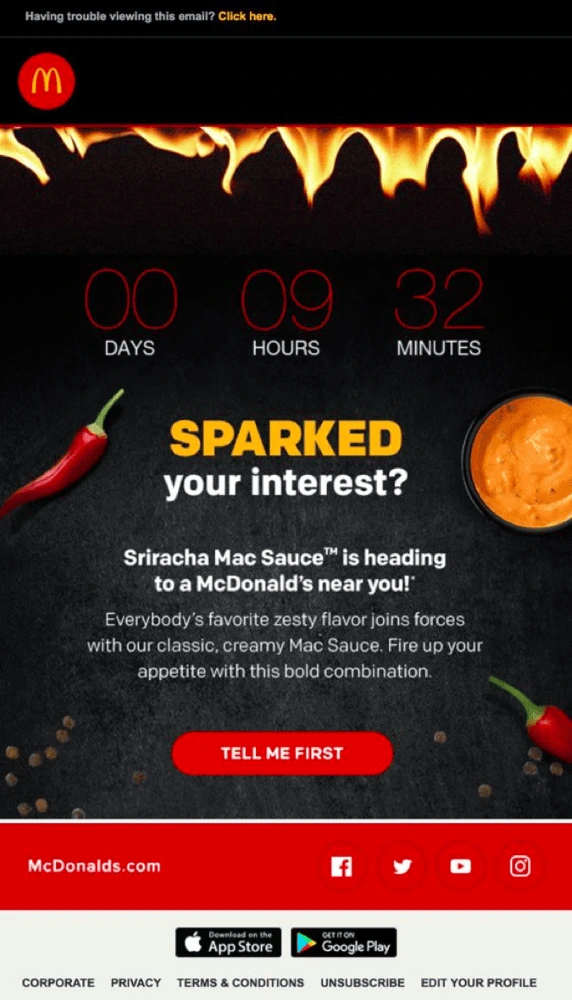
Source: McDonald’s
Big retail & e-commerce brands use urgency (tick-tock) to promote instant consumer action or purchase decisions. However, make sure you have a good reason for incorporating urgency in your offer. For example, countdown timers are often used for festive occasions or limited product runs.
Urgency even works better when you pair it with scarcity. Use phrases like “limited stocks available,” “limited tickets,” or “first come first serve.”
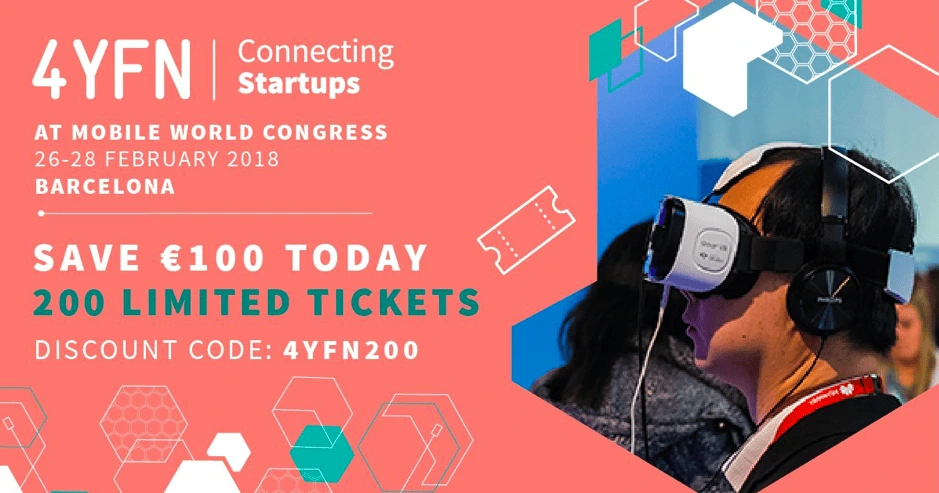
Source: 4YFN
A similar psychological catalyst is FOMO. Fear of missing out is a social worry that if you don’t participate in time, you won’t be able to enjoy the same rewards other people are reaping. One study reveals that around 69% of millennials experience FOMO when they can’t attend a popular event. You can use that fear to your advantage.
2. Desire
Desire is a powerful emotion. Almost every action we take and purchase we make is driven by desire. Many brands channel desires into their visual ads to capture an audience’s interest.
One way to do this is through before-and-after images. Olay took this concept even further with their “Identical Twins” campaign, where one of the twins uses the product and the other does not.
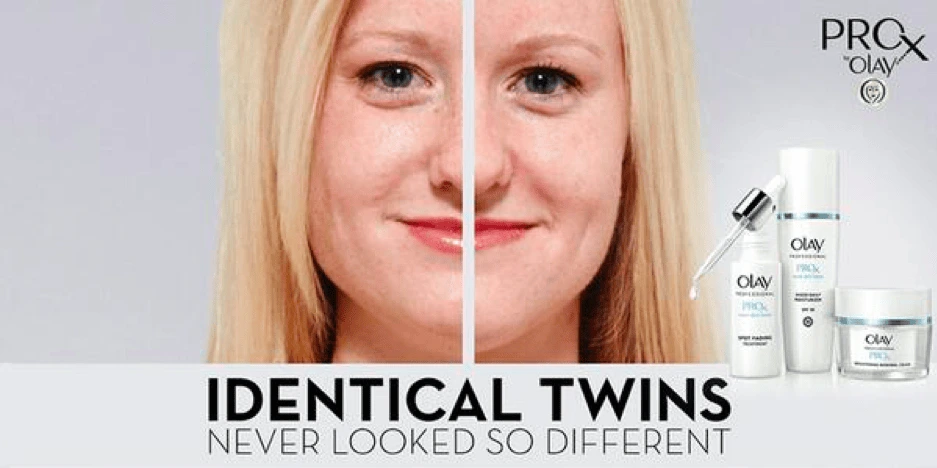
Source: Olay
But, before-and-after images don’t have to be about skin care or weight loss products. Check out this GIF, for example. SiteFlood creatively uses the before-and-after concept to show prospects what kind of results their service delivers.
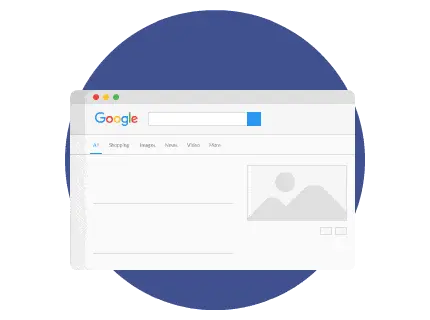
Source: SiteFlood
Similarly, most explainer videos use a “problem-and-solution” format to identify prospects’ needs, then provide a solution to help them fulfill that desire. This video explores the desire to live in the Caribbean, the problems one faces to achieve this, and the solution.
At Lucidpress, we used the same animated format to introduce our brand management platform—complete with white knights, bodyguards and Mama bears.
3. Compassion
We’re social creatures, and that’s frequently reflected in our behaviors and reactions. We care about our family, our friends, and even random strangers. Doing something for others makes us feel good.
Thai Life Insurance produced a series of heart-warming videos that showcase the sentiments of altruism and care, even in adversity. In the end, it’s wrapped up nicely as part of the brand message.
Attaching your brand to feelings of love, care, attachment, altruism and charity can give your visual content a strong emotional pull.
4. Delight
Humor provides more delight than almost any other emotion, but it can be difficult to pin down and execute well. You must know your audience and their sensibilities, so you don’t end up missing the mark, falling flat, or even offending them instead of making them laugh.
Old Spice has perfected the art of appealing to its demographic in a variety of fast-paced, cinematic ad campaigns. It’s delightful, humorous and exciting to watch.
5. Personal care
Advertising is everywhere, and it rarely feels like an ad is speaking directly to you. In this constant deluge of content, personalization is valued more and more. If you want my business, make me feel special. Show me that you care.
Starbucks is no more “special” than any other coffee brand, but they show their patrons that they care. It’s a brand synonymous with warmth, comfort and convenience, and it’s easy to make it your own.
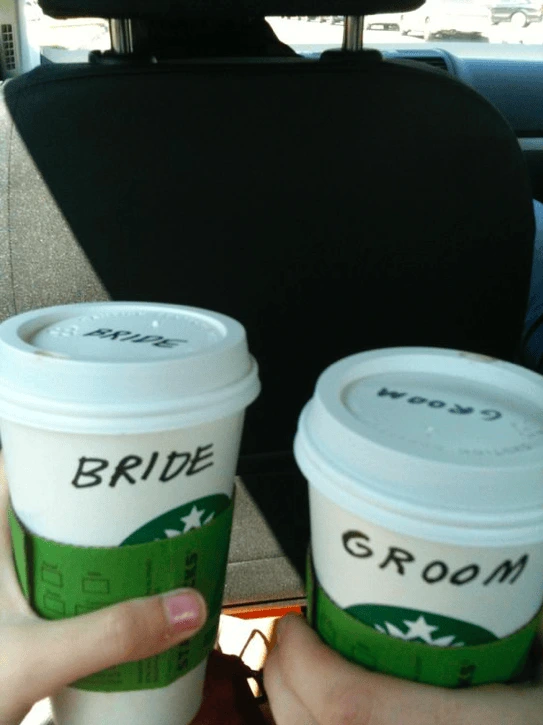
Source: Tumblr
Starbucks proves that it cares about the individual experience by providing a casual meeting space, a work environment, a place to relax, free Wi-Fi and other comforts. Perhaps more importantly, they ask each customer for their name and write it on every cup of brew they order.
In some ways, Starbucks has come to resemble a hospitality brand without actually being one, simply by extending a comforting personal touch.
Introducing customization or personal touches to your brand can make you far more appealing to your audience, because they will feel special and cared for.
6. Trust
Your customers have their own personal tastes, values and opinions. Likes and dislikes. Movies or music that they love or hate.
It turns out that personality will largely determine a customer’s shopping behavior. They buy products and experiences that either reinforce their personality or help them get closer to who they want to be.
So it stands to reason that if you associate your brand with a celebrity they like (or want to be like), that would give them a reason to trust in your brand and buy from you.

Source: Nike
This is why brands hire celebrities and influencers to drive brand awareness and adoption.
The idea here is to create an image your target customers will like or aspire to. Do some research on who your customers are (or who you want them to be). Once you’ve sketched out a buyer persona, including their likes and interests, you can solidify brand messaging that speaks to their personality and values—and earns their trust.
7. Motivation
Participating in social causes you believe in can be very gratifying. But, that gratification often comes from harrowing personal experiences, or at the very least, a visualization of others’ worst experiences.
CoorDown, an advocacy group for people with Down syndrome in Italy, made a beautifully profound video featuring people with Down syndrome delivering their own messages of reassurance to a future mother who’s worried about what kind of life her child will have.
The video is a rollercoaster of emotions that culminates in the promise of a happy, fulfilling life.
Find a cause that speaks to your brand values or to your employees. You can draw on personal experience or the hardships of others to create stories that inspire hope and motivation for your audience.
Key takeaway
Emotions are fundamental. You don’t need a PhD in psychology to figure out what makes people tick. You just have to do some research on your buyers. Draw up a buyer persona, then create visual content that will resonate with that audience.
Here’s the thing: the in-person experience isn’t dead. And furthermore, direct mail marketing isn’t dead. It’s an audacious statement for sure. But like the in-person shopping experience, direct mail marketing is just different. It’s not the norm anymore. But that’s what makes it all the more unique and effective.
That said, there’s no doubting that online marketing has taken the world by storm. Not only is online video consumption reigning supreme over traditional TV viewership, but it seems the world has gone mad for — and forgot about — the value still held in offline marketing.
Direct mail marketing happens to be an excellent example of offline marketing. Think of direct mail marketing as you would letters, postcards and brochures landing right in the mailbox of your ideal customer. That’s pretty spiffy!
What is direct mail? Direct mail is a form of direct marketing where promotional materials are sent to prospective customers in the mail.
Related: Building a local brand—5 essential things to know
Your mailbox — you know, the metal one with your address on it — has a bad reputation. Meanwhile, your email delivers discount codes for your favorite shops and other exciting tidbits of information. But that IRL-mailbox space is filled with bills, junk mail, earwigs and who-knows-what-else, right?
Sometimes, but not always.
While you’re certainly bound to receive bills, junk mail and find the occasional earwig in your mailbox, you can also count on uncovering letters from family members or collateral that’s seemingly custom-fit for your needs. It’s almost as if those ads you’ve been seeing all over social media popped up in your mailbox, which is pretty cool, right? That’s what direct mail marketing has the capacity to do.
So, what can direct mail marketing offer that online marketing can’t?
Direct mail marketing gives customers a tactile, interactive experience that they (perhaps unknowingly) crave and miss when they get a coupon emailed to them or when they are bombarded with an ad on social media.
But direct mail marketing doesn’t stop there — it delivers three other noteworthy factors.
Direct mail marketing is easy to understand
One reason direct mail marketing is more effective is because it’s easier to understand. One study found it takes 21% less cognitive effort to process, meaning your audience (or prospective customer) don’t have to invest time or extra brainpower into your postcard, mailer or any other type of direct mail marketing campaign.
The success of any marketing campaign — whether it be direct mail marketing or an online campaign— is contingent on whether or not it resonates with your customers. Because, if your target audience is finding the content difficult to understand, or if they feel confused or lost at any point in the content journey (or hile reading the collateral), your campaign is unlikely to meet success objectives.
Direct mail marketing feels more memorable
Forgive us for being a tad melancholic, but, there’s something incredibly heartening about receiving a letter or a package in the mail. It feels very human — as if there’s another person on the other end of the care package or neatly tucked behind the envelope. Someone had to go to the effort to writing said letter or find knick knacks to stuff into a box. You remember mail — along with the person who sent it and why they sent it along.
Plus, studies show that millennials who spend more time with a physical ad in hand have a stronger emotional response to the marketing campaign, lending a stronger overall memory of the ad. Who knows, you could be on the list of the next generation’s most-loved advertising campaigns by optimizing your use of direct mail.
Direct mail marketing has stronger response rate
Direct mail has a better response rate than email marketing, with 4.4% of campaigns receiving a response when delivered through the mail, compared to just 0.12% online. []
For example, for content (in a campaign) that’s delivered to 1,000 people, 43 more people will interact with your direct mail than your emails.
As in, you’re missing out if you push your entire marketing budget into email — especially when direct mail can be more cost-effective.
The Do’s and Don’ts of direct mail marketing
Want to stand out from the crowd and make sure you pull off a marketing campaign that drives a high ROI? Here are three tips.
DO proof your stuff
Typos or misspelled names are a surefireway to undermine your authority or make a customer doubt what you have to bring to the table. Proofread your stuff before sending it out. And make sure you get the customer’s name right.
DO have fun — Get creative
Get creative with you direct mail marketing campaigns! Don’t just fire off a boring letter that could get mixed up with a prospective customer’s bills. You want to create something memorable — something that familiar or maybe even something nobody has seen before. Don’t be afraid to throw a proverbial party in their mailbox!
You can do this by sending:
- Foldable origami
- Customized postcard designs
- Interactive letters, where your audience needs to do something to reveal a message
A fantastic example of creative direct mail marketing comes from the team behind World Water Day’s campaign. Their aim was to raise awareness about the event, but they opted to create a direct mail with words that only became visible when soaked in water.
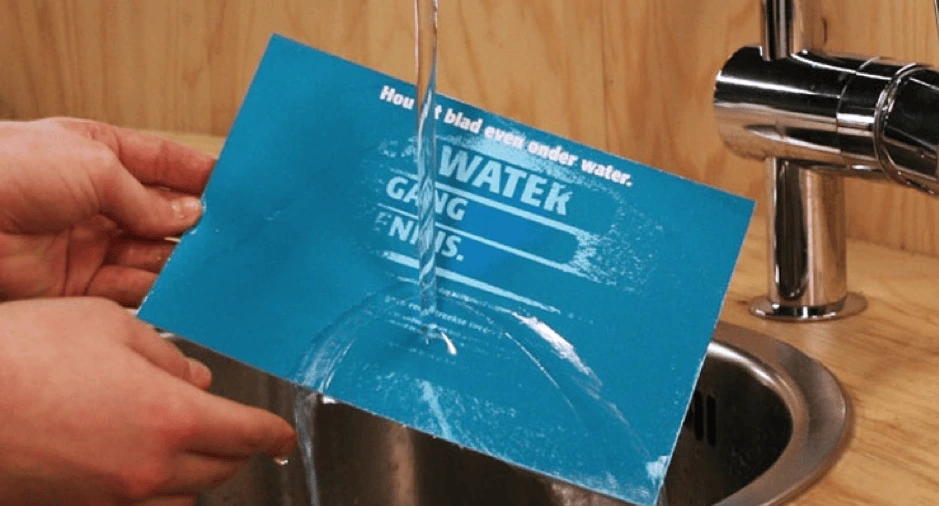
Not only did this direct mail campaign explain World Water Day’s campaign aim creatively, it also became an interactive piece of content. Interactive content has been proven to generate 2x more conversions than the alternative. That’s pretty genius, right?
Lucidpress: Click the image to use the template
Use one of our direct mail templates as inspiration for your own direct mail piece. Switch out colors, fonts and texts to create your direct mail postcard or flyer in seconds.
Browse all direct mail templates



DO emotionally engage customers
The second way to ensure your direct mail marketing campaign is a success is to make your audience feel something — any type of emotion. After all, there’s such a wide range of them. Emotion has been the marketer’s secret weapon for years. Various studies show that people rely on emotions, not just logical information or data, to make buying decisions.
Feelings of anger, disgust, affirmation and fear often top the list of emotions that work well in advertising.
A fantastic example of this comes from the Natural History Museum. In an attempt to educate local people about the danger of animal extinction, they sent an eraser to their audience with a quote about the topic.

Because their audience could see a visual representation of extinction in their daily lives, it made them stop to think about how serious it is… and want to act.
Pick an emotion and drive it home through your next direct mail campaign. You’ll soon see the impact emotion has on marketing—but the victories will be for your own brand.
DO put your own spin on it
For the most part, mailboxes aren’t fun environments. Bills, bank statements and lonely newspapers often clog up the mailbox marketing route. But, you can stand out by making your direct mail marketing campaign a little unique.
A fantastic way to achieve a little uniqueness is through juxtaposition. Can you think of a smart, innovative way to show how powerful your offering is by comparing it to something completely different?
Let’s take this direct mail campaign for example. Created by the theatre team behind a local performance of Macbeth, they wanted people to visit their show. Instead of online marketing, they exploited their direct mail opportunity and found a way to stand out in a mailbox.
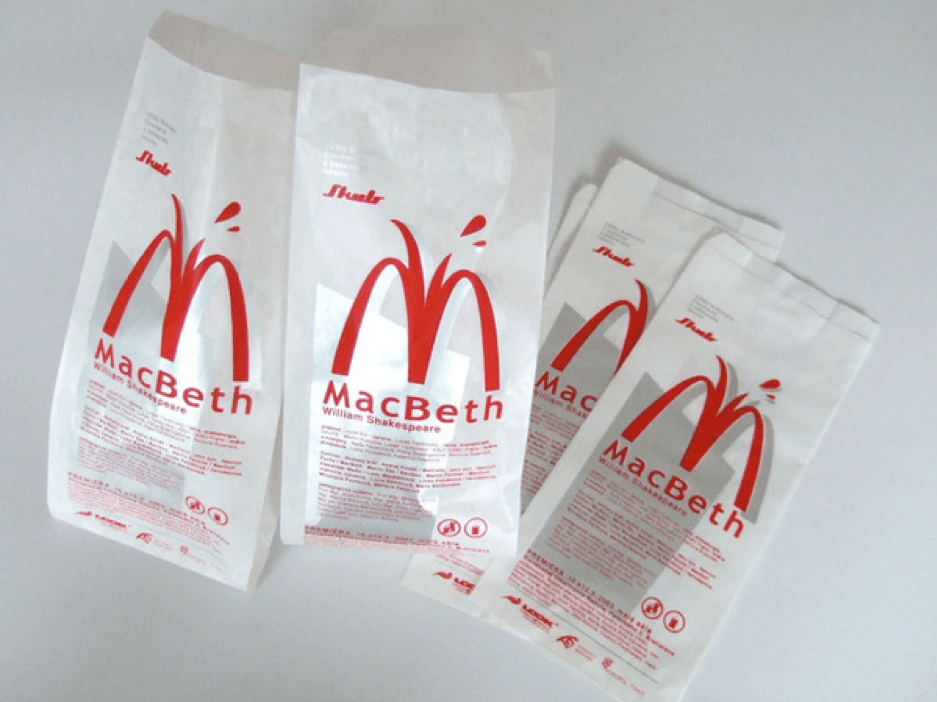
You’d probably never compare a Shakespeare play to a fast food joint, right? But that’s part of the reason why it works.
The juxtaposition of both elements makes you take a second take at the direct mail rather than toss it in the trash. This type of content experience (within direct mail marketing) is bound to make an impact on an audience, one who possibly has an interest in both but would never expect them to be paired together.
All in all, direct marketing provides you or your creative team with untold opportunities to lean into the creative, get weird and try new things. Plus direct mail marketing allows you to access new customers or get a feel for a prospective audience who might otherwise pass up your product or services.
DON’T skip doing the proverbial “leg day”
Leg day for direct mailing entails defining your audience and running some tests before you send out the direct mailers. Now, neither task needs to be a heavy lift. Defining your audience can be as simple as knowing who your product is best suited for and tailoring where and what neighborhoods you send the direct mail to based on this information.
Additionally, try sending a few flyers or direct mailers out to a small segment of your target audience. Make sure to include trackable tests, like a QR code or a custom URL (which we’ll touch on more momentarily).
DON’T forget to set goals for the campaign
Consider the following questions. As in, are you looking to drive brand awareness or boost sales of a particular product? Are you looking to assess brand awareness, and if so, how will you measure success or failture? Alternatively, if you want to increase sales, what is the target revenue or fiscal marker for your campaign? Specific goals will give you a benchmark to measure (and brag about) the campaign’s success, and it will help you drive improvement based on the results.
DON’T ignore the importance of a CTA
Simply put: You need a way to measure your goals and attribute which-sales-to-what-campaign-directive. Well, a CTA can help with that. Start by creating a custom URL to include in your direct mailer. This custom URL will empower you to track visits and sales from the website location, allowing you to attribute conversion and ROI to your direct mail campaign.
DON’T spam your customers
Inundating your customers with a lot of direct mail, emails and more is not the best way to get their attention. Sure, you’ll be top of mind, but it’ll be because you’re irritating them — not inspiring them or addressing a pain point. You don’t want to undermine the relationship you’ve worked so hard to build with them, so be mindful of who-you-send-what-where-and-when.
You’ve got mail — Lucidpress mail
If you couldn’t tell already, we’re big fans of direct mail. Now, the exciting part about Lucidpress is that we don’t just empower anyone to create compelling, effective content — we also make it easy to conduct a direct mail marketing campaign.
Choose from any of our direct mail marketing templates to customize and edit. Or, alternatively, if you’re feeling brave, you have the option to design your own. Then, all you’ll need to do is:
- Upload a .CSV file containing the details of people you’d like to target,
- OR use radial search to select a local delivery area.
Once selected, press the proverbial “go” button and use the direct mail marketing integration to send your mail directly within a matter of days. There’s no need to stop at your local post office with oodles of mail, thus, taking the stress out of building a direct mail marketing campaign.
As you can see, direct mail isn’t an old-school marketing technique that should’ve stayed in the 00’s. These tips, along with our new features, could be the combination you need to build a direct marketing campaign that drives excellent results for your business.
Learn more about the direct mail features in Lucidpress, and give it a test drive.
Bonus: Direct mail infographic
Craving more data? Check out this illustrative infographic about direct mail from our friends at Colourfast.

When you run your own business, you’re responsible for a lot. Aside from keeping the business running smoothly, you’re responsible for producing your product or service, hiring employees, marketing and managing your brand, and doing anything else your business requires.
Related: Direct mail marketing: Does it still work?
Today, let’s focus on the marketing aspect of your business.
In this article, we’ll focus on one type of direct marketing known as direct mail. Specifically, we’ll offer 10 suggestions for how to implement direct mail in innovative and creative ways. To start, let’s take a look at exactly what direct marketing and direct mail is.
What are direct marketing and direct mail?
Direct marketing is an assertive form of promotion in which a company reaches out directly to its target market. The point of these campaigns is to connect with consumers on an individual level, showing that they’re important to the company.
One example of this is telemarketer calls. Some other types of direct marketing:
- Email marketing
- Direct mail marketing
- Direct-response advertising
- Face-to-face selling
- Text marketing
- Distributed leaflets & flyers
Our focus today is direct mail—where advertising content is sent directly to a target market’s mailbox. The content could include letters, postcards, flyers, or anything mailed directly to a home or place of business.
Is direct mail still effective?
When you use direct mail correctly, it can be an extremely helpful tool in your advertising toolbox. You can “speak” directly to your audience and give them detailed information about your brand. In addition, you can easily track the success of a campaign.
However, you must practice care when you’re conducting these campaigns.
If you do this incorrectly, consumers will view the content as “junk mail.” Avoid this by providing consumers with content that is timely, relevant and important to them. You can also provide useful tools—for example, a coupon or promo code for your services.
How to use direct mail creatively
Now that we know what direct mail is and the benefits it can bring you, let’s brainstorm a few ways to use it for your brand. Below, we’ve gathered 10 innovative ways that you can use direct mail for your business.
1. Deliver discounts
One common-sense choice for direct mail marketing is to send out info about discounts and specials. This could mean one of two things. First, you could send out direct mail when you have a sale coming up.
Second, you could send out coupons for your service that are exclusive to your direct mail campaign. This is a good way to measure response and ROI, because you’ll know whenever a customer redeems the discount.
2. Send out samples
In addition to sending out discounts, you can send out samples to your customers. Of course, you should only do this if you have ample budget for the expense. It’s probably not the best tactic to use for your first campaign, but after you’ve gotten a handle on typical response rates.
If you can swing it, samples are a great way to attract new customers who don’t want to pay money to try out your product. In addition, if you have new products, samples are a great way to introduce current customers to your new products.
3. Offer reminders
Reminders are a cheap way to stay top-of-mind. You can send out reminders for upcoming events—for example, a realtor could announce an open house. You could also call attention to grand openings, deadlines or appointments. An example you’re probably already familiar with is receiving a letter from your doctor or dentist about your yearly check-up.
4. Share announcements
You can also use direct mail to deliver company announcements. This keeps your customers up-to-date on new developments such as different hours, new contact info, new products and more.
5. Use QR codes
QR (quick response) codes are a great way to connect your mail campaigns to your digital marketing efforts. They’re simple barcodes that are easy to print on a piece of mail and can be scanned by any smartphone.
One scan, and a QR code can be customized to take your customer anywhere you need. For example, you could design a QR code to take your customers to a specific landing page. Most people are familiar with QR codes these days, so their presence on your mail will be self-explanatory and easy to follow.
6. Add texture
When someone goes through their mail, the last thing you want is for yours to be immediately disregarded or tossed away as junk. One way to combat this is to make your mail more eye-catching than the rest.
There are a few ways to do this, but one of the easiest is to add some texture to your mail. For example, you can use embossed lettering to make it stand out when a customer grabs a handful of letters and newspapers.
7. Pop with 3D mailers
Using texture is a subtle way of differentiating your mail, but there is a more obvious way to set your mail apart. You can send out 3D mailers, such as a box or tube or any other 3D design. These will jump out to customers and spike their curiosity, prompting them to open your mail and take a look rather than just throwing it away.
8. Track personalized URLs
One way to track how well your direct mail is working is to use personalized URLs (PURLs). Like QR codes, they’re a digital extension of your message. PURLs will lead your customers to your website in a way that leaves a trackable footprint. You’ll easily be able to see how many of your customers responded to your direct mail campaign by checking the page’s stats.
9. Try augmented reality
When people think of augmented reality today, they think about games like Pokémon GO. However, augmented reality does have a place outside of entertainment. In fact, you can incorporate the idea of augmented reality into your direct mailing.
Usually, this is done through the use of an app. For example, in 2015, Toys R Us used augmented reality techniques to create a game out of a piece of their direct mail.
10. Wow with video in-print
Finally, there are video in-print techniques. This is a cool idea because it eliminates the middlemen (apps, websites, etc.) by including a video player directly in the mail. Right now, these are a bit pricey—but keep an eye on them for the future.
Key takeaway
When executed creatively, direct mail marketing can provide a huge boost to your promotions and brand awareness. Whether your goal is to be top-of-mind or to drive bottom-funnel sales, you can build a direct marketing campaign to match. By crafting professionally designed mailers, you’ll attract your target audience and reinforce loyalty among your customers.
Learn more about the new direct mail features in Lucidpress, and give it a test drive.
Three years ago, Gartner predicted that 30% of our interactions with technology today would happen via conversations with smart machines—and mainstream adoption would be just around the corner.
Related: 10 digital trends that are transforming marketing in 2018
We can see the evidence of this change all around us, from Siri and Cortana to Alexa and Google Home. And while we haven’t reached mainstream adoption quite yet, marketers shouldn’t wait for the masses to catch up before grappling with the implications of voice search.
In particular, voice search represents a move from the abstract to the physical. Certain aspects of your brand—voice, tone, personality—will soon become real in ways they never have before. Just like mass marketing has shifted into digital marketing, we’re now seeing the dawn of conversational marketing with voice search. Here are five factors that show how voice search will impact your brand.
1. Copy that can be read aloud
As more people turn to smart machines to ask questions, brands should be prepared to respond in kind. Creatives will have to write copy that sounds good when read out loud—often in the form of answering a question. Offer the most important information first (remember the inverted pyramid?), and for goodness sakes, keep it brief and unambiguous.
For example, in an older blog post of ours, we discuss the definition of branding. If someone were to ask “What is branding?” today, our blog post would respond like this:
To begin to understand what a brand is, you must first understand that your brand does not exist in your marketing department, your public relations team, or your CEO’s office…
And as pretty as it looks on the page, no one is going to stick around to listen to that. Instead, our response should get straight to the point. Again, from the post:
A brand is the sum total of all the impressions a customer has, based on every interaction they have had with you, your company and your products.
If we wanted to optimize this content for voice search, we could restructure it intelligently by putting the important data first. Then, we have plenty of space for the kind of writing that’s meant to be read rather than spoken aloud.
Finally, keep in mind that voice search is more conversational than traditional search. The queries are longer, and they’re often localized (e.g. “What’s the weather like today?” or “When does The Copper Onion close tonight?”). Your responses should follow suit, mimicking how real people talk (including conversational phrases).
2. New advertising rules
With new advertising mediums come new advertising guidelines. This doesn’t just mean best practices, like we see with paid and organic digital search. We’ll also see big players in voice search (like Google) establishing new rules for brands who want in.
Remember this voice ad from Burger King last year? The commercial was designed to hijack your Google Home device by asking “What is the Whopper burger?” This request prompts devices to begin reading the Wikipedia entry for the Whopper—which, of course, Burger King had edited to their benefit.
The Whopper is a burger, consisting of a flame-grilled patty made with 100 percent beef with no preservatives or fillers, topped with sliced tomatoes, onions, lettuce, pickles, ketchup, and mayonnaise, served on a sesame-seed bun.
Oh, be quiet, already!
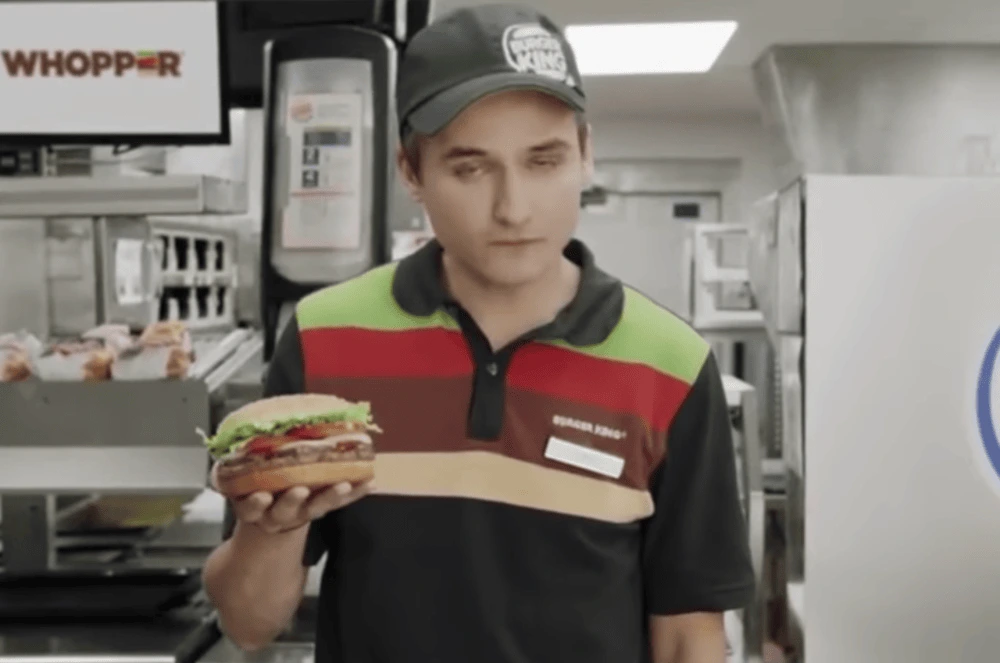
My feelings exactly.
Not only did this violate Wikipedia’s terms because it so clearly sounds like ad copy, it also left open the door to vandalism. People were quick to edit the Wikipedia entry to include phrases like “cancer-causing” and ingredients like “toenail clippings.” Not exactly what the fine folks at Burger King had in mind.
Even when the ad worked as intended, people were annoyed by the tactic—but online trolls had made it so, so much worse. It should come as no surprise that Google shut down the ad 3 hours later, and Burger King pulled it entirely.
Consumers aren’t used to advertising in voice search yet. Take care not to annoy them with lengthy descriptions or aggressive sales pitches—and follow the terms and guidelines of the services you use.
3. What does my brand sound like?
Today, Alexa always sounds like Alexa, but it’s not hard to imagine a future where voice search becomes highly customized. Brands will be able to choose their own vocal characteristics, which opens up a world of questions and considerations.
If your brand was a real person, what would they sound like? How would you determine:
- Gender
- Age
- Language or dialect
- Accent
- Conversational tone
- Conversational speed
- Personality

Source: Pexels
Some of these characteristics even raise ethical considerations—like gender, for example. According to OnBrand’s State of Branding report, 54% of marketers prefer a female voice assistant (while only 17% prefer a male). Nearly all the voice assistants we’re familiar with today default to female voices, which raises the question why.
“The simplest explanation is that people are conditioned to expect women, not men, to be in administrative roles—and that the makers of digital assistants are influenced by these social expectations,” says Adrienne Lafrance in an article for The Atlantic. Power structures influence our technology all the time, and it’s important for brands to consider these traits (and their impact) carefully.
In the mean time, it’s likely that female voices will continue to answer most consumers’ vocal commands. How can masculine brands compensate for this—punch up their language, perhaps?
4. Consistency matters
Voice search does not alter the impact of brand consistency, but it does present new channels to manage. Once you’ve decided what your brand sounds like, it’s important to convey that across all channels and communication. Voice and tone need to remain consistent for the brand to be distinct and recognizable.
After you’ve set the tone and refined your brand voice, go back and make sure it’s reflected everywhere:
- Voice-optimized content on webpages (especially Q&A format)
- Voice-optimized ad copy
- Product descriptions
- Social media posts (hashtags & emoji don’t always translate)
- Program dialog
- Chatbot dialog
Interesting note about chatbots: If your brand already has one, you might be ahead of the game. Because chatbots are designed to be conversational, they can help to inform your strategy for voice search. Look to them for guidance as you explore this brave new world!
5. First-mover advantages
And now, the good news. Because voice search has yet to reach mass adoption, there’s still plenty of time to move into the space before other brands catch up. It’s a rare opportunity to reap first-mover advantages without being one of the big, established brands.
“Given that many people are currently rather disappointed with their voice search interactions, the first brand to create a genuinely standout experience is going to garner a lot of excitement,” says Rob Curran in this article for Campaign. And like we’ve seen with other new mediums like augmented reality, it’s only a matter of time before someone does. Could it be you?
Key takeaway
Equal parts scary and exciting, the adoption of voice search represents enormous opportunity for savvy marketers. With it, you can deliver a digital brand experience that’s more personal and human-like than ever before—and hopefully, one that’s consistent with your brand messaging. Drive the conversation and address these factors now to enjoy the benefits while we head into the next decade.
Want to know more about the power of brand consistency? Download our free 32-page report, chock full of stats & great insights.
Bonus: Voice search infographic
Want to share these insights with your followers? We’ve adapted the main points of this article into a sharable infographic perfect for Facebook, Twitter, LinkedIn and Pinterest.
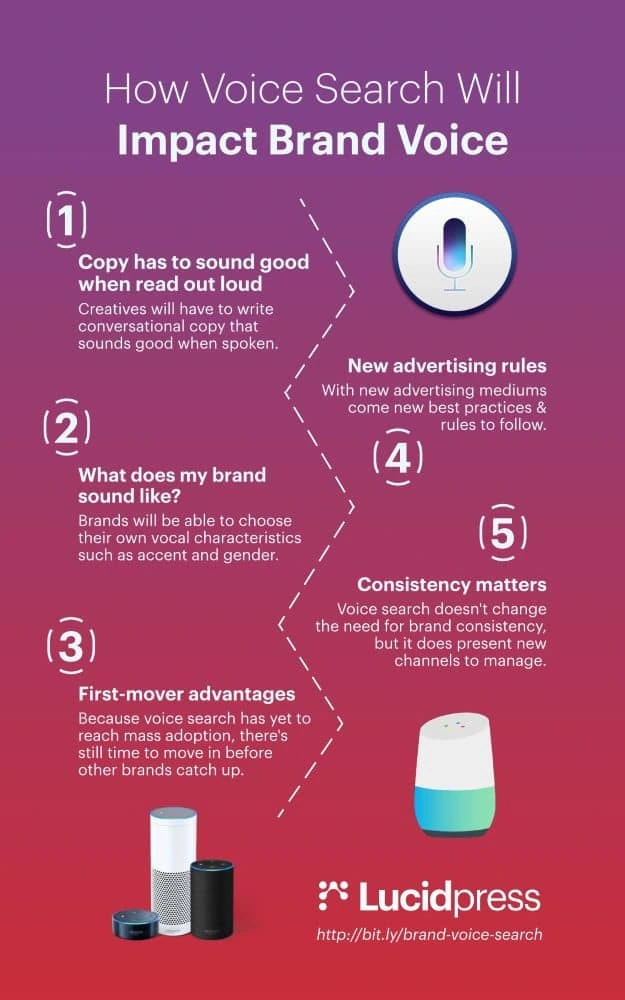
Direct marketing can be extremely effective for businesses focused on serving specific geographic areas. By sending letters, flyers, and other marketing materials straight to prospects’ homes or workplaces, you can generate business in a cost-effective manner.
Related: Direct mail: Does it still work?
Direct marketing (also known as direct response) is an umbrella term that includes email, online display ads, paid search, and direct mail. The common denominators are 1) they target specific people and 2) they ask for some type of action.
The requested action could be anything from giving you a call or redeeming a coupon to scheduling a free consultation or starting a trial membership. The possibilities are limited only by the marketer’s imagination.
In this post, we’ll focus mostly on the time-tested technique of direct mail, which remains very profitable for realtors, gym owners, franchisees, and other businesses focused on serving local communities.
How can you measure your performance?
Let’s discuss the key metrics of direct marketing campaigns. Understanding these is the first step to ensuring that your strategies are always improving.
Direct mail open rate
When most people get their mail for the day, the first thing they do is separate the “junk” pile from the stuff that deserves their attention. Getting our messages into the stuff-to-open pile is the first hurdle direct mailers must clear.
How often does this happen?
Unfortunately, because we aren’t in prospects’ homes or offices with them, this is a difficult metric to track. Paper mail is a different animal than an email campaign, for instance, because email marketing software allows us to track how often our messages are opened and clicked.
It’s unlikely you’ll know what your direct mail open rate is. That said, prospects can’t respond to a message they haven’t read, so we want to do everything we can to increase it. That’s why seasoned marketers test different variations of the same direct mail package. Seemingly subtle details—like the envelope color or the font of your prospect’s address—can make a significant impact.
By sending out two versions of the same marketing message (a process called A/B testing), you can track which version performs best. After enough testing, the winning version becomes the “control,” which you can test against newer variations. This ensures that you’re constantly optimizing your direct mail packages to get opened as much as possible.
Let’s say you’re a realtor looking to build your client base in a new neighborhood. You decide to send out 500 letters introducing yourself and asking for interested recipients to give you a call. Your message is the same in every letter, but the envelopes are different. 250 are white. The other 250 are yellow.
You get 13 calls from the white group, but only 6 from the yellow: a statistically significant result. We don’t know for sure how many people opened the envelopes, but because the response was so much higher with the white group, we can assume it’s the better option moving forward. Next campaign you might test it against another color, like light blue.
Direct mail response rate
The response rate measures how many prospects follow up after seeing your messages.
A response isn’t necessarily the same thing as a sale. It often will be if you’re selling inexpensive impulse items, like a pizza store owner mailing out coupons. In those cases, responding (using the coupon) is the same thing as becoming a customer. But that isn’t always the case with more expensive products (like real estate), when people might respond before they’re ready to buy.
How do you measure this?
The challenge becomes figuring out which prospects responded due to your direct mail as opposed to other marketing channels. Here are just a few strategies you could use to track response rates:
- Call tracking. Assign unique phone numbers to specific direct mail campaigns, so when prospects follow up you can see where they came from.
- Coupon or discount codes. You’ve probably seen these in your own mailbox. Local businesses often create special coupons for direct mail campaigns. When prospects redeem them, it’s easy for the business owner to track their success.
- Exclusive offers. You could create special offers exclusive for direct mail recipients, so you know they couldn’t have discovered them anywhere else.
- Personalized URLs. A tech-savvy way to track responses is to have direct mail recipients follow links to unique landing pages you’ve created for the campaign.
- Just ask. Businesses often ask new customers how they heard about them, collecting responses via informal surveys.
Don’t worry if your response rate seems low. In 2017, the Data & Marketing Association’s Response Rate Report found that the average response rates sent to houses was about 5.1%. The same report revealed that oversized envelopes had the highest response rates, probably because they stand out from the pile.
Imagine you own a hamburger restaurant. You decide to send out coupons to promote your new curly fries. You send out 2,500 coupons, and 175 people end up redeeming them. What’s your response rate?
The formula is simple. All you have to do is divide the responses by the total pieces sent. In our burger example that turns out to be 7%—a great response!
ROI
Direct marketing can be extremely profitable, but there are certainly still costs involved. Everything from accessing mailing lists and databases to printing services, postage and the paper itself—these things add up.
Your marketing budget is limited. Tracking your results will ensure you’re allocating every penny where it’s most effective.
That’s where ROI comes in. This acronym, which stands for “return on investment,” assesses the revenue your campaign brings in relative to its cost. It’s probably the most important metric to pay attention to because you can compare it with the results from other marketing efforts.
Say you’re a gym owner offering a great deal for a new membership. You spend $6,000 on your direct mail campaign, which results in $7,800 of new business. You want to know your ROI.
The formula to calculate ROI is as follows: (revenue – campaign cost) / campaign cost. So, in our example, we get (7800 – 6000) / 6000, a very respectable 30%.
Your turn
Although many small business owners are overlooking direct marketing in 2019, it remains a viable strategy for businesses targeting local areas. You might use email, direct mail, pay-per-click, or all of the above.
Understanding the key metrics will help you see how well your campaigns are paying off. Continuing to track them while you experiment with messaging will ensure they’re as profitable as possible.
Learn more about the direct mail marketing service in Lucidpress, and give it a test drive.
Are you emotionally connected to a particular brand? Maybe it’s the design of its packaging. Maybe it’s the colors they use or the shapes that remind you of something good. Maybe it’s the smell of the store. When you go into a small fragrance boutique, you’re mesmerized by a unique scent that sticks in your memory. Whenever you decide to buy perfume in future, you’ll prefer going to that specific store.
Why does this happen? When you understand the psychological theory behind the human senses, you’ll realize why sensory marketing is so important. Our senses are our connection to the outside world. Our brain interprets the messages they send and forms its perception of the world in accordance with those interpretations.
Related: The subtle art of using emotion in your visual content
Marketers can implement sensory experiences to make their campaigns more effective. With sensory marketing techniques, you lay the foundation for a positive brand impression. Let’s see how our senses influence our perception of a brand, so we’ll understand this approach a bit better.
1. Taste
Unless you own a restaurant or coffee shop, this is the sense you can influence the least. However, taste can still become an important aspect of your marketing strategy. For example, if you’re promoting an Italian brand of jewelry, you could organize a cocktail for your most faithful customers where you serve Italian gelato and wine. These tastes will remind people of the Italian lifestyle, and they’ll see how your jewelry fits in.
The sense of taste can deeply influence our memories, emotions and moods. A savvy marketer will find ways to use that fact to the campaign’s advantage.
2. Sound
You already have experience with sound affecting your perception of a brand. When you dine in a fancy restaurant, you want slow, calm music in the background, right? When you’re at a nightclub, the music that’s being played affects your experience. When you enter a store, the music can make you feel energized or relaxed, depending on the selection.
But it’s not limited to in-store experiences. Daniel Monroe of BestEssays explains how sounds are important even for online services: “The element of sound was crucial when we were designing the live chat. We didn’t want our website visitors to be disturbed, which is why the live chat is never activated without their request. When they drop us a message, however, they surely want to be notified when the agent sends a response, so the sound has to be noticeable yet subtle. It has to create a sense of urgency without making the website user nervous.”
Think: what behavior are you trying to encourage in your target audience? What kind of music would promote such behavior? Once you answer this question, it becomes easier to implement music and sound effectively in your brand experiences.
3. Touch
The sense of touch also influences our behavior. Research has shown that touching rough or smooth objects has an effect on our decisions. Hard surfaces, for example, evoke the impression of firmness, stability and security. However, they also impose a sense of strictness. They might be great for offices or banks, but you’d want to include a bit of softness in a store that sells products for kids, right?
Many brands neglect the sense of touch in their campaigns, mainly because they’re selling products that already have a particular structure. The way you design the packaging and space around the products, however, will have a huge effect on the brand experience.
4. Sight
This is probably the sense that affects our brand perception the most, since we first see a product before involving any other senses in the experience. That’s why brands invest so much effort and resource in visual content.
When you’re presenting your brand to the world, advertising and packaging have a huge impact on audience perception. This effect is heightened when all your branding is consistent and cohesive. Posters, social media posts, flyers, newsletters and other promotional materials should all share a similar design and color scheme. After all, those colors are rarely chosen by accident.
For example, when we’re trying to evoke optimism, warmth and clarity, we often reach for the color yellow. Orange is cheerful and fun (like Fanta), and red is bold and exciting (like Virgin). Blue evokes trust, strength and dependability—think Dell and HP. Green is peaceful and symbolizes growth and health, which is why you’ll find it in the logos and marketing of many environmentally friendly or healthy lifestyle brands.
5. Smell
Have you ever wondered why brands like L’Occitane and Lush sell their products in specialized boutiques? It’s because their marketing campaigns are based on the sense of smell, and they don’t want their scents being diluted by other products in the store. When you get to the Lush store, you’re so mesmerized by the smells that you simply cannot leave without a new bar of soap. That’s how powerful scents can be.
Even if your brand is not related to scents, you can still benefit from sensory marketing. Researchers found that the smell of chocolate can boost sales in bookstores. They observed the behavior of the customers and concluded that when the bookstore smelled like chocolate, people were more engaged with the staff and the books. They looked more closely at books, read the summaries, and lingered in the store. That’s not a coincidence.
The smell of chocolate is comforting and inviting. It’s no wonder why many real estate agents like to bake something in the kitchen before showing the property to a potential customer. They also make sure the property is clean and smells nice in every room.
Just as a pleasant scent promotes better behavior, an unpleasant odor will have a negative effect. If the store is dusty or smells funky, it won’t matter how awesome your brand and products are. The smell will distract visitors from taking the action you want to encourage.
Key takeaway
Our senses have a major impact on our purchasing decisions. Sensory branding is a well-established practice in some industries, such as cosmetics and food. However, brands from all other industries can benefit from this approach, too. Which sensory marketing techniques could you take advantage of in your next branding campaign?
Newcomers to the world of brand awareness marketing often feel overwhelmed or utterly lost. There’s a veritable plethora of channels, tactics & tools to explore. To make things even more difficult, some make much more sense for your business than others, depending on a matrix of circumstances.
Related: 7 things to consider before your next social media campaign
Before jumping into a brand awareness campaign, remember to ask yourself these key questions.
Is your content tailored to the right people?
You’re pretty sure you wrote compelling content… but is that actually the case? It’s time for a bit of self-reflection and honesty, which—while sometimes tough to swallow—is vital to the refocusing process.
One of the easiest mistakes to make in brand awareness campaigns is tailoring the content towards current customers. In reality, you’re targeting potential customers instead. []
The people you’re targeting likely have no idea who you are prior to seeing your ad. This is why the content has to be super compelling, either to draw them into visiting your site right away or ensuring that when they need a service or product like yours, you’re at the front of their mind.
The main things you need to include within the copy are:
- The unique selling points of your business—what makes you different from all of your competitors?
- How you can solve their problems—most consumers have some sort of problem (which is why they purchase services/products), so tell them how you can be the answer they’re looking for.
- A convincing call to action—whether this is telling them to visit your site, sign up for your newsletter or take advantage of a limited-time promotion or discount, tell people why they should act on their impulses now.
Put yourself in the shoes of your potential customers. What would you want to read? What would convince you to use your own product or service?
Marketers often forget to place themselves in the shoes of their target market and instead take a product-oriented approach.
Are you targeting the correct people?
Next, examine your target audience. Are you completely confident that you targeted the correct people? If your brand awareness campaign failed, then it’s possible you performed for the wrong audience.
Basing your target audience on your current customers seems like the place to start. They clearly love your brand, so people who share the same interests are your perfect target, right? Not necessarily.
In most cases, the audience you want to target is going to be slightly different. Before your current customer base found you, they were high-intent users actively searching for an answer to their problems.
In a brand awareness campaign, however, your audience isn’t likely to be high-intent when they first see your ads.
This is where you have to be creative; think about the types of people who may have pain points you can solve but don’t quite know it yet.
Think about the age range that’s most likely to face these pain points soon. Are there any geographical areas more likely to need your help? Are there any interests people have that could likely lead to needing you?
For example, if your brand specializes in decorating services, based on intent and life event options, you can target people who are moving soon or have recently moved. This would be more effective than simply targeting people who love decorating.
Are you tracking success correctly?
Finally, let’s review how you measure your brand awareness campaign’s success. You could run a hugely beneficial campaign, but if you’re focused on the wrong metrics, you may see it as a failure and not capitalize on it.
There are so many metrics you can use to gauge the success of a campaign that it can be difficult to know exactly what you should be looking for.
Success metrics should be chosen during the planning stage of your campaign, to give you a clear view of how the campaign should be structured and how you can get a sensible idea of the performance.
When you sit down to decide these metrics, use SMART goals and objectives. Many of you have probably already heard this acronym, but just in case, it stands for specific, measurable, attainable, realistic and timely.
Setting your goals this way will help you get an in-depth understanding of which metrics to evaluate when measuring the campaign’s success.
And when it comes to brand awareness campaigns, success can be harder to measure. Focus on top-of-funnel metrics rather than sales or conversions. When it’s over, don’t stop reporting just because the initial boost of traffic and engagement has died down. Remember that these campaigns can continue to pay off with gradual increases over time.
Common brand awareness mistakes
With so much on the line, you can’t afford to dive in unprepared. Here are 7 rookie mistakes that often fly under the radar yet profoundly impact your brand awareness strategies and goals.
Mistake #1: Scattergun approach
Spreading yourself too thin is an easy trap to fall into. You can’t please and cater to everyone—and you shouldn’t. In fact, attempting this futile endeavor will result in satisfying no one.
Case in point: many startups establish accounts on every social network they can, only to find that managing them all is virtually impossible. Even if you do post to every network with the help of automation, you’re not delivering a great experience tailored to that platform—and you’re likely missing out on a lot of engagement.
Instead, do your research to find a highly targeted market. Know who they are and understand their habits, wants & needs. You have to find where they are and spend time there, not in a hundred places where you desperately hope to stumble upon them.
Mistake #2: Passive social presence
A “build it and they will come” mentality does not work on today’s internet. You can’t just set up a website or social media page and hope to see customers eagerly interacting with your brand. First, you have to engage the audience. Responding to comments in a timely manner is a good place to start… but it’s only a start.
Come up with a content calendar and post on a regular basis. Talk to users and influencers, and ask them for opinions. Use your social presence to carry out customer service around the clock via instant messaging and other channels. Social media is about building lasting, meaningful connections that strengthen brand loyalty. You can’t simply stuff your messages with hashtags and expect magic to happen.
Mistake #3: Incoherent cross-channel strategy
Rookie marketers tend to lose sight of the big picture and how coherent their messages appear across different channels. This is not the way to build strong credibility and inspire trust. Successful brand marketing is deeply rooted in consistency.
This journey calls for much more than investing in a decent logo and slapping it everywhere you can. You will need to use elements like the color palette, fonts, visual identity, images, and voice to set the tone for your marketing campaigns. Tailor to the medium and the platform, of course—but never lose the integral pieces of your brand’s identity. [ ]
Mistake #4: Overcommitting to digital
Cost-effective digital platforms have unparalleled reach, but they are not be-all and end-all of brand marketing. Not everyone is tuned in to social media, apps and online search. Depending on your target market, you could work wonders with print collateral or merchandising.
In other words, you can let human psychology work to your advantage and leave a lasting impression by giving away branded office supplies, quality printed shirts, and other handouts. Don’t overlook the potential of printed media. You could reach a lot of people via brochures, business cards, flyers, newsletters, and other printed marketing materials. In the digital era, print is personal and memorable.
Mistake #5: Going all-in on advertising
Advertising is the mainstay of many brand awareness campaigns. However, it’s generally a bad idea to put all your eggs in one basket-especially if you’re a rookie who’s worried about wasting your budget.
What’s more, people have grown weary of aggressive pop-ups & ads, even when they’re targeted with laser-like precision. They install ad-blockers to completely shut them down.
Instead, try to start small and set aside a limited ad budget. Test your awareness campaigns over a course of few weeks and evaluate the results. Paid marketing works best when you prioritize ROI, so as you learn the ropes, gather data and scale your campaigns based on your insights.
Mistake #6: Misunderstanding content marketing
Viral marketing is one way to enter with a big bang, but directing all your efforts there is a double-edged sword. If you win, you win big. If you don’t, you get nothing. You’re probably better off crafting compelling, quality content on a consistent basis. Be entertaining, educational, and add value to people’s lives.
Once you start producing a stream of relevant content, you have to promote it. Bear in mind that you might not achieve immediate success. Don’t cut corners, and show patience. It takes time to gain momentum and traction. In due time, your efforts will start to snowball via word-of-mouth and social signals.
Mistake #7: Disregarding or copying the competition
It always pays off to scope out the competition. Doing this homework will show you what works for them—and what doesn’t. You gain valuable insights that help you set your brand apart. You should always keep an eye on what others are doing, but refrain from imitating them.
Looking and feeling like another business stirs brand confusion and slows the development of your own reputation. Instead, being genuine is the best way to win people over and keep them in your camp. That being said, you can still borrow good ideas and implement them in your marketing strategy. Just make sure you’re doing it in a way that’s fresh and authentic to your brand.
Key takeaway: Brand awareness by design
Effective brand awareness campaigns are hard to pull off. You have to put the right messages in the right place and serve it to the right people. Much easier said than done. There’s a lot of ground to cover without losing your footing and plenty of tools to consider.
Right away, put a sound strategy in place and let it guide your efforts across channels and platforms. Steer away from common mistakes that can bite off a big chunk of your budget and hinder your brand. Concentrate on turning curious visitors into prospects, prospects into customers, and customers into satisfied brand ambassadors.
Direct mail is not dead or in a cryogenic freeze. It has not joined the video cassette or the typewriter as an obsolete relic. Even here in the digital age, implementing a traditional direct mail campaign can still be a highly effective tool in your brand’s marketing toolbox.
Related: Direct mail marketing: Does it still work?
Engaging customers through multiple platforms & channels is the ticket for boosting your response rate. Direct mail is a path to success when it’s personalized to your target audience and driven by a well-executed direct marketing strategy.
So, what can set your direct mail campaign apart? Here are 5 effective practices you can implement to attract customers’ eyes (and dollars) to your business.
Personalize your content
Everyone wants to feel special. Taking an individualized approach with direct mail can create that feeling for customers and potential customers alike. Rather than seeing your mail as junk, they’ll feel like you really know them and understand their needs.
It starts with using a recipient’s name, but it doesn’t end there. Find a way to connect by personalizing the product or service you offer. This can be as simple as adding the address and operating hours for your organization’s nearest location. It could also involve tailoring a specific offer toward products that will be most relevant to them based on observable data.
When you break your target audience into narrower niches, then tailor a personalized offer for each person, it will supercharge your marketing efforts. Your content will have a better chance of resonating with your audience and generating sales down the road.
Add more information
A flyer, brochure or insert can feel more permanent than a tweet or an email. Your audience can see it, handle it and read it. A customer is likely to spend more time with a piece of direct mail than with an email or tweet. It opens the door to provide more information.
Include all the information you need to get customers to make the decision you want. There are a few ways to accomplish this goal:
- Use clear, attractive images that draw the eye.
- Incorporate graphics & text that mesh with your brand and convey the right message about your products or services.
- Include authentic testimonials that show a customer why they should choose you over a competitor.
The most important thing is to keep your focus squarely on the customer’s needs. You want to earn their loyalty, and your direct mail content should aid in reaching that goal. Concentrate your message on how your brand benefits the customer in terms of value, convenience and quality.
Make your call-to-action count
The goal of direct mail is the same as any other marketing channel. You want to convince a customer that doing business with you will improve their life. That’s where a well-designed call-to-action is so essential. It’s the glue that holds everything together.
A call-to-action should be compelling enough to spur a customer to take action. You should make it clear, concise and powerful. Keep it in front of them by including the call-to-action multiple times throughout the piece. In this case, don’t look at the repetition as being annoying. It actually helps a customer remember your offer long after they read the mail.
So, where should you include it? Use sidebars and a postscript that are offset from the main body of content to deliver a repeated call-to-action. Incorporate a consistent voice that ties back into your core brand messaging.
Keep data fresh
Timing is everything with an effective direct mail campaign. You have to send it to the right people in the right places at the right times to get the maximum return on your investment. The best way to put the odds in your favor is to keep your database relevant and up-to-date.
Accurate data helps you correctly identify your target audience and their interests. It also helps you avoid missteps on building out mailing lists. If a lawn care company distributes mailers to the residents of an apartment complex, for example, it’s likely to be a wasted effort because few of those people will need their services. Keeping data up-to-date would help such a company locate neighborhoods filled with homeowners who would love to use their services.
Having correct data will help you understand which stages of life your customers are in and how to best meet their needs. Marketing is most effective when you can offer evidence that your brand fills an identifiable need for your target audience. It sticks with them and keeps your business fresh on their mind.
Integrate with other marketing
Your direct mail strategy should not be stranded on a deserted island among the palm trees and coconuts. Integrate this strategy with your other marketing efforts, so that it’s a part of the same marketing plan. This also means sticking with it once you get started.
Persistence pays off in all forms of marketing. One-and-done approaches won’t work, because you can’t cast a wide enough net to pick up every potential customer. Be prepared to send out multiple mailers to your target audience. Utilize A/B testing to see which content strategies work best, so you can optimize your efforts. It typically takes multiple contacts before direct mail finally spurs a call-to-action.
Align your direct mail campaign with your emails, online ads and social media promotions. Use the same images, graphics, coupon codes and other materials in those digital efforts. It builds synergy and keeps the customers going in the right direction, no matter where, when and how they made initial contact with your brand.
Learn more about the direct mail marketing service in Lucidpress, and give it a test drive.
When shopping for a new home, real estate buyers want to know what it’s really like to stroll through the kitchen, stand on the balcony or lounge in the backyard. Since they’ll be investing years in a house or apartment, they want to imagine themselves in the space before they contact a real estate agent. Next to physically being there, listing videos provide the best experience for persuading buyers that their dream home is just a click away.
Related: Guide to an effective real estate listing marketing strategy
Although listing videos are big in real estate marketing, few real estate agents actually take advantage of the power of video to immerse and move buyers to purchase. The National Association of Realtors found that 85% of buyers & sellers prefer to work with a real estate agent who offers video marketing… but only 15% of agents actually use video to market their listings.
High demand and low supply gives those real estate agents willing to invest in video an edge in finding potential buyers. With a little practice, it’s easy to create real estate listing videos that’ll get your properties moving.
Planning shots in a listing video
You should already be familiar with the property, so make a shot list of all the rooms, outbuildings, porches, pergolas, and other pertinent features you want to capture beforehand. Focus on the interior first. Plan your shots like you would plan an actual walkthrough with a prospective buyer. Start with the entryway, then move into the living room or the next logical place. This will make the final edit feel natural as you take the buyer from shot to shot.
As a general rule, you’ll want your video to contain around 75% interior shots and 25% exterior. You don’t need to show every nook and cranny of the property. Concentrate on the most visually appealing and emotionally moving parts—the selling points.
One must-have is the “hero shot” that will be the climax of the story you’re telling. It may be a beautiful vaulted ceiling, an indoor pool or a breathtaking mountain view from the backyard. Whatever it is, your hero shot should be the star of your listing video, and you’ll want to place it where it has the biggest emotional effect.
Pro tip: Take still photos from all the vantage points you use to shoot video. Use the images to create a storyboard of your video. The images will work as reminders and guides for the best angles and spots to put your camera. You can import all of your images into a storyboard template and organize them how you want.
Estimating video length
Your video’s length depends on the size of the property. A video for a small, 2-bedroom apartment should be shorter than a sprawling 6-bedroom estate with 10 acres. To estimate length, take the number of planned shots and multiply them by 5 seconds per shot. That’ll give you an approximate run-time.
Ultimately, your video’s length should be dictated by the shots that you capture. You don’t want to rush past the selling points of the property, but you also don’t want to induce yawning. Remember, it’s a video, so prospects can play it back or press pause for closer examination, so err on the side of shorter. For quality control, enlist friends and family to critique the video before you publish it.
Using professional video equipment
Editor’s note: This section contains links to products on Amazon.com. These links are provided for reference only, and should not be taken as endorsements for any of the brands or products listed. Also, Lucidpress does not receive any payment or commission from sales of these products.
At minimum, you’re going to need a camera, a tripod and some editing software. Many of today’s smartphone cameras work well enough to produce decent video footage, but a DSLR camera is a better choice for quality and flexibility.
A fluid head tripod is a must-have. A good tripod keeps your camera steady and lets you produce smooth, fluid movements. Jerky camera movements distract viewers and make your videos look amateurish.
If you’re using a DSLR, buy a zoom lens with a focal length around 17mm-40mm or 16mm-35mm. Wide-angle lenses like these will capture a good chunk of a space without distorting or barreling the image. If your image is too rounded at the sides, your lens is too wide.
For basic video editing software, many operating systems already come with free versions, like iMovie or Windows Movie Maker. These programs are easy to use, but they’re also limited in their color-correction abilities, number of transition choices, and audio enhancement capabilities. To up your post-production game, invest in professional editing software like Final Cut Pro or Adobe Premiere Pro. Both come with powerful video tools but are harder to learn.
If you plan on capturing dialogue with your video, snag a lapel mic or shotgun mic and an audio recorder. However, recording dialogue is a difficult task, especially for beginners. It’s better to find stock music that creates a powerful, emotional effect in the background. Besides, you should assume that a large portion of people will watch your videos on mobile phones with the sound muted.
Pro tip: Handheld gimbal systems aren’t cheap, but they offer the ultimate in flexibility, compactness and convenience, letting you capture smooth, professional video without a tripod. Gimbal systems keep your shots steady even when you’re walking around, so you can create sweeping shots in any direction that look like scenes in Hollywood blockbusters.
Lighting the scene
You can go all out and invest in a basic photography lighting kit to make your listing videos look their best, or you can just shoot on a nice, clear day. Most of the rooms you’ll want to feature will be well-lit on sunny days, so take advantage of nature and show your properties in their true light.
For exteriors, shoot during the “golden hour,” that time just before sunrise or sunset when the sun is in the horizon and casting warmer colors. The warmer light makes exteriors more attractive.
Pro tip: Some of your interior lighting will come from tungsten bulbs, which produce a warmer color than daylight or fluorescent bulbs. When possible, replace tungsten bulbs with ones that have a color temperature of 5500K. When you keep a consistent color temperature in your scenes, it’s easier for your camera to maintain its white balance.
Prepping the area
Before you start shooting, take your shot list and walk through the house. Stow away any distracting objects. If the house is unoccupied, this might be stuff like cleaning supplies, drop clothes or painting equipment. If it’s still occupied, put away any clutter on kitchen bars, pick up dirty clothes on the floor, and take down family photos. If possible, also take down any mirrors that would show your reflection while shooting. Turn on interior lights when appropriate and open window coverings for better lighting.
Pro tip: Don’t shoot towards an open window. Your camera will struggle to balance the intense brightness of the window with the relative darkness of the interior rooms, and your images will suffer. Shoot with the camera pointing away from open windows, or cover them.
Shooting the video
You’ll only need two to three shots per room. You’re not shooting a film, so just get the best angles in the best lighting and move down the shot list.
For interior shots, get a few good tilts (up and down movements) and pans (left and right movements) of each room. If you have a tripod slider or steadicam system, also grab a few dolly shots, moving slowly from left or right. Multiple takes of the same space gives you more choices during editing. You don’t want every shot to be the same pan from left to right. That bores viewers. Instead, mix it up and provide them with a variety of views to hold their interest.
Set up your tripod so the camera is at waist height, not at eye level. Interior spaces look more attractive from a slightly lower perspective. Any pans, tilts or dollies should be slow and smooth.
For a pan shot, start the camera pointing at one side of the room, then use the tripod handle to slowly move it to the other side. Start and stop each camera movement with a five-second pause. This will create a “head” and “tail” for the shot, giving you some room to work with when editing them together.
For exteriors, you’ll need two to three shots that show the front and back yards, any separate structures, and any hero shots. But, don’t just piece together the whole property through multiple images. Prospective buyers want to see the entire home within the context of its surroundings, which could include the lawn, nearby structures or a body of water. Get at least two shots that show a more encompassing vantage point.
If you include shots that are static, use them sparingly. The viewer’s attention is captured by movement and color. You’re making a video, not painting a picture. Keep the action going.
Pro tip: If you want Hollywood-style shots that will really wow house hunters, consider renting an aerial lift for the shoot. These professional lifts get up to 60 feet above the property to capture high-angle aerial shots. They’re safe, easy to set up, and give you the platform to grab dramatic footage that will make your listing stand out.
Video storytelling in real estate
To really sell a piece of real estate, you have to connect with viewers on an emotional level. Good cinematography and editing is key, but without storytelling and music, you’re just presenting moving images. Storytelling can involve following a character as they move around the home doing domestic things, as in this listing video from Savvy + Co Real Estate or this one by The Boutique Real Estate Group.
But, storytelling doesn’t have to include actors or characters at all. It can simply suggest feelings and emotions that connect with viewers. For example, if the residence is occupied, use the existing furnishings to tell the story of the absent individuals who inhabit it.
That doesn’t mean going into personal details, but you could suggest how the spaces are being used by including a close-up of a child’s toy sitting on a dresser, or a porch swing as it moves in the wind. These personal touches tell the story of lives being lived in the home. Such images connect with viewers, letting them imagine their own lives there, turning a house into a home.
Pro tip: If you really want impressive exterior shots, consider investing in a drone. Every year, drones get smaller and cheaper, and the image quality for prosumer models works great for these projects. You could even use them to shoot interiors… if you’re brave enough. They’re challenging to learn, and you can’t just fly them anywhere (per the FAA guidelines), but their sweeping movements and intense aerials create emotional connections with viewers.
Related: Real estate video marketing — The ultimate content marketing tool
Publishing listing videos
Even if you produced a video that could make the list of top 10 stunning real estate listing videos, it won’t matter if no one sees it. Video hosting platforms like YouTube or Vimeo are the best places to store your listing videos. While YouTube provides unlimited storage, Vimeo only lets you upload a specific number of videos at a time. Both let you embed videos on your own website.
After uploading your real estate listing videos to YouTube or Vimeo, optimize them for search engines. Here are some things to include:
- Descriptive titles. Don’t just call it “Farm House Video.” Include more descriptive words like “Property at 1132 N Elm St.”
- Video descriptions. Include a short explanation of the video and property. Add your name, business address and website.
- Free or licensed music. Use either public domain music or licensed stock music so YouTube doesn’t flag your videos.
- Suggested videos. Set your channel to display “suggested videos” so viewers can see your other properties.
Pro tip: Hosting platforms are only one avenue for distribution. Digital lookbooks are mixed-media catalogues made from still images and videos that can showcase your properties in fuller detail. You can create and host them directly on the web for free.
Key takeaway
While these tips are helpful for getting started, rising above the competition means upping your game over time. Listing videos are getting less expensive to produce as equipment and software prices come down. Staying above the fray means finding creative ways to engage potential buyers. The best training is to stay current with video trends in the real estate space. They’ll show you where the benchmark is, and you can use your creativity and skills to exceed it.
Visual representation of your brand matters. Learn how to protect and elevate your real estate brand in this branding essentials guidebook.
It’s getting harder to put your marketing messages in front of consumers. Increased digital competition, changing algorithms, and a crowded social media space mean you have to work hard to stand out.
So how are marketers breaking through the clutter? By revitalizing some tried-and-true, pre-digital strategies like direct mail.
Related: Direct mail marketing: Does it still work?
Receiving something in the mail is sure to get people’s attention. These 11 direct mail examples will inspire you to launch your own effective direct mail campaign. We’ve chosen each one because it showcases a particular strategy you can use to generated direct mail ideas for your own marketing pieces.
Bold text

Your central marketing message should be the first thing a recipient sees when they receive your direct mail piece. The Waterfront open house postcard has big, bold text taking up almost half of the design, so the main marketing message gets across right away.
If you design your own piece with bold text, just remember not to go overboard—you can overdo it. Balance the text with complementary images, and leave some space for the design to breathe.
Shaped text
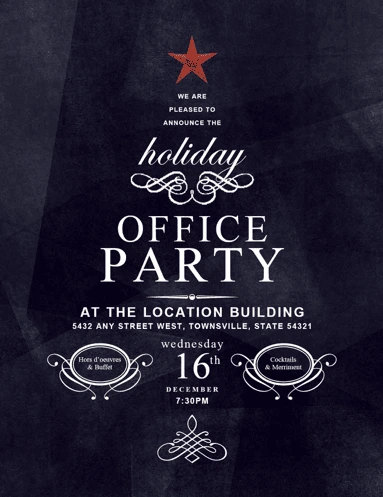
Another great way to get people’s attention is with interesting shapes. This office party invitation from Every Door Direct Mail organizes text into a Christmas tree shape, a surefire hit around the holidays. You can organize text into all sorts of shapes, from beer bottles to flowers. It’s a fun and creative way to add some eye-catching visual interest to your direct mail piece.
Stunning images

While your marketing pitch lives in the text, great images capture attention and evoke emotion. This Parisienne travel postcard gets viewers thinking about travel and romance with a pretty, black-and-white photograph of the Eiffel Tower. It’s good practice to choose an image that complements your brand and your offer, but the primary goal is to make a strong emotional connection.
Macro photography
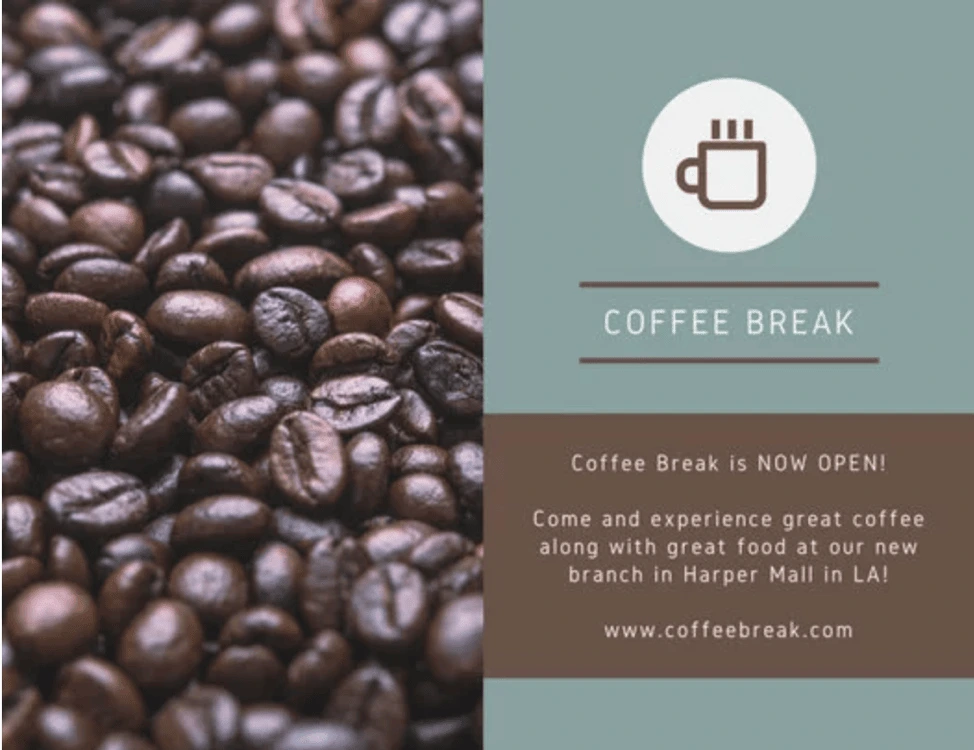
Direct mail pieces have to stand out from the stack of mail that people receive every day. Macro photography is a great way to provide a new perspective on a familiar object—and this direct mail piece from Canva puts this strategy to good use. Rather than a standard cup of coffee, this alluring photo evokes the scent, taste and tactile feel of coffee beans.
Of course, you don’t have to use coffee beans—or any food, for that matter. If there’s an object that represents your brand, product or service, use macro shots to highlight it. If you can use an image that’s personalized to your customers or local area, even better.
Eye-catching colors
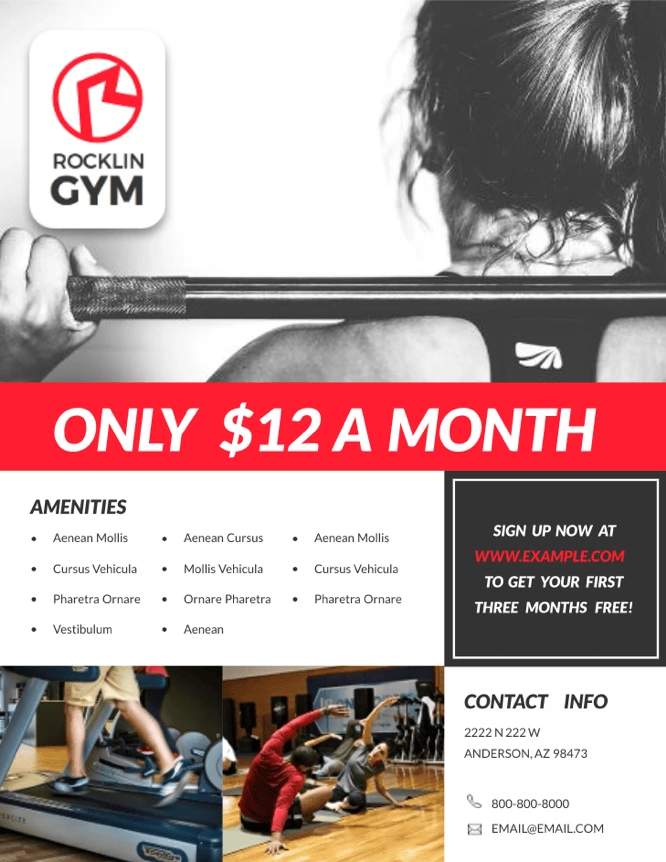
When you look in your mailbox on an average day, what do you see? Probably a sea of white (and off-white) envelopes, most of which look the same. The bright red stripe on this gym fitness flyer immediately stands out and draws attention to the value proposition. Be prudent with your color pops—an overly bright direct mail piece can look tacky and overwhelming. Stick with tasteful highlights like those showcased in this design.
Different shapes
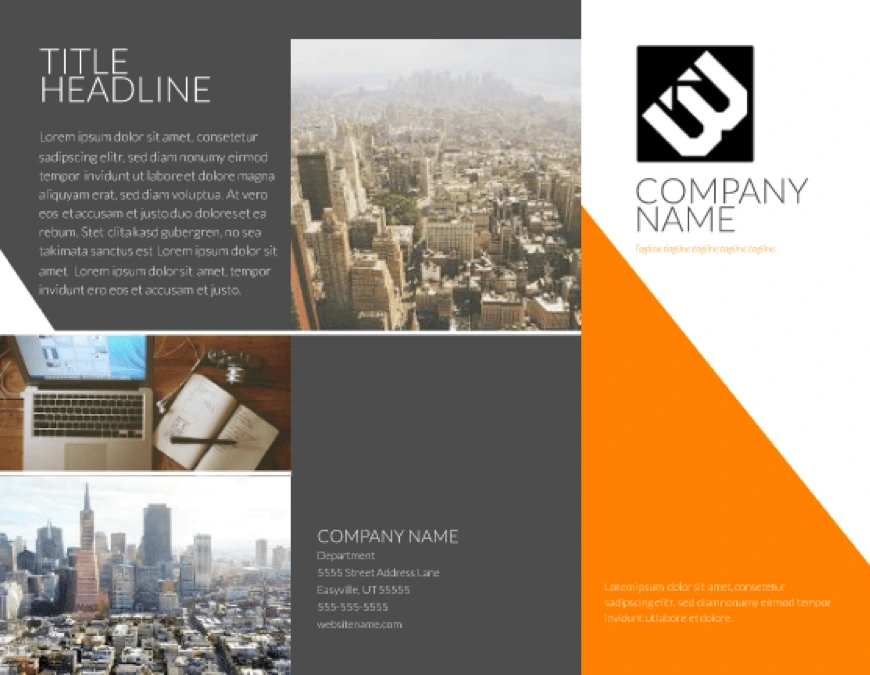
Mailboxes are crammed full of standard envelopes and flyers every day. If your advertising needs to stand out, why not try a different shape? This modern tri-fold brochure will grab people’s attention not only with its color-blocked design, but also with an unusual shape. Folded pieces have a three-dimensional aspect to them, making it more likely to get noticed.
A personalized map

Personalization is a standard digital marketing tactic, but it’s more difficult to achieve in the direct mail space. Maps4Mail solved that by printing customized maps on each piece of mail, showing the recipient exactly where they need to go. The map is intuitive, personalized, and makes it easy for anyone to find your business. This is a great way to show customers you personally value their business as individuals.
If you don’t have the budget for such a granular campaign, you can still try other ways to add a personal touch to your direct mail. For example, you could include something specific to the local area, or you could include your signature.
Unusual materials
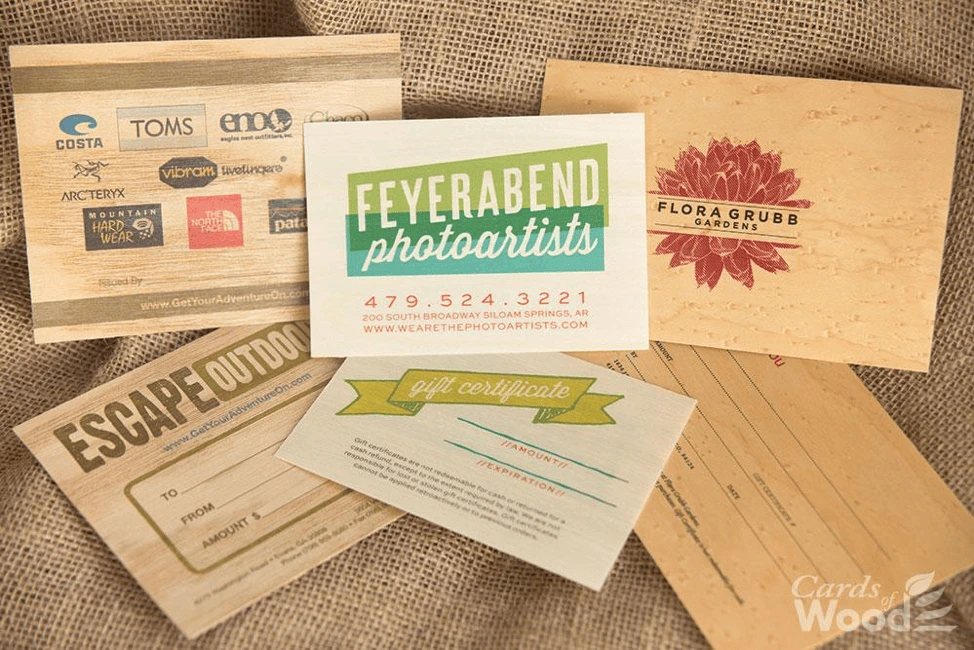
Most letters and flyers are printed on the same white paper. That’s not very exciting. If you can find materials or textures that stand out, you’ll have a big advantage over the competition. Heavy or textured paper work nicely, but if you really want to branch out, check this: These postcards from Cards of Wood are (as you would guess) made entirely of wood. Wood you believe it?
3D objects

People are curious creatures, and we’re more likely to open packages that contain objects. If you can get your brand message across with an object, it can serve as a fantastic ad. Amnesty International sent out these pencil chopsticks to encourage people to write to the Chinese government. Thinking outside the box (or should we say inside) can get great results in direct mail because people spend more time with it.
Interactive mailers
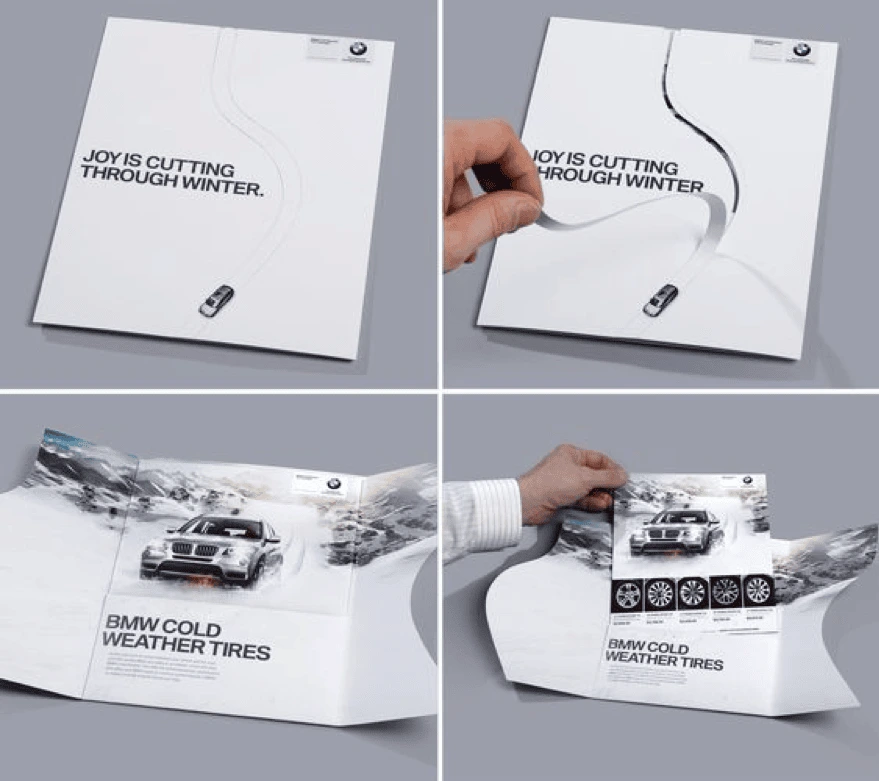
Not every brand can afford to design interactive mail pieces—but if you can, there might be no better way to connect with your customer. This piece from BMW had customers cutting a path through a wintery postcard to emphasize the reliability and control of their snow tires. Their combination of an envelope and mailer is great creative thinking.
Gifts
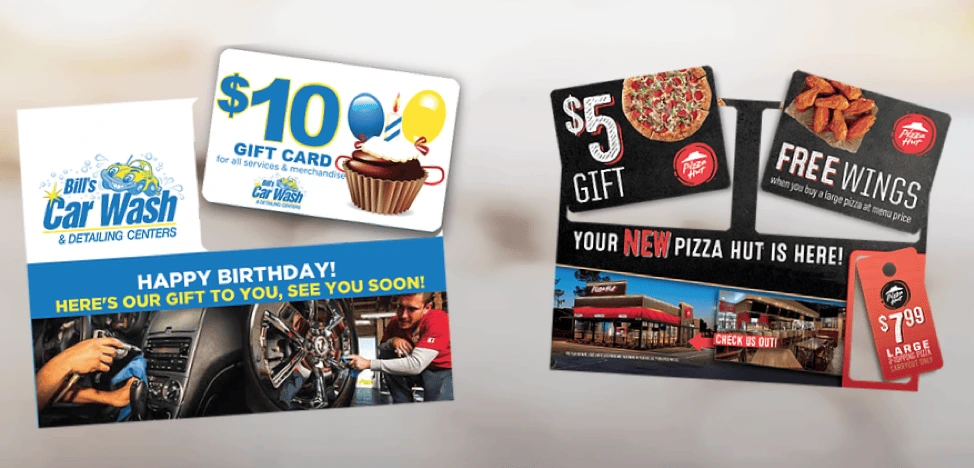
Many direct mail pieces focus on the value brands can provide to their customers—but you’ll have to go further if you want to stand out. A coupon is a good start, but that’s still fairly common. Consider including a punch-out gift card instead. It lets you take advantage of an unusual material (plastic) and give the recipient a gift. A great combination that’s tough to beat.
Key takeaway
People get a lot of mail they didn’t ask for, and different brands will find success with different types of direct mail. The most important thing is to stand out and provide real value to your audience. These examples should get your creative juices flowing and inspire the best direct mail campaign for your own marketing goals.
Ready to create your own direct mail designs in minutes? Check out our direct mail postcard templates.
The rapid rise of digital media—and the simultaneous decline of print media—has been glaringly obvious. Given the clear success of online methods like social media marketing, pay-per-click advertising, and search engine optimization, it’s not surprising to learn that many businesses are increasing digital spends.
Related: Why print will never die—Print vs. digital collateral
In terms of boosting brand awareness, digital is an obvious choice for many marketers. After all, more than three-quarters of Americans shop online. With digital, you can see which content is viewed most, where visitors spend their time, and when conversions have taken place…
…all benefits that we simply don’t see with print advertising.
Yet an important question remains: Is digital everything? Is digital enough to build brand awareness? There are subtle hints in recent studies that point to a surprising conclusion. Rather than going all-in on one or the other, your brand awareness might benefit most from a dual-approach. Let’s set the scene.
Is print media dead?
Remember how excited Amazon was when it launched the Kindle? Well, overall, eBook readers haven’t been anywhere near as successful as initially thought. In fact, eBook reader sales are in decline as readers prefer the look, smell and feel of a real book. The importance of tactile experiences in awareness & engagement is a factor we can’t overlook.
Print media and digital can’t always be described as standalone entities. Consider where digital would be without print. Alive? Sure. Alive and kicking? Probably not. There’s a lot of overlap between the two—QR codes, for example—which leads many to wonder whether a significant portion of digital’s success can be traced right back to print.
Ultimately, it seems that printing services are not as dead as they first appeared. Reports suggest that, while 88% of audiences will view a print ad for 2.8 seconds, only 4% of digital ads are viewed longer than 2 seconds. 35% of digital ads receive no views at all, a wasted opportunity that might be reclaimed with print ads.
Why use print to boost brand awareness?
Well, it comes down to how the brain works. Believe it or not, the brain seems to have a natural preference for printed materials.
Here are three scientific studies that show how effective print can be in boosting brand awareness.
Study #1: The emotional connection
Branding agency Millward Brown found that nothing compares to the emotional connection formed through print media. The agency claims that print leaves a much deeper footprint in the mind due to that personal, emotional bond. The study found that the parietal parts of the brain—responsible for absorbing and storing visual information—were more active in response to print ads than digital ones.
Study #2: Ease & simplicity
Neuromarketing firm True Impact has found that the average person uses 21% more cognitive effort to process digital information than print, suggesting that print materials are quite literally easier to absorb. The report backs its findings by demonstrating that 75% of those exposed to a print ad can successfully recall the brand at a later date, compared to just 44% of people who would could recall the same information after a digital ad.
Study 3: Out-performing across the board
In a study of direct mail conducted on behalf of the U.S. Postal Service, print media was found to out-perform digital materials in nearly every area. Print was the clear winner in terms of review time, stimulation, memory, speed, confidence, desirability and valuation. The only area in which digital performed better was gaining initial audience attention. Print materials can be tailored—personalized direct mail, for example—to combat this issue and come out on top.
Print vs. digital: Which is best?
Digital media has some clear advantages over print media. But looking at the research, it’s obvious that print still has a firm place in the marketing world. That’s why a number of businesses now focus on cross-media advertising, combining both print & digital to effectively and efficiently raise brand awareness.
By combining both methods, brands are able to target a much wider audience. Consider that, while 58% of newspaper subscribers prefer print, 28% say they are digital-oriented. There’s definitely a number of audiences who prefer print, so modern brands should reach out to these audiences, rather than isolate them.
Perhaps the best way to use both print & digital is to consider the unique advantages of both. Through multiple channels, you can reach multiple audiences and deliver your brand’s story. Consider reaching audiences with impressive print media, then create a more personalized experience through real-time, interactive digital media.
Ready to design your own cross-media campaigns? Lucidpress makes it easy to create beautifully branded content in a matter of minutes.
Marketing is getting tougher and tougher—there’s no doubting that.
With 41% of brands planning to significantly increase their marketing budgets this year, and customers becoming choosier than ever, you wouldn’t be alone if you’re exploring new techniques to get more out of your marketing cash.
Related: The complete real estate marketing guide
One strategy you should consider is SMS marketing, the process of sending short text messages to your ideal customers in an attempt to engage them with your campaign and get them to convert.
Even though average open rates for SMS messages beat email by a whopping 28%, your real estate company sells homes for a large price—unlike small-ticket items that can be purchased on a lunch break.
So, how can you make text message marketing your biggest driver of website traffic, leads and sales?
Here are the five steps you’ll need to build out your mobile real estate marketing strategy, as well as two brands who are already killing it with their text messages.
1. Determine who you want to contact
Just like any marketing strategy, you’ll need to base your mobile marketing campaign on buyer personas—a clearly defined document that lists details about your ideal customer.
For real estate companies selling student accommodation, that might include:
- People with less than $20,000 to spend
- Between the ages of 18 and 25
- No long-term commitments
- Currently living within 5 miles of the local college
Once you’ve got this to a T, you’re left with a bunch of shared interests. Use this information to find the people you want to target with your text messages.
2. Collect their information
The next step in your real estate text message marketing strategy is to collect the information of the people you’re targeting. You can do this by taking advantage of your other marketing strategies.
For example: why not run a Facebook ad, using the details you defined in your buyer persona, to encourage them to fill in a form? (You might need to offer an incentive to do this, such as a free ebook or a guide to purchasing a new home.)
But once you’ve got their information, don’t push the Send button just yet. You’ll need to have explicit permission from your prospect before sending an email, or you could land a hefty fine—and an unhappy buyer.
3. Choose an SMS marketing platform
While purchasing a new phone to send out your new messages is a great way to get started, it’s wise to invest in an SMS marketing platform from the outset.
That way, you can:
- Track various metrics after you send, including open and response rates
- Send SMS messages in bulk
- Personalize each message you’re sending
- View your strategy online, and share with other staff on your marketing team
Platforms like Text Local, Text Request and Textedly can help with this, just to name a few.
4. Select a text messaging schedule
Gotten to grips with your new software? Awesome! It’s time to make a start on your text messaging schedule.
You’ll want to put some thought into the time of day you’re messaging your potential buyers, and the day of the week they’re being delivered.
Why? Well, because texting your customer at 11pm could frustrate them—they’re likely to be asleep. However, sending an SMS message at 5pm could reach your customer when they’re on their daily commute with time to respond.
Find the perfect schedule by referring back to your buyer personas and filling out a daily routine for them.
Remember: You want to push your messages at times they’re unlikely to be busy—and have time to invest into their search for a new home.
5. Perfect your messages
Before rushing off and sending the first message that comes to your head, take some time to think about what you’re actually sending. You don’t want to send 10 messages only to find a spelling mistake, right?
Use key copywriting principles to make your sales messages as effective as possible, and focus on replicating your ideal customer’s language.
Going back to our example of student accommodation, this example:
“Ready to let your hair down at this years’ Homecoming? Make sure you’ve got somewhere safe to call home. Reply PARTY to find five local student dorms near Stamford from just $200/month.”
…would be much better than:
“With stunning high ceilings and low-interest mortgages, find student accommodation near Stamford to help with your studies. Reply YES to opt-in.”
Why? Because it’s avoiding the overused jargon that would push them away and making your real estate brand feel more relatable.
2 awesome examples of real estate companies using SMS marketing
Ready to make a start on your SMS marketing strategy and see tons of new leads roll in?
Here are two awesome examples of real estate companies nailing their text message marketing strategy to provide inspiration for your own.
1. “Text for more information”
Earlier, we listed collecting your potential buyer’s information as a key part of your SMS marketing strategy.
…But, what if you could collect their information by asking them to hand it over in a way that suits them?
This real estate company used this idea on one of their “for sale” signs, asking potential buyers to text a number for more information on the listing. It’s a fantastic way to personalize the texts you’re sending—and make sure you’re only focusing on people who are actually interested.
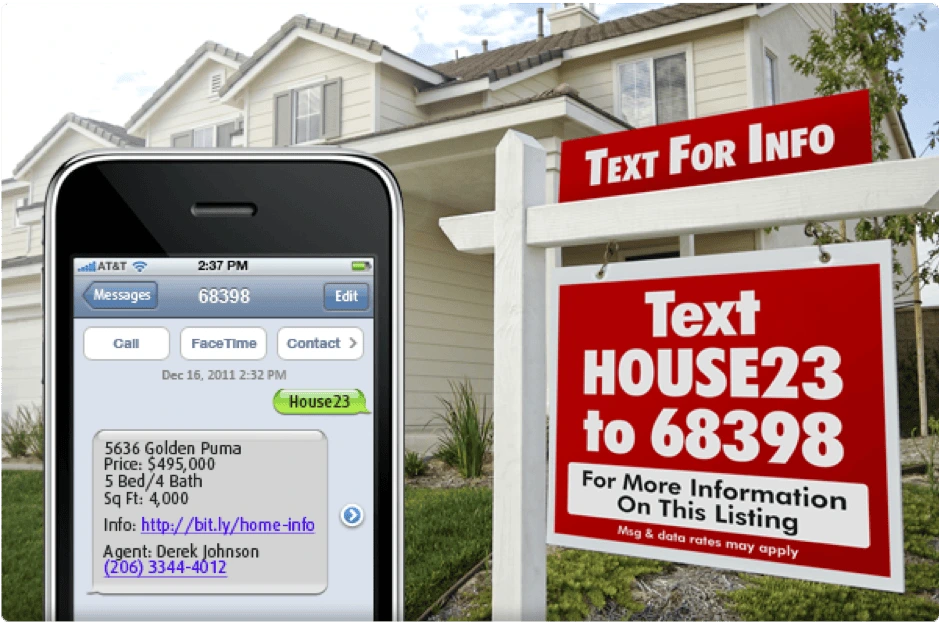
2. Asking for more information
Another fantastic way to engage your potential real estate buyers through text is to ask them for more information, based off the data you’ve already got from them—like this example:
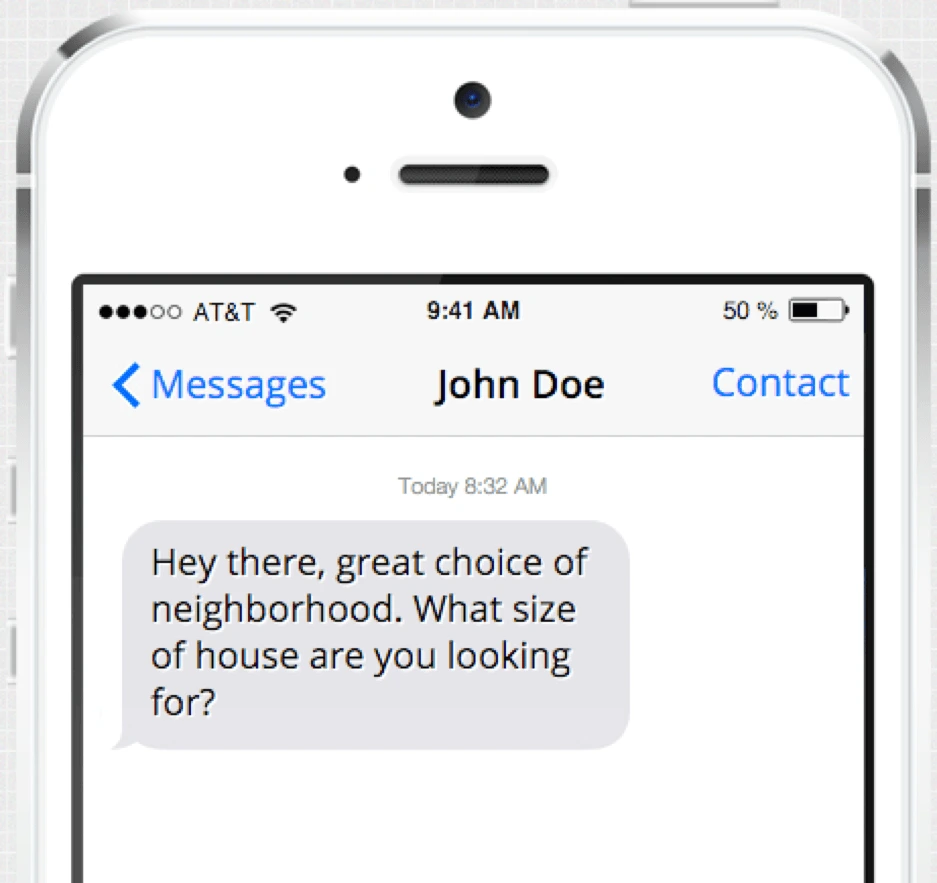
But, why does this work so well?
Well, the prospect doesn’t feel like they’re being contacted by someone out of the blue. They’ve mentioned previous information that’s already been shared (the choice of neighborhood), while asking for more in a way that prompts a response.
Key takeaway
Once you’ve made a dent in SMS marketing for your real estate company, we’re confident you’ll soon see a boost in new inquiries about your properties.
However, don’t forget that it may take some time to see results from your text message marketing strategy. Collecting customer information and perfecting your message can take a while, but don’t give up—you’re almost there.
Your brand matters. Learn how to protect and elevate your real estate brand in this branding essentials guidebook.
Have you spent thousands of dollars on direct mail campaigns with no luck?
You shouldn’t chalk it up to failure just yet. Every great marketing campaign has a solid follow-up campaign behind it.
Sending out three months of direct mail, expecting a deal to happen, and giving up is not creating a business. It’s dabbling.
On average, it takes 12 touches for a deal to happen. However, 44% of people trying to get a deal under contract give up after the first follow-up.
Related: 5 best practices of highly effective direct mail marketing campaigns
I see a lot of real estate investors sending direct mail to find off-market deals. The biggest hurdle most have is that they spend hundreds or even thousands of dollars on a direct mail campaign without obtaining any leads. Then, they send out the same campaign again the following month with the same results.
This is when most people either quit sending direct mail or buy a new list to mail because the old list “wasn’t working.” Not getting any leads from mailing a list doesn’t mean that the list didn’t work—it just means the people you were mailing weren’t ready to sell. Direct mail marketing in real estate is all about timing.
To get a consistent pipeline of deals, you have to implement a great follow-up campaign. This article will walk you through how to set your follow-up strategy.
Following up across multiple channels
The strategy outlined below uses multiple channels to complement your direct mail campaign.
Don’t worry, it’s not going to cost you much more. In fact, it’s going to make those 12 touches a little less burdensome on your budget. Let’s dive in.
Build the right list for direct mail
The first step, of course, is to send out your direct mail. To get rolling with this, start by pulling the list that you’re going to mail.
You can use a list service company like ListSource to purchase a list of people to mail. The types of lists you should be targeting are problematic lists like:
- Probate
- Foreclosure
- Tax-delinquent
- Divorce
- Vacant house
Make sure that you’re filtering out people who have little to no equity. To do this, set your filters to include people with 60-100% equity in their property. This will give you enough breathing room to get the property at a discount.
The other criteria you need to meet is Last Sold Date. We’ve had people call us and say, “I just built this house for retirement three years ago. There’s no way I’m selling it.” Granted, this may not always be the case, but we set our Last Sold Date to 8 years ago or more.
Figure out your farm area
Figure out what your farm area will be starting out. Remember that you have a smaller budget, team, and amount of time as you build momentum. Your farm area will grow as your deal flow grows. Focus on mailing an area that you can comfortably mail consistently every month.
If you work in an office, figure out the radius you want to farm around your home and work. Starting out, we chose a 20-mile radius. The distance isn’t what’s important—it’s how long it takes you to get to the houses within this radius. You don’t want to miss deals because you’re spreading your leads out too far and can’t get to all your appointments quick enough.
We recommend keeping it within 45 minutes. This will give you time to schedule multiple appointments each day as you consistently mail homeowners over time and the lead volume increases.
There’s a cool trick on Free Map Tools that lets you drop a pin, set your desired radius, and get a list of all zip codes within that radius. With this, you can easily pick the zip codes for your farming area around your workplace and home.
Optimize your postcards
What you put on your postcards is up to you, and how postcards perform in each market varies. For our market, plain white postcards with a handwritten font perform the best. (When your prospect has a stack of ten postcards that look like ads and one that looks like a hand-written note, which do you think will stand out more to that person?)
Regardless of the design, make sure you include your company’s name along with your website. The people receiving these postcards will check to see that you’re a credible company before doing business with you. We put Breyer Home Buyers and www.eastatlhomebuyers.com on all our postcards to make it easy to find us online.
If you’re sending direct mail solely to people who are going through a divorce, then you can create a divorce landing page with a URL like www.yourcompany.com/divorce. This gives you the option to retarget visitors using Facebook Ads and Google AdWords. You can do this with any mailing list: tax-delinquent, vacant houses, foreclosures, etc.
Call recipients about your postcard
Your list provider can give you phone numbers for contacts within your farm area. If you keep them in an Excel spreadsheet, you can upload them into a dialer like MOJO. MOJO lets you call hundreds of people in a very condensed timeframe. For our business, we average 71 calls per hour. Of those 71 people, we reach around 30 per hour. We use virtual assistants to call for us, which saves our company significant amounts of money.
To use MOJO, you’ll need a Skype account. MOJO connects to Skype so you can make calls within the U.S. for free, even if you use a virtual assistant.
Remember that when you’re calling prospects to follow up on your direct mail, you should mention your company’s name and that you sent them a postcard. This will jog their memory and make it more likely that they’ll look at the postcard again.
Retarget prospects with Facebook
You can use Facebook and Google Ads to retarget your prospects. Retargeting is cheaper than marketing to cold prospects with these channels. And these prospects have already seen your direct mail, landed on your website, and received a call from you. When they see your ad and click on it, they’re more likely to convert, which provides you with a higher ROI.
The other benefit is that most of us are too busy to immediately respond to marketing. Maybe your prospects were taking their kids out to eat when they drove by the mailbox and got your postcard. Maybe they were waiting on a meeting to start when they looked up your website. Maybe they lost your postcard and couldn’t find you again. Regardless, retargeting helps you pop back up in front of your prospect when they need it most.
Send an SMS blast
There’s no replacing a phone call, but sending a text message is a great way to get in touch with people who don’t like talking on the phone. We use EZ Texting to follow up with people through text. We simply upload an Excel spreadsheet of our contacts, then blast the same message to the entire list.
We usually send out open-ended questions like “Have you sold your property yet?” But, there’s no magic message. The goal is to start a dialogue, so you can make an offer to buy their property.
We’ve gotten several properties under contract without ever speaking to the homeowners on the phone, by doing all the rapport-building and negotiation over text.
Leave voicemails on landlines
Tools like Sly Broadcast let you pre-record a voice message and send it to the phone numbers on your list. It’s important to note that this service only drops voicemails to landlines, not cell phones. Using this in conjunction with the text blast will make sure you’re touching all phone types.
MOJO Dialer also drops voicemails when you’re power-dialing, but the key difference is that you are actually calling someone and will have to speak with them if they answer. With Sly Broadcast, the phones don’t ring, but a voicemail shows up on their answering machine.
Schedule your follow-up campaign
When we’re planning our direct mail campaigns, we schedule the arrival date of those mail pieces—meaning that we know (within one day) when those mail pieces will be delivered. We usually have our mail dropped on Tuesday because our response rates are higher on Tuesday.
Here’s what our follow up campaign looks like:
- Week 1: Direct mail delivered on Tuesday
- Week 1: Begin Google AdWords and Facebook retargeting
- Week 2: Cold call prospects
- Week 3: Text prospects
- Week 4: Voicemail drop
- Week 5: Repeat mailing to the same list
- Week 6: Repeat cold calling to the same list
- Week 7: Repeat texts to the same list
- Week 8: Repeat voicemail drop to the same list
With retargeting, you set it up once and keep it running. We don’t stop the Facebook and AdWords campaigns. Your goal should be to contact each prospect with a phone call, a postcard, a text, and a voicemail drop each month.
Why you should always follow up
Homeowners usually aren’t ready to sell when you first reach out to them. Granted, sometimes we do get lucky and close a deal on the first mailing. But, it usually takes us at least three mailings to get a deal from a campaign.
If you label your direct mail campaign a failure because you haven’t gotten a deal right away, then you risk missing out on future leads and give yourself zero return on your investment.
If you look out over the year and set a goal for 5 deals to get the real estate investing ball rolling, you’ll create a marketing plan to reach that goal. However, if you keep changing your marketing strategy because you haven’t given yourself enough time to make it work, then you’ll never reach it.
Ready to create your own direct mail designs in minutes? Check out our direct mail postcard templates.
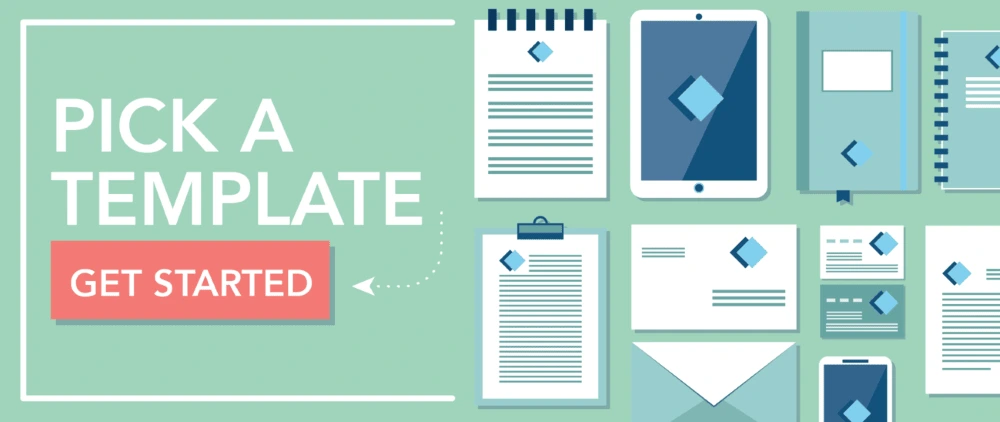
Or, learn more about the new direct mail features in Lucidpress and give it a test drive.
In the digital age, we are constantly surrounded by bleeping phones and notification alerts. The onslaught of incoming communications can seem incessant and unceasing. Most modern consumers are surrounded by distractions, and marketers have a tough job helping their brands catch the attention of prospects.
Related: Create strong emotional connections with your brand story
Often, an effective approach is to add to the stream of information and hope to outdo competitors by offering big discounts and exclusive deals. These quick wins can help your business reach its short-term goals, but they won’t lead to long-term loyalty from consumers. Brands need to build trust with customers so they come back time and again—a one-off discount can’t achieve this.
Instead, the best-known and longest-surviving brands create and nurture emotional connections with their customers—turning them into faithful followers. To do this, marketers use emotional branding. It can take some time to reach the point where your customers’ actions are fueled by emotion, but it is worth the investment, as repeat customers are extremely valuable.
Why invest in emotional branding?
It costs more to acquire a new customer than it does to keep one. The exact figures vary, with different studies suggesting it can be between 5-25x more costly to attract a new buyer than to retain one. One Harvard Business School study suggests that improving customer retention by 5% will increase a company’s profits by between 25% and 95%.
Every marketer knows that building a strong brand is hugely important in distinguishing a business from its competitors. But, they may not realize just how much it can impact their bottom line. A successful brand goes much deeper than its logo; it creates an emotional connection with customers.
Emotional branding defined
Emotional branding is about building a brand that appeals directly to consumers’ emotions, needs and ambitions. With emotional branding, marketers aim to trigger an emotional response in consumers.
By provoking emotions, marketers can create a bond which disrupts traditional consumer decision-making models. These models are largely based around the idea that consumers make a purchase based purely on logic, but these models are changing.
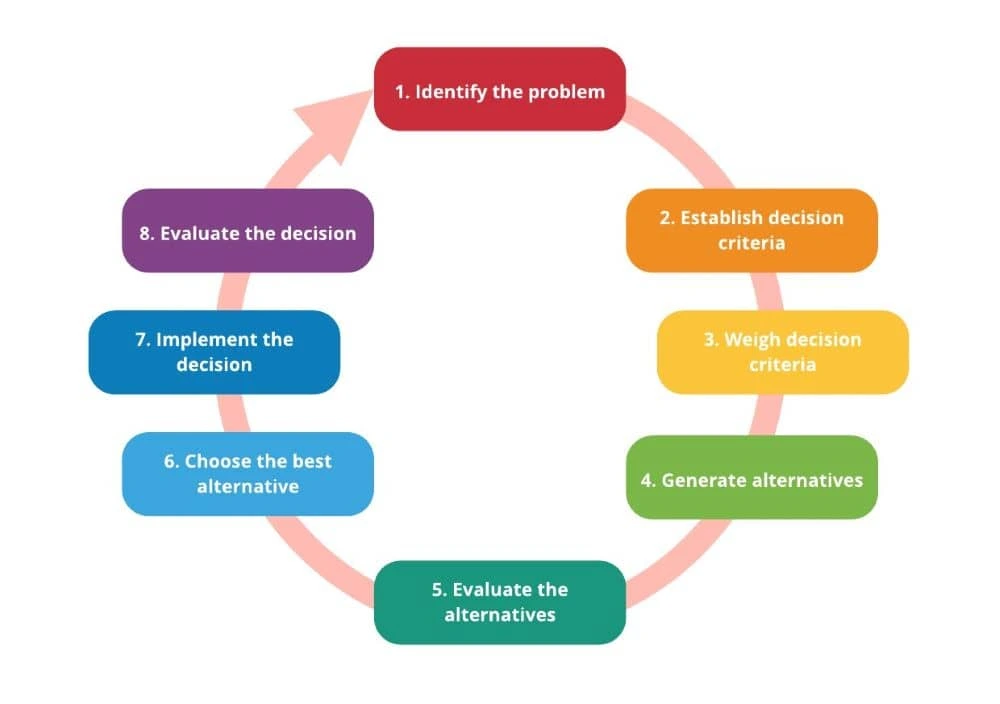
Quizlet’s rational decision-making model,lovingly recreated in Lucidpress
When emotional branding comes into play, decisions can become irrational. When given the choice between two similar products, a consumer may simply follow logic and choose the cheapest or most convenient option. However, when emotion is in the mix, they may choose to buy the brand they relate to most.
It’s easy to see how building an emotional bond with consumers can increase profits and why premium brands like Nespresso and Coca-Cola engage in building emotional connections with their customers.
Often, people choose purchases based on ego rather than necessity. Consumers can show who they are through the brands they choose—and they are willing to pay more and go out of their way to do this. It is up to marketers to position their brands in a way that will connect and resonate with their target audience. When done right, cutting through the distractions of the modern world will come easy.
How to incorporate emotional branding in your marketing strategy
The likes of McDonalds, KFC and Disney employ a number of methods to connect in a meaningful way with consumers. The longer a business is around, the easier this becomes, and many brands take advantage of anniversaries and nostalgia to bond with their market.
But, newly founded businesses don’t need to miss out. Here are just some of the approaches to emotional branding that can be used to bond with consumers.
1. Show your customers you care
To succeed at emotional branding, it’s essential to thoroughly know your audience. You need to treat your customers as people rather than faceless consumers. Do your research, conduct surveys, then decide how you can connect with your audience.
What do they value? What triggers them emotionally?
Once you’ve decided which emotion you want to tap into, this should consistently be evident in your marketing messages. From social media to customer care, a brand should constantly address customers’ emotional needs.
Over the years, e-commerce site Zappos endeared itself to customers by going above and beyond to provide great service. From providing free overnight delivery to a customer in a sticky situation to assisting a hungry helpline caller in need of pizza, the site has built up a loyal following.

While Zappos provides an extreme example of customer care, creating an emotional connection by meeting and exceeding customer service expectations doesn’t have to be so extravagant.
Apple has built a cult following simply by demonstrating that it understands the needs of its users. Nike recognizes its customers’ dreams and ambitions, and the brand uses marketing to show how it can help with the journey.
French beauty brand L’Occitane simply provides customers with beautifully presented deliveries and free gift-wrapping—making a memorable impression which, for many of its customers, is more appreciated than a discount.
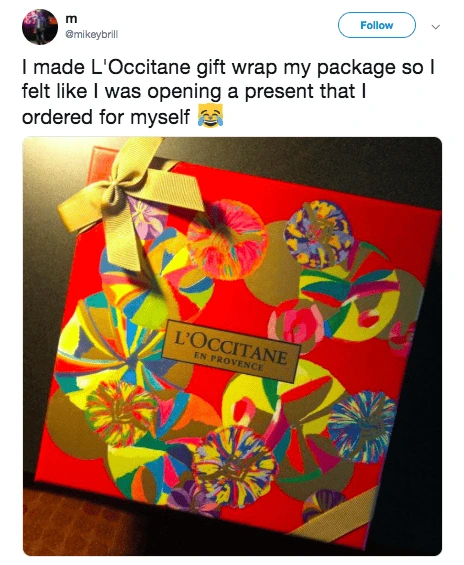
2. Be consistent
For online marketers, consistency is key. Sharing content which demonstrates a consistent tone and style builds both visibility and trust for a brand.
Without the trust of your audience, there is no way you’ll be able to build a strong emotional bond that will keep customers coming back.
Here are some practical ways to ensure brand consistency:
- Set out your brand values. Share them with the whole team to help employees at every level stay on-brand and make decisions that reflect your brand’s true personality.
- Create a set of brand guidelines. Outline your brand’s tone of voice and key design elements like font, color palettes and correct presentation of the logo.
- Put together a social media style guide. This will reinforce some of the elements set out in the brand guidelines, but it will also advise the social media team on which content they should post and how to respond to criticism.
- Use a branded URL shortener. Customize your short links so they are on-brand. This will improve brand consistency and build trust with your audience. For example, Rebrandly links receive up to 39% more click-throughs because consumers trust them.
- Create design templates. From presentations to social media images, make it simple for everyone to create high-quality, on-brand content. Then, make them accessible to the whole organization through a brand templating platform like Lucidpress.
- Monitor brand mentions. Keep an eye on what’s being said about your brand online using Google Alerts or another brand monitoring tool. Determine if your brand is coming across as intended and connecting emotionally with consumers.
3. Give customers an experience they won’t forget

Beyond providing great customer care, consider what other kind of experiences your brand can use to build an emotional connection with customers. Big brands often sponsor concerts and sporting events—or run their own. What could be your brand’s Disneyland?
If you have a brick-and-mortar location, could you host an entertaining event? If you’re working with a smaller budget, could you provide an Instagrammable installation in-store? This is a simple, but impactful, way to connect with consumers in today’s digital world.
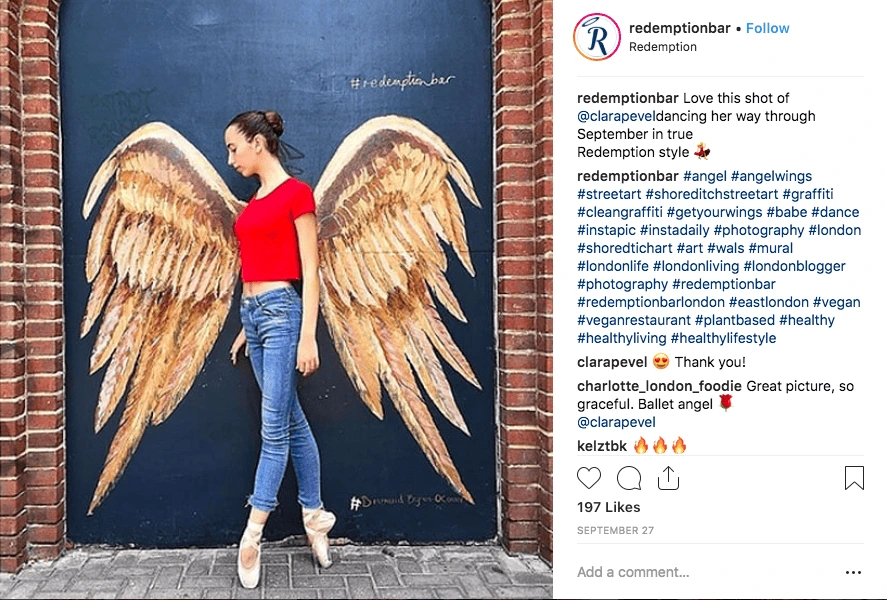
Source: Redemption Bar
Provide a positive experience as customers use your product or service wherever possible. UX is growing in importance for online businesses and is intertwined with the overall brand experience.
Companies like Slack impress customers by providing a helpful and supportive experience through friendly reminders, convenient app integrations, and cleverly auto-populated gifs.
Alternatively, you can use marketing campaigns to align your brand with a particular lifestyle or emotional experience. Coca-Cola’s “Open Happiness” campaign is a clear example of this.
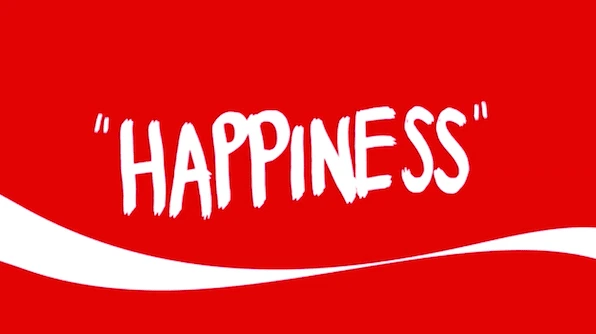
4. Put a friendly face at the center of your brand
Whether it’s a celeb, an Instagram influencer, or an employee-turned-brand-ambassador, sometimes the best way to connect with consumers on an emotional level is through a warm human personality.
Female consumers don’t go through enormous lengths to get one of Kylie Jenner’s lip kits just because of the product’s quality. They do this because of their love for the company’s CEO.
You don’t have to have a famous face to build a close relationship with your audience. Many charismatic CEOs have become the heart of their company’s brands.
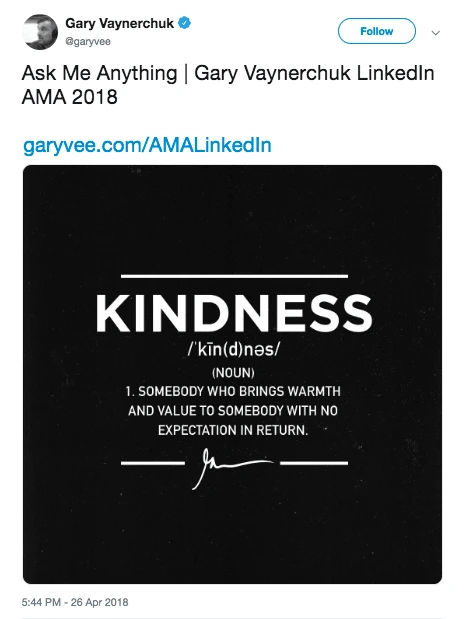
Think of Gary Vaynerchuk or Neil Patel, who have both built strong personal brands and businesses through social media. Their willingness to share knowledge and expertise with consumers has helped them to connect with audiences on an emotional level.
On a smaller scale, it’s very possible for a friendly waiter to drive customer retention by creating personal connections with diners. Brand ambassadors can come in many forms, and they’re a great way to reinforce brand values and build rapport with customers.
Key takeaway
Emotional branding builds lasting relationships with your audience and can improve the profitability and longevity of your business. You want to bring your customers to a point where they can’t imagine going to anyone else to get the products or services you provide.
Big brands are leading in this area, but small businesses can get in on emotional branding through the smallest of gestures and actions. As social media algorithms change and internet browsers seek out online communities, connecting emotionally will become a key strategy for cutting through the distractions of the modern world and reaching audiences.
Learn more about the power of emotional branding & storytelling in our webinar with branding expert David Brier.
Since 2008, real estate has gone up by an incredible 11.4% and created a fantastic opportunity for real estate agents to sell more clients.
Millennials will quickly become over a quarter of the real estate market, and only 1% of those millennials didn’t search online while looking for a house. Just one percent.
Related: How to handle inbound real estate leads
The internet has forever changed the way real estate agents get leads for their business, and you’re definitely behind the curve if you haven’t optimized your website for lead generation.
How do you generate real estate leads online? In this guide, you’ll learn various methods for obtaining quality leads online and the secret to converting your website into a real estate marketing machine.
Let’s get started.
1. Social media
If you’re not a frequent user of social media, it’s time you got started. Most people have a Facebook account, and many are active users on Instagram as well.
Instagram in particular is a fantastic avenue for sharing high-quality images and videos of properties and advertising your latest content (e.g. blogs & newsletters) effectively. By engaging with different channels each day and adding value to others, you’ll begin building a devoted following online.
Lots of real estate agents don’t do social media because they lack time for it. But with tools like Buffer and Hootsuite at your disposal, you only need an hour to set up a whole week’s worth of posts. All that’s left is checking the comment threads and responding whenever you have a few seconds throughout the week.
Read more about social media for real estate: How to build a social media campaign for real estate
2. Website
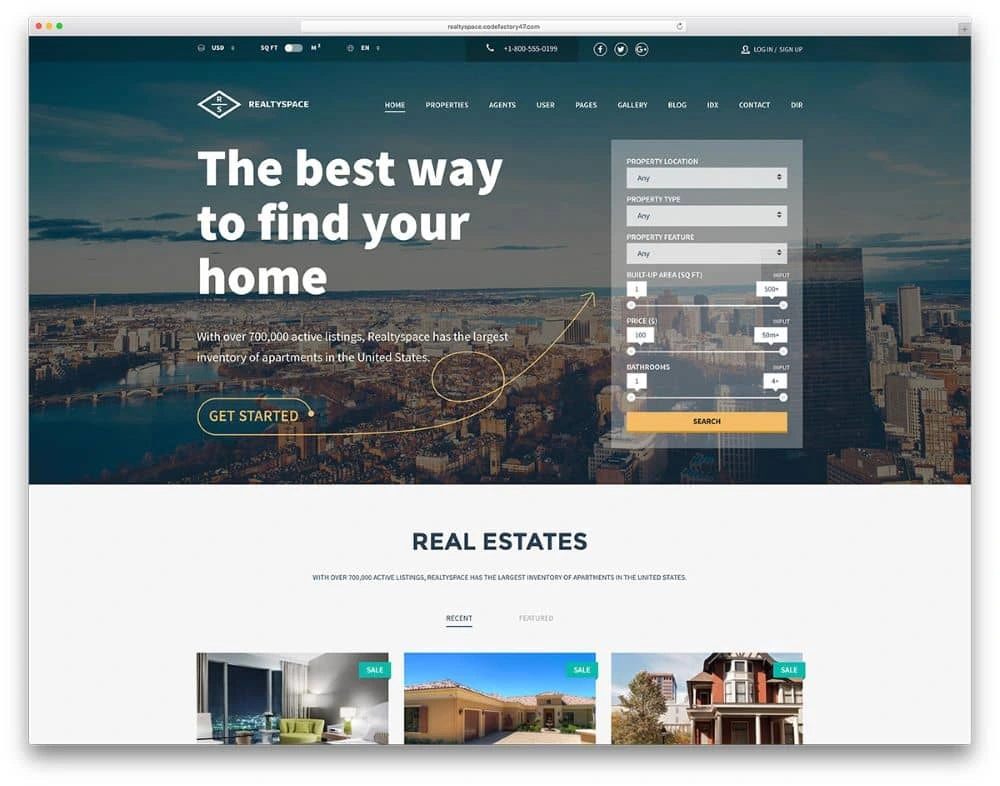
Source: Colorlib
If optimized properly, your website could be the foundation for attracting real estate leads online. It gives you the ability to provide value to your target market and help them engage with your brand.
Many real estate agents make mistakes in this area, and your website is not the place to describe your greatness in detail. Make your copy about how you’ll add value and better the lives of your customers.
An easy way to check whether your website is focused on your target market is to count how many times your site uses the word “we.” Customer-focused websites will use the word “you” more often.
3. Newsletter
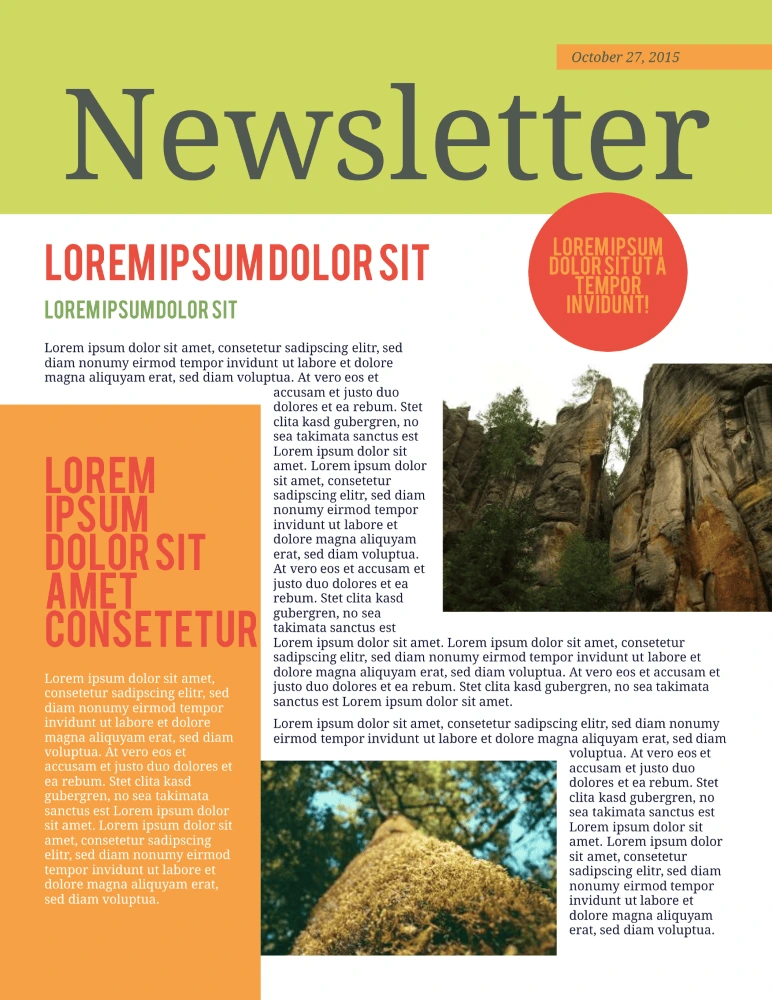
See more newsletter templates from Lucidpress
It’s always a good idea to keep your name top-of-mind, and a newsletter is a great way to do so. Newsletters can share real estate news, recent listings, and tips to deal with typical homeowner struggles—like preparing your house for the winter.
A newsletter is especially useful if your leads live in urban areas. Cities such as San Francisco, Los Angeles and Chicago are massive and busy, so it’s easy to miss out on events if you’re not paying attention. It’s also an excellent opportunity to inform subscribers about the latest news and events in their area.
Read more about newsletters: 13 best newsletter design ideas to inspire you
4. Blog
Blogging is one of the most popular and effective ways to generate leads online. But like any lead-generating tool, it has to provide great value to your target market. A blog post about the staff holiday party is not going to get the leads you want.
The best information to share with your target market is actionable. This could include topics like making a down payment, picking a lender, listing their home, and working with a real estate agent.
Free advice will grow your influence and make you a valuable resource—so when someone needs to sell or buy a house, they’ll think of you first.
Read more about blogging for real estate: How to use content marketing in real estate
5. SEO
The first page of search results has only ten slots. 33% of the people searching will click on the first result. 18% will go a step further and click on the second result. The further down the page you go, the fewer clicks there are—only 4.4% click on the sixth result.
That’s why every business wants to be on top. The lower you are, the harder it gets to attract your target market’s clicks.
The ideal SEO strategy is about finding the best keywords (and phrases) to target, then using them deliberately in your content to attract the customers you want. SEO powerhouse Moz has lots of free resources and tools to help you get started.
6. Video
If seeing is believing, then showing off the fantastic features of your properties is a surefire way to win converts—and there’s no better way to do that than with video.
Videos empower your potential clients to take a guided tour of your properties. They’ll be engaged by your content, but more importantly, they’ll be motivated to reach out for more information.
A video is far more than just a slick way to show off a property. On average, an online video converts 33% of leads. If you want a more captivating way to connect with your target market, video marketing is a great way to increase interest in your properties.
Read more about video marketing for real estate: How to create stellar videos for real estate listings
7. Influencer marketing
Connecting with others in your industry is always wise, and doing it online makes it easier than ever. You can share and amplify each other’s work through social media and comment on posts each of you publish.
Influencer marketing takes this one step further. It starts by figuring out who your target market is—specifically. Then, you can find influencers who are popular among the folks you want to target. By partnering with these influencers on advertising campaigns, you can reach wider audiences and attract more people to your brand.
Read more about influencer marketing in real estate: 5 influencer marketing strategies for real estate
8. Mobile optimization
Industry professionals often spend tons of time and money making sure their website is professional and easy to use… then forget to check how it looks on a smartphone or tablet.
Mobile search has surpassed desktop search, so it’s more important than ever that your website works with mobile devices. (Google is going as far as penalizing sites that haven’t created mobile-friendly layouts.)
Make the switch. Not just to protect your website from Google, but to impress customers who encounter your brand exclusively via mobile device. Aim for the same goals as your regular website: clear copy, attractive design and intuitive function.
Want to go even further with mobile? Read more about using mobile text messaging for real estate: 5 steps to build out your real estate mobile text messaging strategy
9. Referrals
When you start off as a real estate agent (or in any field, really), you won’t have a network. So, it’s up to you to build one.
As you begin to deal with customers, don’t forget to ask for referrals. Encourage them to share your name with others—make it easy and worthwhile for them to do so. Whether it’s to their friends, family or coworkers, advertising by word-of-mouth is powerful. People are more likely to follow recommendations from people they know than an anonymous review online.
10. Retargeting
Although we covered social media all the way at the beginning of this guide, we left out one element that deserves its own section: retargeting via Facebook ads.
Facebook ads are not a popular method of advertising in real estate circles, despite how high the ROI can be. Here, retargeting simply means that people who have shown interest in your brand will see your ad again. This “interest” is measured by actions such as reading your blog posts, clicking on one of your ads, or even signing up for your newsletter.
Your conversion rate will improve if you target people who want what you’re selling. People who are actively interacting with your brand are more likely to buy than those just scrolling through their feeds. Retargeting keeps your brand top-of-mind for the folks who matter most.
Key takeaway
Leads don’t just magically appear in your inbox. You need a strong lead-generating strategy that helps you cultivate interest in your brand and set you apart from the competition. These tips should get you on the right track to generating real estate leads online.
Hungry to hear about the best marketing practices for real estate? Hop over to our real estate marketing guide for more ideas & inspiration.
Open source learning. A global economy. Shifting demographics. These are just a few realities impacting your college recruitment strategy.
According to the National Student Clearing House Research Center, Spring 2018 college enrollment across U.S. campuses was down from the previous year. University and college recruiters have shifted to overdrive in response.
Related: How to improve higher ed student retention
Some focus on radio ads, alumni referrals and online recruiting fairs. Others build interest on social media and at live events.
Regardless of the outreach method, one thing is clear: In today’s higher education landscape, recruiters must be increasingly creative and strategic to attract new students.
A varied college recruitment strategy
“The times, they are a-changin’,” sang Bob Dylan. Want to keep up? Pay attention to your audience.
Today’s students don’t want a cookie-cutter version of their parent’s university experience. They’re also not impressed by (pun alert) old-school marketing tactics.
Instead, create a varied strategy that will reach your top prospects on multiple channels. Essentially, you want to provide engaging information that helps your college sell itself.
Use multi-channel enrollment marketing
Most colleges and universities know their target demographic well, and they market to basically the same audience year after year.
However, success also depends on reaching new targets via a multi-channel approach:
- Website — a branded, responsive hub that’s easy to navigate and engaging to use
- Blog or vlog — where interested prospects go for bite-size information
- Social media — critical online outreach, both locally and internationally
- Email campaigns — important tactic for lead generation and nurture
- Direct mail — still relevant and effective marketing for certain audiences
- Phone calls — an effective, if time-intensive, method for personal outreach
- Brand ambassadors — relatable outreach by faculty, students & alumni
- Parent outreach — critical influencers of your target audience
- Campus visit days — highly successful recruiting events, up close and personal
- High school visits — successful outreach that meets students where they are
- College fairs — key events that can market your institution both off and online
- International markets — a growing segment of your target audience
Now, for a few of the most helpful enrollment marketing strategies…
Recruiting college students online
It’s no surprise that most prospective students live online, particularly on mobile technology.
So, today’s recruiting strategies must be mobile-friendly. End of story.
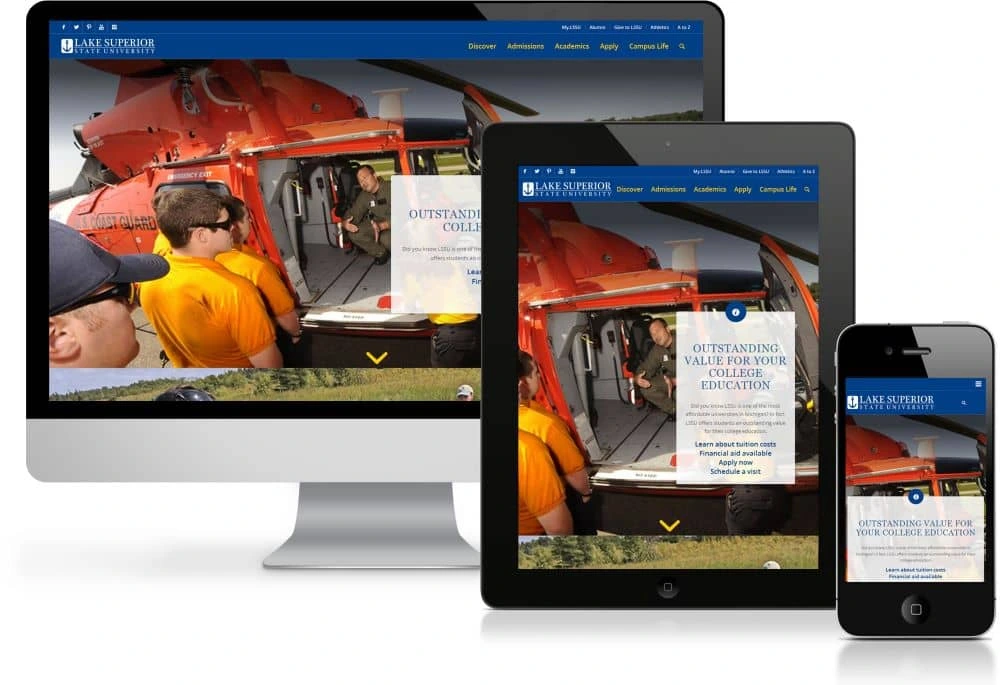
Source: Lake Superior State University
Responsive web design is no longer optional. But, you’ll stand out even more by offering mobile-friendly instruction and interactive pages.
For instance, students are wondering what they’ll learn on your campus. Why not show them instead of tell them?
Continuing education is common enough. But, standout institutions are experimenting with AR, game-based platforms and social learning models. Just one interactive feature on your site can put you ahead of the curve.
Even without all the technological bells and whistles, you can still provide value to new recruits.
Offer valuable resources
Don’t just throw a bunch of content on your website and call it good. Instead, create a user-friendly path that puts visitors at ease.
Which resources are clicked on the most? These might include:
- A catchy, above-the-fold video
- A listing of popular majors
- Programs and career opportunities
- Student and alumni testimonials
- Admissions deadlines
- Financial aid information
- Data-rich infographics
Simplify the application process
Of course, what you don’t include on your homepage can be equally important.
Generally, anything that simplifies your navigation and motivates would-be students to apply online is a good thing. Often, it means including more white space in your webpage design.
Face it—applying for college can be a daunting task even for the initiated. So, a user-friendly interface is essential.
Why not include a pithy video tutorial or a colorful step-by-step checklist to make the application process less painful?
Also, non-traditional students (e.g. adult learners, international students) generally want to know about credit transfers, flexible course listings, and financial aid options.
Build your blog
Most colleges today have a blog. What about your college?
More importantly, does your blog cover the topics your prospects care about most?
Boston University’s blog regularly shares pithy thoughts and videos by faculty members.
Likewise, Cornell University publishes “life on the hill” posts that help wannabes sample current students’ daily academic routines.
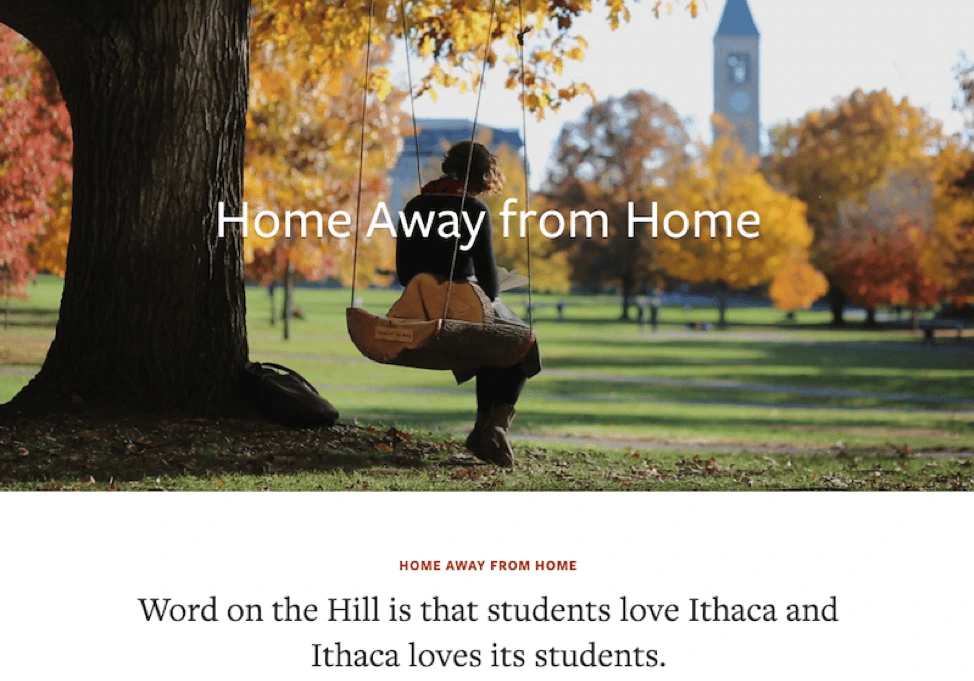
Source: Cornell
Your blog might also feature guest posts by alumni, video tours, listings of popular courses, and user-generated content.
And of course, the most popular blog posts should factor into your upcoming email campaigns.
Direct interaction with prospective students
As you can see, a successful recruiting strategy contains many moving parts. But, personal interactions (phone calls, campus visiting days, etc.) are still the most powerful of these.
According to Hanover Research:
“Despite increased digital activity, a recent survey found that the most effective marketing strategies for universities are nevertheless events‐based and involve direct interaction with potential students.”
After all, sometimes it really is about your newly upgraded facilities, swanky campus and student perks.
Most prospects who’ve gotten this far already know about your tuition costs, financial aid options, and faculty-to-student ratio. A successful campus visit just helps close the deal.
International student recruitment
Quick—what’s the Chinese version of Twitter?
If you’re recruiting students from China, you already know the answer to this question. (It’s Weibo, by the way.)

Source: Statista
As you can see, international student recruitment is alive and well at American colleges and universities.
As discussed earlier, your website needs to be user friendly and easy to navigate. This is particularly important if you’re appealing to international students.
Your site should help this target demographic understand the advantages of studying in America—and at your institution specifically.
Simple videos and infographics can also help smooth potential cultural barriers.
Do you already feature international students in your recruiting videos? If not, now’s the time to help them share their story—in their language.
As appropriate, include video links in your email campaigns. Share these on international social media channels.
Your website should also include pages dedicated to the specific needs of international students and recruits.

Source: Cornell
Reduce educational jargon
Higher education is adrift in educational jargon, which can be painful even to American-born students.
All those acronyms can be excruciating to international applicants. Whenever possible, cut them out and use a simpler description.
In the end, remember: Every positive interaction with a brand depends on clear communication.
Key takeaways
Now that you’re familiar with what it takes to build a successful recruiting strategy, let’s wrap things up by considering the real-life example of Western Colorado University. WCU’s creative team struggled to manage their recruiting strategy and materials, as they were too busy trying to keep their head above water.
Read Western Colorado University’s full case study here to learn how they dealt with their recruiting and marketing problem.
Is your school delivering a strong, consistent message with its brand marketing? Learn more in our free ebook: Branding in student recruitment
Last week I received a letter in my mailbox for the first time in a long time. It’s been ages since someone (even a company) sent me physical mail rather than going the easier route with email.
It really felt good to have something that I can touch and feel with my own hands.
Related: 11 best direct mail pieces to inspire your next campaign
Sometimes, the dull and boring side of advanced technology makes us realize we’ve come a long way. There was a time when people used to get a lot of mail in their mailboxes, especially in the form of promotional material.
Gradually, companies left that behind and considered it defunct. But in reality, direct mail is still a great way to engage with one’s audience.
Why? Because in our modern age, it provides a personal touch that email can never replicate. Data published by the Data & Marketing Association in 2016 showed that the response rate of direct mail increased 43% year-over-year. This is a huge leap from previous years.
Companies should know that it’s short-sighted to completely do away with direct mail. It’s still an effective and useful tool. To drive home the point, here are eleven reasons why every brand should (re-)consider direct mail.
1. You can achieve a higher ROI
Most companies set up online ads hoping to see better ROI because of the huge number of internet users.
But, direct mail can drive even better impact: a median ROI of 29% compared to online display at 16%.
When someone receives physical mail, it carries more weight (and not just literally). Customers are more likely to respond to communication that feels personal, and direct mail makes it easier to send that message.
2. Direct mail pairs well with digital marketing
If you want to build your own brand online or enhance the reputation of your company, digital marketing is usually the best place to start.
For many brands, this includes publishing SEO-optimized content and setting up Facebook ads. It usually doesn’t include direct mail… but maybe it should.
Direct mail can help you bridge the gap between the digital world and the real one. You can reach potential customers who might otherwise never hear about you—and you don’t always have to sacrifice data to do it.
For example, a digital marketing agency in our own state (Utah) included a scannable code on the back of one direct mail piece. They could track engagement with that code just like they would any other online campaign. They also included a Twitter hashtag that people could use to interact with the campaign. These techniques help to tie everything together, so their team got a holistic look at their campaign’s performance.
3. You can hold direct mail
This might seem obvious, but humans are sensory creatures. An email lives on your digital gadgets, where you’ll never be able to touch it. People can actually touch and feel the direct mail that a company sends to them, and because of that, it leaves a stronger impact.
This is especially valid for pieces that provide real-world value, like a free sample or discount coupon. Customers are more likely to remember and redeem those promotions than the ones they’re inundated with via email.
4. Attention, please!
When people check their mail, they take and go through everything they’ve received. It’s almost guaranteed that they will look at each and every piece, even if it’s only for a moment. Then they have to decide what to do with each piece—deciding which ones are worth saving and which ones are okay to throw away.
Conversely, when someone’s checking their email, they’re often engaged in other behaviors and environments that divide their attention. For example, they could be multi-tasking at work or watching TV on the couch. Since direct mail deals with fewer distractions, it benefits from better attention spans.
5. You can track direct mail
There are plenty of email & direct marketing tools to track the progress of your email campaigns. What about direct mail? Yes, it’s true that the process isn’t fully automated in the same way—but you can make them easier to track.
For example, you can designate a phone number or email address solely for the target audience of your direct mail campaigns. You can also create specialized landing pages with unique URLs. This will greatly improve the quality of your data and the accuracy of your success metrics.
6. All ages welcome
Any time you opt for a particular marketing strategy, it’s vital to understand which age groups that strategy serves.
In the case of email marketing campaigns or online advertisements, seniors are often left out because they adopt technology later than the younger generations. If seniors are a key demographic for you, you’re probably leaving money on the table.
Instead, consider reaching that audience with direct mail. And don’t assume seniors are the only ones—other audiences could benefit, too. Take a look at your audience and think about whether direct mail could extend your reach.
7. When others zig, you zag
Since digital marketing has so thoroughly transformed the landscape, many companies have quit using direct mail altogether. Just because fewer people are using it, however, doesn’t mean it’s an obsolete tool.
In fact, there’s a little bit of irony at play here: Your brand can stand out by reincorporating direct mail as part of your campaign. The high ROI speaks for its validity, and you can get the best of both worlds by adding physical mail to your digital campaign.
8. Direct mail can help you target specific audiences
We’re used to seeing the targeting capabilities of various social media platforms. But, did you know that direct mail can also target specific audiences?
For example, the USPS website has a tool called Every Door Direct Mail, which lets you send mail to addresses within a selected geographic area. This is the same system Lucidpress uses to send direct mail postcards from our platform to the local areas you want to target.
It’s not only about location, though. Address databases often contain other details you can use to target an audience: age, income, marital status & more. With these, you have granular control over who to send your direct mail to.
9. You can raise brand awareness
Are you trying to raise awareness of your brand? If you’re willing to build a campaign around that goal, direct mail can be a very effective way to achieve it.
As always, brand consistency is key, so keep your direct mail pieces consistent with overall branding.
You can earn extra points by including a coupon or another special offer, increasing the likelihood that your recipient will keep it around. The more times they view your direct mail piece, the more familiar your brand will feel to them.
10. Direct mail tickles the senses
Quick: name the five senses. Now, name the senses you can activate with a digital marketing campaign. Suddenly, your options are a lot more limited.
Sensory experience is a huge part of getting a response from an audience. If you’re only marketing online, you’re limiting yourself to sight and sound.
With direct mail, you can activate more senses like smell, taste and touch. (For example, think about those perfume ads you used to find in magazines.)
The more senses you can trigger, the more likely your customer will be moved by your message.
11. You can let your creative juices flow
In digital marketing, where best practices and A/B testing determine all, have you noticed that most company websites look… pretty similar?
Refreshingly, direct mail is a channel that brands can experiment with to create something new and innovative.
In fact, the more your mail stands out, the better. Take a look at some of the fun, creative ideas in this Pinterest board of direct mail marketing ideas:
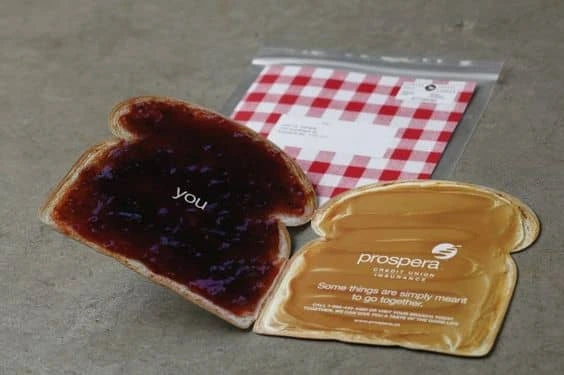
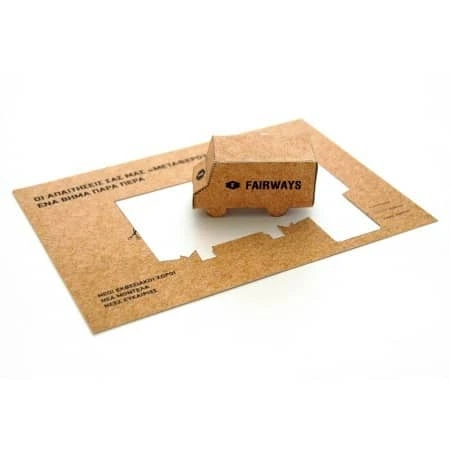
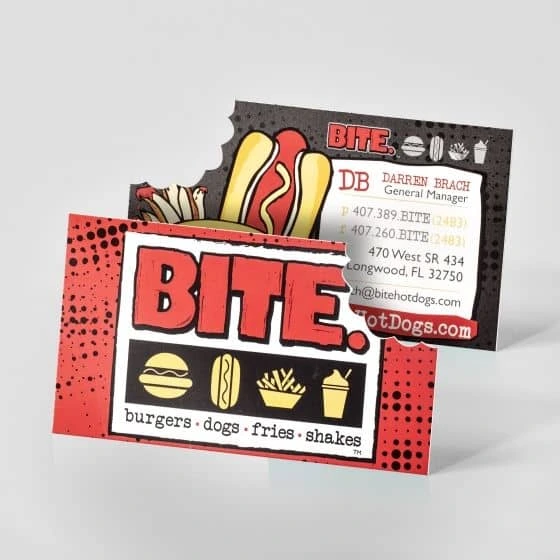
Key takeaway
Cutting direct mail from your marketing strategy because you assume it’s dead is misguided. Direct mail is still alive and well, and there are strong reasons to include it in a well-rounded campaign.
From higher ROI to stronger impact, brands are still reaping the benefits of direct mail today—and so can you. Bring these eleven reasons to your team the next time you’re planning a marketing campaign. They might just be surprised at the results.
Ready to build your own campaigns in minutes? Learn more about the direct mail features in Lucidpress, and give it a test drive.
When it comes to reaching your customers, one channel simply doesn’t cut it anymore. Consumers are researching brands through search, mobile, email, social media, in-store and a lot more, so it’s necessary for you to build an omnichannel marketing strategy that engages them across all platforms.
What is omnichannel marketing?
Omnichannel marketing is an extension of multichannel marketing. While multichannel marketing focuses on distributing content across various print and digital channels, omnichannel marketing focuses on creating a cohesive experience as a visitor moves from one channel to the next.
Benefits of omnichannel marketing
Not convinced? Here are more reasons to incorporate omnichannel marketing, both online and off, in your marketing plan.
1. Repetition reinforces your brand message
Imagine this:
A consumer sees an ad for your product on Facebook. She clicks it to visit your site but doesn’t make a purchase. She signs up for your emails while she’s there and clicks to follow your brand on Instagram.
In a few days, she gets an email inviting her to save 20% if she signs up for your text messages, so she does. Once she gets that offer via text, she makes her first purchase.
As you can see, the path to a sale isn’t always a straight line. If it had been, this person would have made a purchase at the first point of contact when she saw your ad. But, it took a few different messages on multiple channels to convince her to buy from you.
Being where your customers are online means you drive your marketing message home.
2. Creative consistency is key
You can’t simply plaster your message across a dozen marketing channels; you also have to be consistent in what you communicate. That means your brand logo and tone of voice need to be the same everywhere so that consumers recognize your brand and can let that message seep in.
There is one caveat: You don’t want to give identical offers or promotions on all marketing channels—it dilutes their effectiveness. You need to give people a reason to sign up for your emails, subscribe to text messages and follow you on social media, so make each offer exclusive to that channel.
3. All channels should lead back to your website
If you worry about confusing people with so many marketing channels, keep in mind your end goal: driving traffic back to your website so you can make a sale if you sell online. Your social media updates should include a link to the product that you’re promoting. Your emails should contain one link and one call-to-action each so that customers know exactly what you want them to do. Online ads should link back to your site.
The great thing about omnichannel marketing is that it’s so easily tracked, both online and off. You can look at your website analytics to see which channels sent traffic to your site and step up your investment on those channels or pull back from ones that aren’t getting results.
Offline, you can measure redemption of text message offers or coupons you post on coupon sites by using unique offer codes that you track through your point-of-sale system.
When you know what’s driving traffic and sales, you can tweak your marketing plan to give even better results with channels and types of offers that are appealing to your customers.
4. It’s great for new businesses
Omnichannel marketing isn’t just for well-established retail brands with giant marketing budgets. If you’re a new business, spreading the love across marketing channels can establish a foothold for your brand identity.
You may even get to know your customers better as you pay attention to how they respond to your messages on different marketing channels. Let’s say you start using Instagram to market your product, which is geared toward baby boomers. You might quickly learn that not many boomers use Instagram, and branded content targeting this demographic on Facebook gets you much better engagement.
5. You can reach different customer segments
You may market to different types of customers, who more than likely have different habits when it comes to interacting with brands online. The more channels you use to reach these disparate groups, the more successful you will be.
You can reach Gen Z through mobile and Gen X through social media at the same time. You can help boomers find you with print or online ads. You can appeal to moms, teens and outdoor types… all through slightly different marketing strategies that don’t exclude the others.
The more granular you are in marketing directly to a slice of a customer segment, the more successful you will be, because they feel like you are speaking directly to them with your message.
6. You get instant results
A few years ago, when print coupons were more popular, it would take you months to know whether a coupon campaign was successful or not. The same went for print advertising or TV spots.
But now, digital marketing has revolutionized the way we launch, modify and analyze marketing campaigns. You can see the results of your efforts in real time. If, after a few days, your social media ad isn’t moving the needle, you can easily modify the copy or the offer to see if you can improve results.
Mobile coupons are great for instant analysis, too. Your mobile marketing dashboard will inform you how many redemptions a given offer has had. You can use that data to decide whether you want to offer something similar in the future or test out a different offer.
The instantaneous benefit applies to connecting with customers in real time, too. If someone has a question about your brand, they can ask it on your Facebook page’s Messenger. You (or your handy chatbot) can answer the question immediately, delighting the customer with your prompt response.
7. You can build loyalty
One of the best ways to boost your business is by creating a loyalty program that encourages customers to shop with you more to earn points they can use on free products or get personalized discounts.
Omnichannel marketing works well with loyalty programs: Shoppers can sign up in seconds at the point-of-sale using their mobile wallet, get offers via push notifications or email, and check their balance online or on their phones.
Key takeaway
Marketing has certainly changed over the years. The key is rolling with those changes and diversifying where you try to connect with your audience. With so many wonderful channels to do so, you can customize your approach to maximize results.
Want to learn more about the power of consistent brand marketing? Download our free 32-page report, chock full of stats & great insights.
Twitter began in 2006 as an online message board that was updated via text message. Since then, it’s grown into one of the largest social networks, boasting more than 300 million users who combine to produce 500 million tweets daily.
Related: How to drive traffic with social media
Marketers have been slow to catch on to Twitter, though. Recent reports estimate that only 65% of businesses use the platform for advertising, which gives you plenty of time to get ahead before the rest of the competition arrives and sets up shop.
In case you need more convincing, these 11 benefits of using Twitter for marketing can help you cross the divide.
1. Direct messaging creates genuine connections
Like its main competitors, Twitter has a direct messaging feature for private conversations between two users. However, the main difference is that the two accounts must mutually follow each other (unless one user has their inbox set to “open”) before they can contact one another.
This might seem like a hurdle for marketers who want to connect with influencers or other important industry players, but reserving direct messaging for mutuals ensures your conversations are worthwhile, engaging, personalized and authentic.
2. Tags encourage engagements
The @ symbol on Twitter goes a long way. It’s the key to sending other users a notification that almost guarantees your tweet, or the tweet you wanted the @ recipient to see, gets viewed. Also, it’s easy attribution for a quote or an article you share on the platform.
Twitter has branched into content discovery, so users now see occasional tweets from people they might not even follow. This is more likely if multiple users in a network like a tweet. The algorithm then guesses you might also want to see content similar to what’s already in your network. With this feature, your tweets with engagement can end up in front of new eyes, thus increasing reach and engagement.
3. Posting multiple times per day is expected, not annoying
According to data averaged from multiple studies, Twitter is the only social network where marketers are recommended to post up to 15 times per day. Unlike its main competitors, Facebook and Instagram, Twitter is still heavily chronological. Tweets have such a short lifespan in the ongoing feed of posts that regular updates are necessary to stay relevant.
Marketers should take this opportunity to integrate a varied mix of content that entertains and educates their Twitter following and keeps them engaged. The platform allows text, images, video, live video and polls that can all encourage conversation in different ways.
4. Twitter best showcases your brand voice
With a more robust posting schedule, Twitter is a network where a brand can develop its voice and public personality. Depending on the industry, tweets can have an authoritative voice or even a sassy tone.
Fast food companies have revolutionized branding with Twitter in an especially notable (and comedic) way, from the rap battle between Wendy’s and Wingstop to the clapbacks from Taco Bell. Even forgotten brands like MoonPie have been resurrected via Twitter; now MoonPie has a strong following of 279,000 that look forward to its self-deprecating humor on a daily basis.
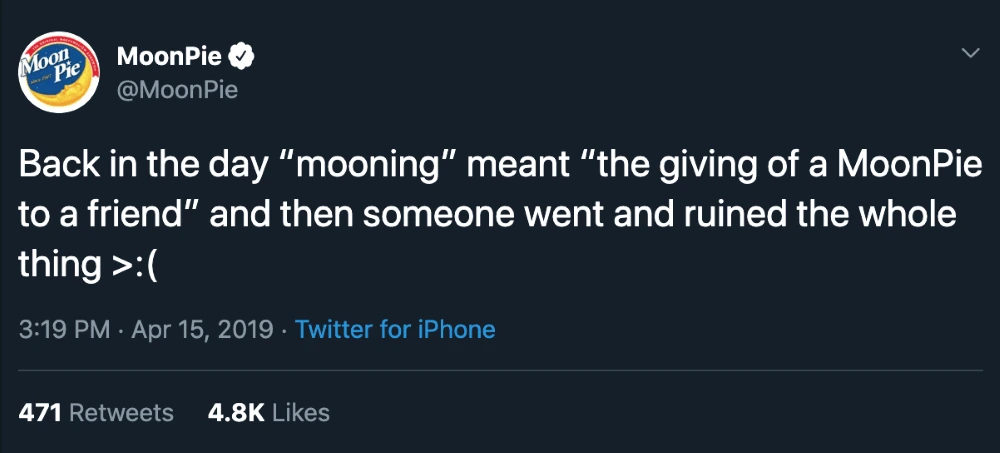
Source: Twitter
Your consistent brand voice is also archived for prospective customers who are using Twitter to research how you interact with your followers. Twitter’s open format leaves nothing to the imagination, and some have experienced the fallout when old, problematic tweets resurface at inopportune times.
5. TweetDeck lets your monitor Twitter for free
If you have a Twitter account, you also have access to TweetDeck. It’s a free tool that specializes in monitoring. Simply identify accounts, keywords or hashtags you want to follow, and watch as TweetDeck creates individual feeds for your selected parameters. This is an effective way to stay in the conversation, because you don’t have to use the main Twitter platform to search keywords one by one and possibly miss an important tweet.
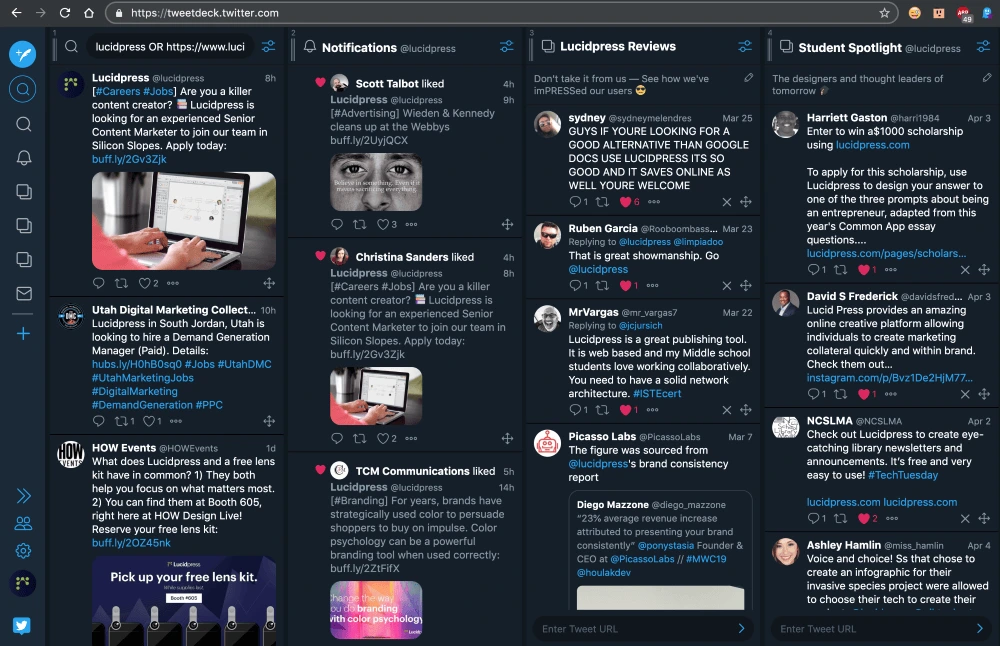
The Lucidpress TweetDeck
TweetDeck lets you watch your competitors’ activity and community all at once, which makes it an impactful tool for poaching customers. For example, if you see a user complain about a competing brand because you’re tracking their name as a keyword, you can reply and recommend your brand as a viable solution that addresses their pain points.
Keyword monitoring also keeps marketers in-tune with discussions about relevant industries, so future strategy can address industry topics. Rihanna’s company, Fenty Beauty, is popular for its vast array of makeup shades designed for all skin tones. By identifying a pain point—makeup is non-inclusive to people with darker skin tones—the company addressed it with real action and enjoys success because of it.
6. Influencers can boost your campaigns
In 2019, there’s no doubting the power of the influencer, a modern-day social media celebrity. Marketers have found that influencer campaigns yield an average return of around $7.65 for every $1 spent. However, Instagram is oversaturated with individuals pushing products, which makes influencer campaigns that much fresher on other social networking sites.
Twitter, in particular, has massive potential for marketers. That’s because there’s a 2x increase in purchase intent when consumers see tweets from both brands and influencers. Also, 49% of Twitter users responded that they rely on recommendations from influencers, and 40% have made a purchase solely based on a tweet from an influencer. The numbers don’t lie, and they show an opportunity marketers can’t find in many other places.
7. Your profile will drive traffic to your site
Social media profiles are the new homepage. [] As mentioned earlier, Twitter is the place to develop and showcase a brand voice, so users will often visit a brand’s Twitter profile to get a better feel for the brand. About half the time, that visit will inspire further research, namely due to the fact that 47% of the people who visit a Twitter profile also visit the website linked to that profile.
Marketers should keep in mind that brand voice should be consistent and seamless across channels, so a playful Twitter account shouldn’t lead to a landing page with overly serious language. Otherwise, consumers will end up confused and leave the page without converting.
8. Follower insights help you develop your follower persona
Twitter users are given native analytics within the platform, and they’re some of the best across social media sites. In particular, the Audiences tab helps marketers paint a picture of their average follower.
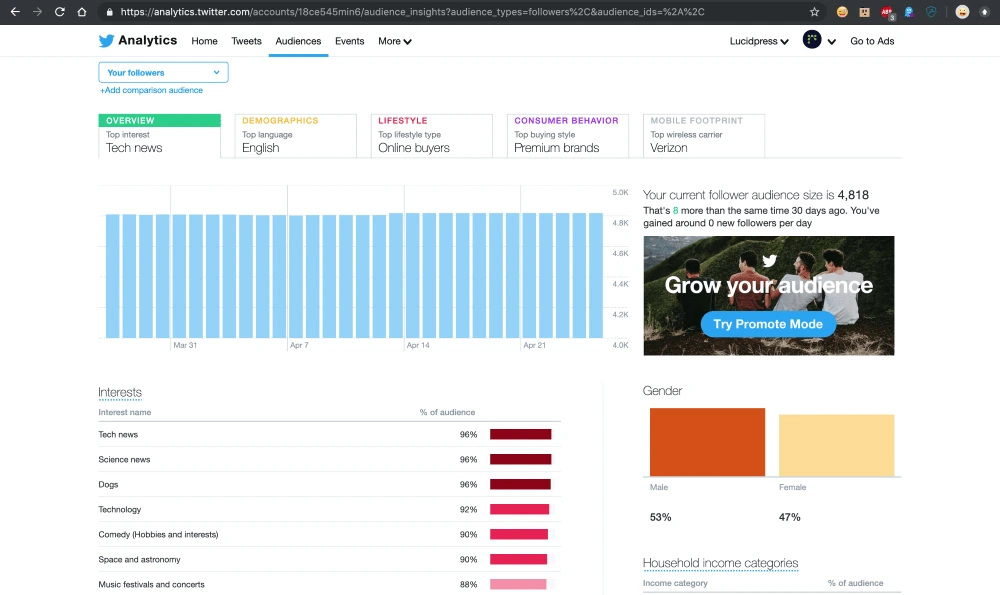
The Lucidpress Audiences tab
Audiences has four categories: Demographics, Lifestyle, Consumer Behavior and Mobile Footprint. The data delivers insight into your followers and their interests—as well as how they interact with brands, which is helpful to know before launching a campaign. With your follower persona in mind, you can aim directly for Twitter users who match the kind of people following you already.
9. Advertising spend is low & effective
Advertising on Twitter costs as little as one dollar per day, but its real strength is optimization. Twitter Ads guides marketers of all experience levels through the campaign creation process by suggesting parameters to maximize impact. Then, if the setting is selected, the platform will pace spending based on results to ensure marketers aren’t spending unnecessarily.
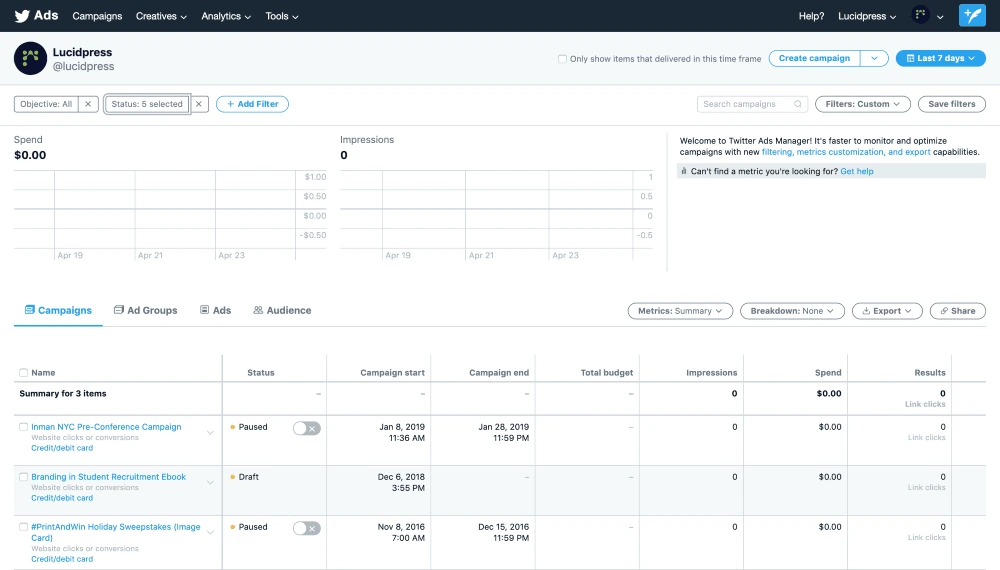
A heavily filtered version of Lucidpress Twitter ads (can’t give away all our secrets!)
As you gain experience, you can also experiment with A/B testing, using different campaign types or applying other settings. It’s customizable and incredibly user-friendly. The best part? Independent research shows that Twitter marketing campaigns can deliver 40% higher return on investment when compared to other media channels.
10. Community management is possible with branded hashtags
Hashtags are still the king of social media discovery tools, especially when marketers use branded hashtags. Created by brands to give consumers a way to share their experiences on social channels, branded hashtags comprise 70% of the total hashtag landscape.
Marketers can use these niche spaces to easily follow their brand communities online. Whether it’s to participate in a Twitter conversation or to find user-generated content for future tweets, there’s tremendous potential.
11. Anyone can go viral
One of the best parts of Twitter is its capability to spread a message like wildfire. Anyone who uses the platform regularly sees multiple tweets per day reach viral status because they’re funny, relatable or newsworthy. Those tweets can come from anyone, no matter how few followers they might have.
Brands can similarly go viral with a tweet, which immediately increases reach, traffic and conversions. All it takes is a well-timed post that resonates. The sky—or, should we say, the 280-character count—is the limit.
What are you waiting for?
Follow @lucidpress on Twitter today! Just kidding. …Mostly. Okay, here’s what we were actually going to say.
Twitter is a unique marketing channel with huge opportunities for brands looking for a new way to reach prospective customers. It’s not yet full of business accounts, and it has maintained the authenticity that’s lacking on other social media sites—which has resulted in a dedicated user base that’s tired of Instagram’s careful curation and Facebook’s fake news.
Marketers always need to have new tricks up their sleeve to adapt to the ever-changing landscape of digital advertising. They should not overlook Twitter if they want to make an impact. It’s perhaps one of the purest platforms left, and the possibilities are wide-open to incoming brands.
Ready to design your own branded Twitter content? Hop over to our free Twitter template gallery and get started!
Today, most companies prefer the ease and lower costs of digital marketing as a substitute for regular print marketing. But while social media and digital advertising might now be the default, print advertising can still be an incredibly effective way to reach your target market.
Studies show that nearly 80% of consumers act on messaging they’ve seen in magazine ads, compared to just 45% of consumers who act on online advertisements. There’s a huge opportunity for influence here. In fact, 82% of consumers trust print ads the most when making a purchase decision.
When used in conjunction with digital marketing tactics, print marketing strategies like placing magazine ads can make your campaigns even more effective. In this guide, we’ll walk you through how to design and make a magazine ad that will help get your business in front of the right audiences.
How to design a magazine ad
There’s a lot that goes into creating a successful magazine ad, and it’s easy to feel like the best magazine ads are difficult to design. From understanding who you’re trying to reach to choosing the right publication, there’s plenty of strategy at play here.
In this blog though, we’re zooming into the design process. To help your page ad stand out on the page, we’ve assembled some basic graphic design principles that will give you the foundation you need to begin.
First off, one of the most basic (but most important) principles of good ad design:
Use color to your advantage
Take a look at a color wheel. When designing your magazine ad, you’ll want to not only choose colors that represent your brand, but colors that provide good contrast. If you’re having trouble, consider using complementary colors – these work well together and can be found opposite each other on the color wheel.
But don’t be afraid to get creative with other color palette options as well, as pictured below.
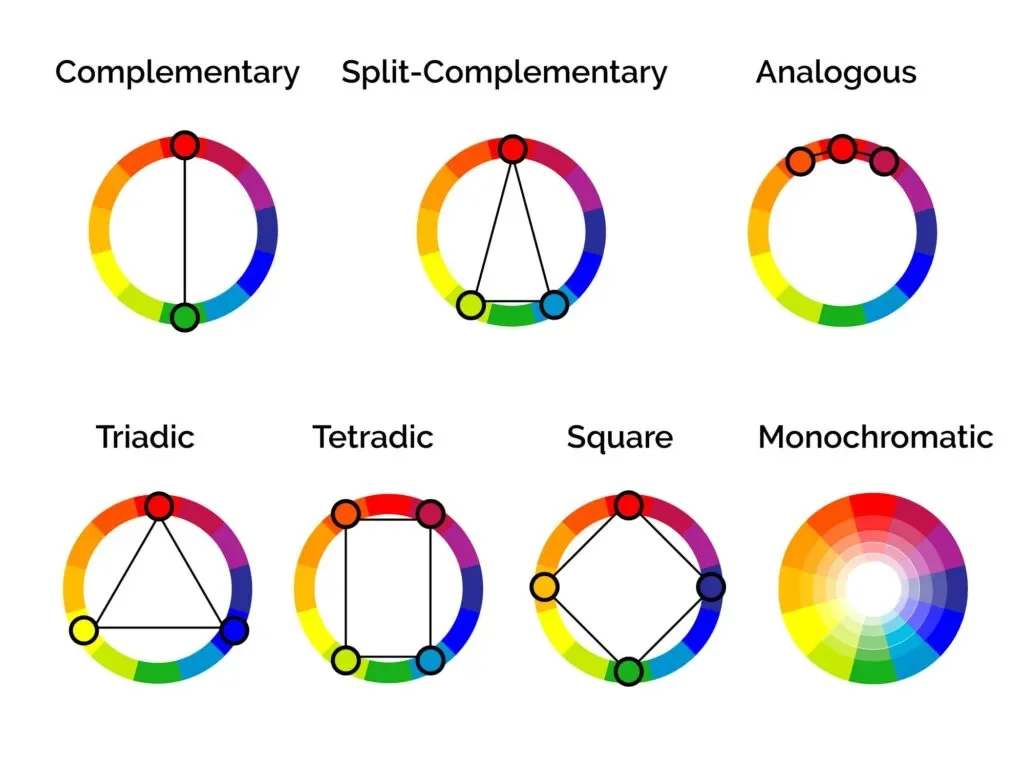
To mix up your color scheme, you can use different hues, shades and tones of the colors you’ve already chosen.
Check out this great example of using complementary colors (blue-green and red-orange) to make this Colgate brand’s ad pop.
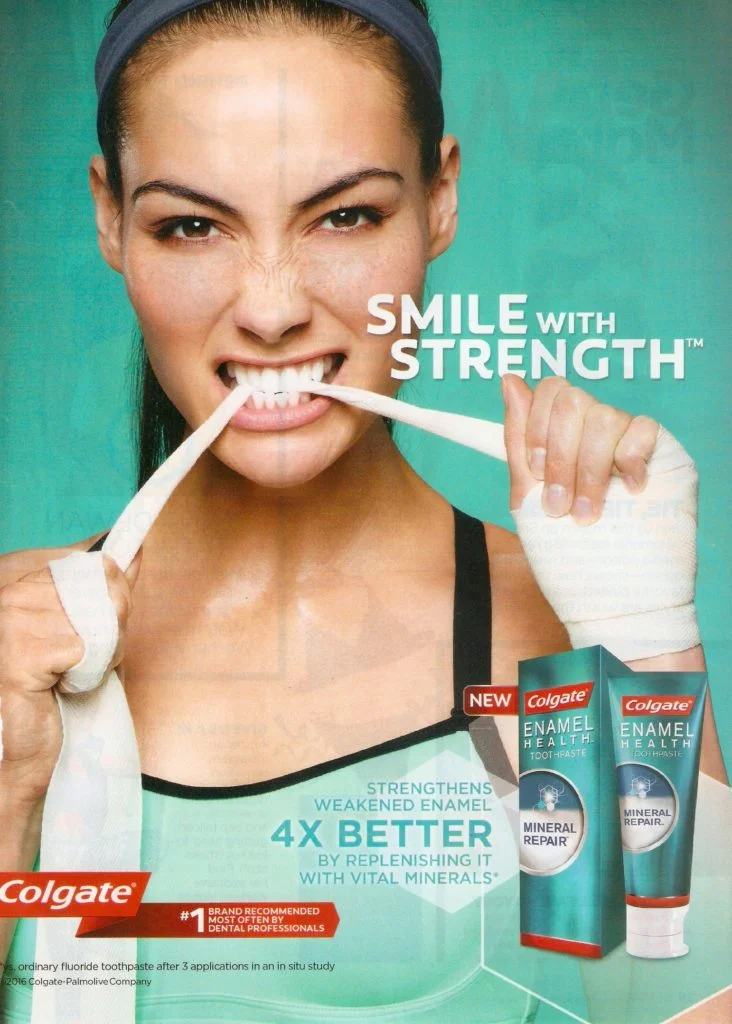
When choosing your palette, don’t forget to consider the psychology of color as well. For example, yellow is often seen as cheerful and playful, while grey and black can signify luxury or utility.
Be careful when using bold, bright or loud colors on your print ad. It’s easy for the focus of your main message to be lost in a see of loud colors if you’re not intentional. You can use bold color for accenting or to make a certain message or image stand out in your graphic design, but use it sparingly. For example, pay attention to how Nike uses the color red to draw attention to its signature ‘swoosh’ in this graphic design example:

Create a sense of balance
While your design doesn’t have to be a perfect mirror-image on both sides, it should have some sense of balance that creates unity and ties your whole design together. An easy way to create balance is to use the rule of thirds. Basically, this means that if you divide your image into thirds, you should center your main focal point on the outer vertical line and center it on the horizontal lines. This makes your photo more dynamic and interesting to look at. For example, check out how this ad centers its main subject – the couple – on the horizontal lines.
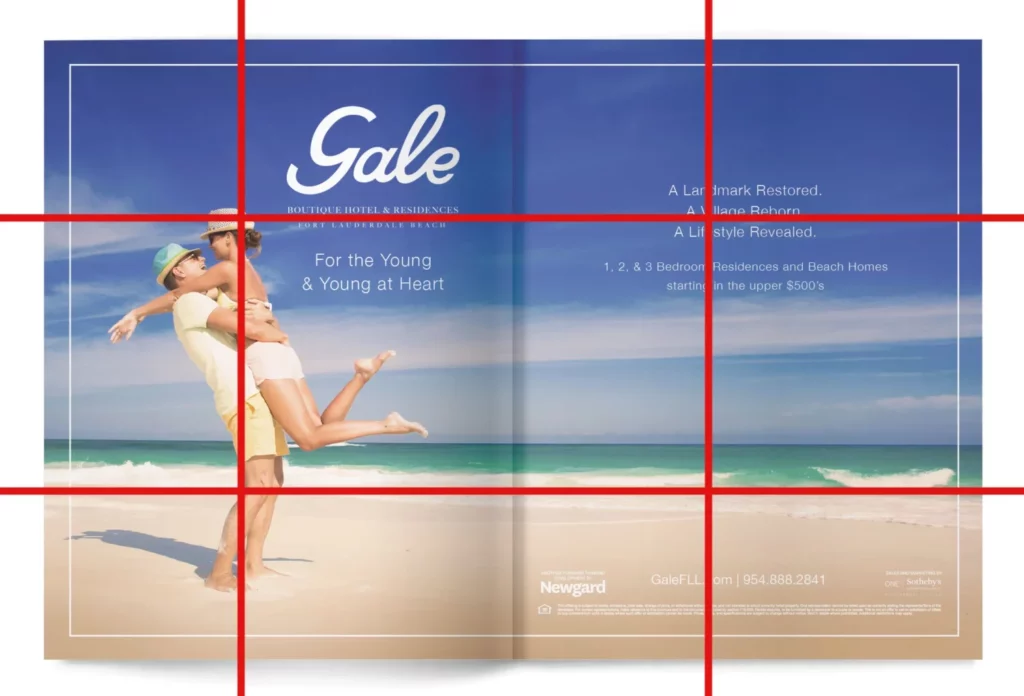
If you’re having a hard time finding the right way to balance your design, try viewing your layout under a grid. This will help you create an underlying unity and structure for your design.
Use the right font
You’ll want to make sure your font and font size are consistent with your other marketing materials. Additionally, make sure your font is applied consistently throughout your magazine ad design.
Typically, sans serif fonts are used for headings, while serif fonts are used for body text. Here are a few examples of popular font pairings:
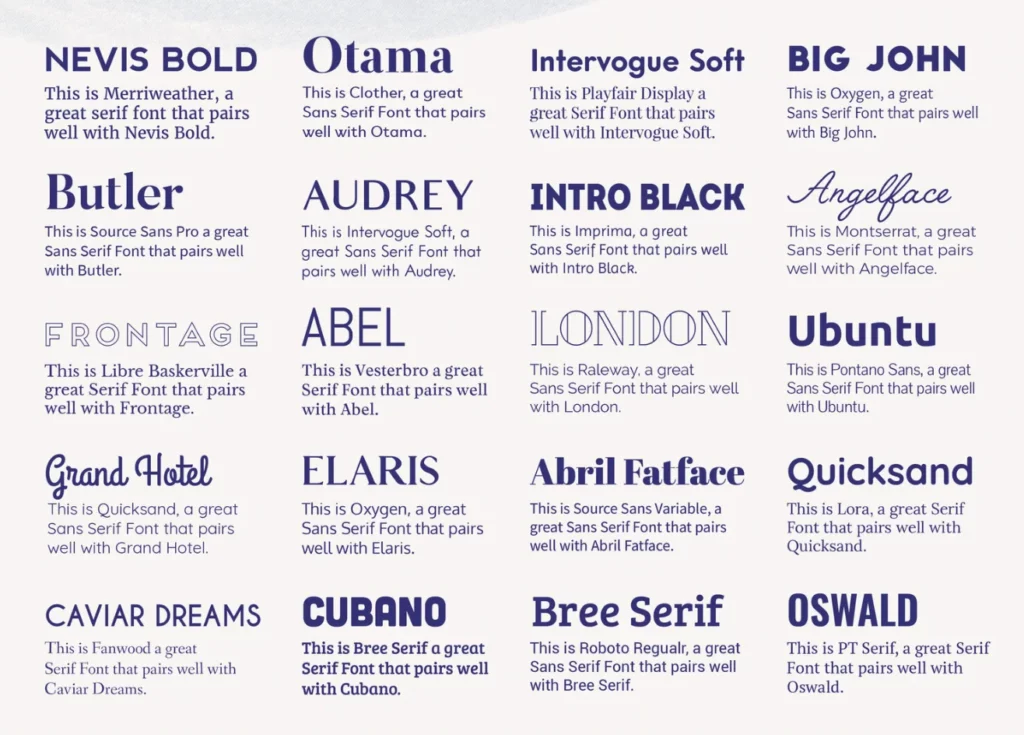
Using sans serif versus serif fonts can provide contrast between your heading and your paragraph type. You can also contrast type by using different:
- Colors
- Sizes
- Structures
- Thickness of the font
- Typeface
- Weights
Just remember as we mentioned before, it’s not a good idea to use a different font than you use in your other marketing materials. Sticking with the same (or a similar) font will build brand consistency over time, helping people remember your brand.
Apply the Gestalt principle
The Gestalt principle argues that the human eye sees objects in their entirety before perceiving their individual parts. You can use this principle to help you make a better design. There are five parts that make up the Gestalt principle:
- Figure/Ground: Similar elements (figure) are contrasted with dissimilar elements (ground) to give the impression of a whole. Oftentimes, you’ll see this principle applied in movie poster design:

- Similarity: When objects look similar to each other, people perceive them as a group or a pattern and see them as belonging together, even if they’re not close together in a design.

- Closure: Our brain will see patterns and fill in the blanks, even when certain information is missing. This ‘triangle’ is a great example – it’s not actually there, but our eyes fill in the missing pieces.

- Proximity: When elements are close together, people will perceive them as a group. A woman and young boy posed together create a scene of a mother and son, and covey a sense of safety.
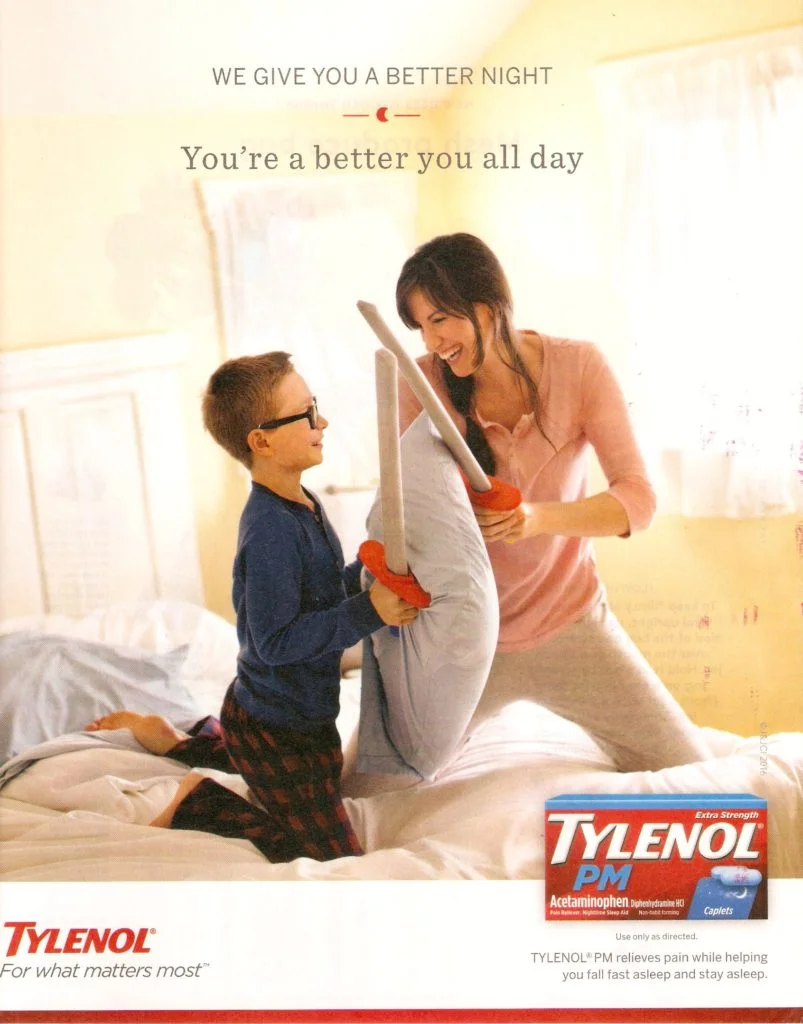
- Continuation: Using direction to move the eye from one object to another. The Coca-Cola logo is a master example of this principle in action. Our eye’s naturally follow the curvature of the ‘C’, creating a sense of movement and dynamism.
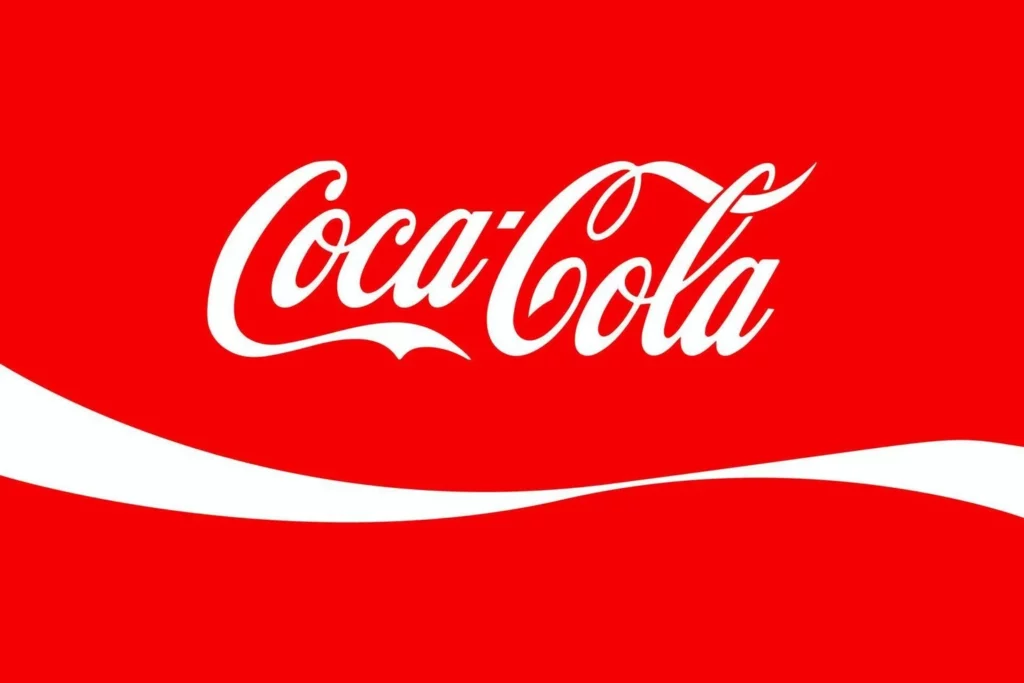
Use signs and symbols that are significant to your consumers
Are there any symbols that carry a significant meaning to your customers? You can use them to help your consumers create quick associations within your magazine ad.
For example, seeing a “stop” sign automatically creates a subconscious signal to stop and pay attention.
More best practices for making a magazine ad
Here are a couple other general tips for creating a great magazine ad design
Write a good headline
It should go without saying, but writing a powerful headline takes time. Don’t just go with the first one you come up with. Take the time to craft a headline that catches the reader’s attention and draws them in.
Use powerful images
What do you want your images to convey? Intentionally choosing your imagery can help your message make that much more of an impact. Also, don’t forget to make sure your images look professional and aren’t pixelated.
Use engaging copy
Keep it simple. You can let the images do most of the talking here, and chances are, there won’t be a lot of room for copy. Be concise, point out a problem, then identify your solution to that problem.
Proper logo use
Your logo will need to be included somewhere, but don’t make the mistake of making it the most important thing on the page. If possible, let it become part of the overall design. And, don’t hide your logo away in the copy — give it some space so it stands out.
Include a call-to-action
Ask yourself what you want your readers to do because of your ad. Include a call-to-action at the end of your copy that encourages them to take action and gives them the resources to do so. For example, if you want people to engage with you on social media, include a branded hashtag they can use to tag your company with.
Well-designed print ad campaign examples
Here are a few recent favorites we’ve come across – can you identity the design principles they use?


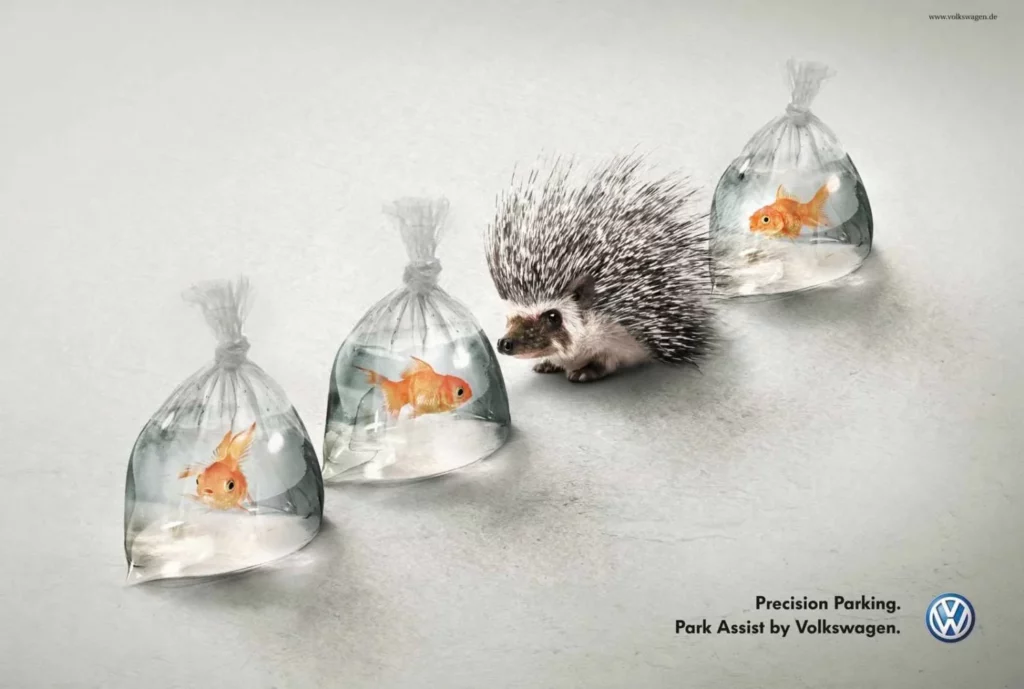
Key takeaways
Print is a classic form of marketing that we don’t ever think will go out of style. These five basic design principles and best practices will help give you all the foundation you need to get started on your magazine ad design. Want even more of a head start in graphic design? Check out Marq’s free library of templates, or begin designing your own magazine with prebuilt design elements today.
Advertising is more than just a brand function—it’s a valuable skill. Not all people have the talent, timing and savvy to speak to people in a way that influences their lifestyle. Fortunately, the knack for advertising and marketing can be learned.
There are many different forms of advertising that brands can use to reach their target markets. However, not all forms of advertising will have the same impact. Technology trends have shifted the game. Today, brand managers can drive tremendous impact by prioritizing social media.
But before you get into the specifics of social media marketing, you must first learn the basics of advertising. Here are some advertising do’s and don’ts for beginners.
The do’s: Helpful advertising tips to help you connect with an audience
Get to know your target customers
Many companies only have a big-picture view of the target market they want to reach. While this is a good starting point, it pays to refine your understanding of prospective customers. What is the age bracket of the people you want to reach? Are your prospects still studying, seeking career opportunities, employed or retired? What types of entertainment do they usually spend their time and money on? These aspects are vital if you want to make an impact that will truly resonate with your desired audience.
By knowing what makes your customers tick, you have leverage to connect with them and understand how to best fulfill their needs.
Strive to have a consistent voice & message
While it’s true you can have an impact by being unpredictable, you build up a stronger following by being consistent. By having a singular purpose and consistent voice, you increase brand recognition and loyalty. Stick to the vision and mission of your business, and soon, people will recognize your brand across every advertising channel you use.
Be accessible & proactive
People are more likely to trust a brand if they’re confident they can reach you whenever they need to. No wonder nearly every business has social media profiles now. Through sites like Facebook, Twitter and Pinterest, you have a direct line to your customers.
The question is: will people hear back from your company when they tag, message or tweet you?
If you’re strapped for resources, hire a virtual assistant to help your brand stay accessible and proactive not just on social media but also through email and comments on your blog or website.
The don’ts: Pitfalls your brand should avoid
Failing to craft a call-to-action
Share this message if you agree. Email this tip to a friend. Tap ‘like’ if you enjoyed this video. These are just a few of the calls-to-action that social media users have grown familiar with, and that’s because they work. Each communication you share with your audience should be geared towards building your relationship and, ultimately, moving them down the conversion funnel. At the end of any ad campaign, make sure your audience knows what to do next.
Jumping on every advertising fad that comes along
Many advertising gimmicks have come and gone, but how many of these have really helped the brands who tried them? Just because a tool, fad or practice is creating some noise doesn’t mean you should immediately jump in. When a new trendy tactic tempts you, scrutinize how it will genuinely reach your customers and build your brand. This goes back to the principle of knowing your target audience better. If you truly know what makes them tick, you won’t be jumping on every bandwagon that rolls by. Just the ones that matter.
Making an impact isn’t exclusively for big brands. Keep in mind these advertising dos and don’ts for beginners, and you will soon carve out your own niche.
How to use PPC to amplify your brand
As you know, effective branding amplifies brand awareness and recognition. It builds trust. It helps generate new customers. Best of all, it increases sales and revenue.
But, did you know that even the briefest exposure to a brand can affect a customer’s behavior? It’s true. You have the opportunity to shape customers’ opinions of your brand in every interaction—even if that interaction only lasts a couple of seconds, like a pay-per-click ad.
Why branding is important
To set the scene, let’s take a look at why branding matters in the first place.
Researchers at Duke University determined how powerful brands can be. In one of their tests, a group of university students was exposed to the Apple logo. It was flashed so quickly that respondents weren’t even aware they were exposed to it. Another group was exposed to the IBM logo in the same manner.
Both groups were asked to list down all of the possible uses for a brick. Here’s where it gets fascinating: Participants who had a brief glimpse of the Apple logo were found to be more creative when compared to the IBM group.
Here’s another one. Researchers wanted to know how brands affect respondents’ honesty. In the next experiment, two separate groups were exposed to the Disney and E! logos, respectively. They found that participants who saw the Disney logo behaved more honestly compared to those who saw the E! logo.
What does this tell marketers? Brands are deeply influential. For established brands (like Apple and Disney), it could mean investing more in product placement and other methods of exposure. For growing brands, it means paying attention to every touchpoint, no matter how brief.
For example, your PPC campaigns.
How to use pay-per-click to enhance your brand
Known as PPC, pay-per-click campaigns are a great way to amplify your product or service. But, when done deliberately, PPC can also help you amplify your brand message. Here are a few techniques you can use to optimize your PPC campaigns for brand awareness.
Optimizing your ad’s exposure
- Use location targeting
Personalization refers to the process of adjusting content to match customers’ needs and preferences. More brands are putting extra effort into their personalization efforts, and chances are, your brand is already implementing a similar strategy. But, have you considered adding some personalization to your PPC ad copy?
For instance, you can customize ad copy and sitelinks based on your customers’ geographical locations. Let’s say you’re trying to make an ad for New York shoppers. In the ad, you can place sitelinks like the address of your store or products that are popular in New York. (Don’t forget to add call and location extensions—they shorten the conversion cycle.)
Divide target audience into groups you want to personalize. Next, create ads based on those groups’ preferences. Since the ads are location-based, consumers from other parts of the country or the world will not see the same content as those from New York. It’s an easy way to make your ad appear more relevant to the user.
- Select specific sitelinks
Which sitelinks do you often use in your ads? What you choose to promote can either benefit your campaign or hurt it. If you plan on advertising to a specific audience, don’t give them a general sitelink that isn’t relevant or interesting to them.
For example, Clinique organizes their ads according to the different stages of the buying cycle. This way, each ad caters to more specific needs.
Clinique used “Shop Makeup” on their ad for customers who only intend to buy makeup. They added “New Arrivals” for visitors who might be interested in more products. For prospective buyers, the brand offered a “Top Selling Skincare” sitelink, making it easier for visitors to evaluate their products. They then offered a discount on first purchases to sweeten the deal.
Building trust in your brand
Most of the time, PPC marketers create ads that are designed for conversion. But, what about visitors who aren’t ready to buy? What about consumers who want to know more about the brand before supporting it? Content marketing is great at building trust—and PPC campaigns are fantastic at delivering that content to target audiences.
- Use long-tail keywords
The long-tail keywords you use in your content marketing can also be used in your PPC campaigns. You can promote high-value content by using them as ads that match consumers’ search queries.
For instance, if you have makeup tutorials, you can create ads for queries like “how to apply foundation.” L’Oréal is one brand that practices this.
Googling “how to apply foundation” leads to a L’Oréal ad with the same keyword phrase. By providing content that consumers need, the company builds a reputation as an expert in the field. Consequently, they gain the consumers’ trust, which will lead to conversions down the road.
- Keep track of your reputation
Customers seek out the pros and cons of different brands before supporting them. Though your efforts to gain their trust are strong, a few negative remarks could be enough to drive them away.
So, what can you do about it?
Through your PPC campaigns, you can protect and maintain your brand’s reputation. By keeping track of search query reports (SQR), you can identify a rise in negative trends. You can then share this information with the marketing team and devise a strategy to deal with negative reviews and comments.
Key takeaway
PPC is a great platform for brand-building. Not only does it empower you to shape your brand’s story, it exposes large audiences to your message on-demand. [] Take advantage of this powerful medium and show the world what your brand is made of.
5 design bottlenecks in PPC advertising & how to prevent them
If you’re like most PPC advertisers, you’d rather not touch Adobe Photoshop with a ten-foot pole. There is a good chance that slaving away in Google AdWords or figuring out multi-touch attribution models sounds like more fun. But graphic design? No way.
In my younger PPC days when search campaigns were my only concern, I was the same way. I never expected that designing a marketing graphic would be an appropriate use of my time. That’s why we hire graphic designers, right?
Related: 4 ways to increase conversions with visual content
But PPC is much more than standard text ads showing up on a search engine results page. There are paid-social ads on Facebook and LinkedIn, display campaigns, native, remarketing, landing page creative, banner templates, etc. The list goes on.
But here’s the kicker: they all require graphic design assets.
And when your graphic designer is too busy to get the job done, you’re on your own. I know. That’s a scary thought. You might be thinking about how your next ad campaign should have launched yesterday… but first you need to hack your way through Photoshop?
There is a better way.
Here are 5 design bottlenecks that eat up a PPC manager’s time and how they can be avoided.
1. Getting a designer to make after-the-fact tweaks
Whether you outsource your graphic design or have in-house help, accessing a designer’s busy schedule is a struggle. But imagine that your designer just delivered a long-awaited piece of creative for a new Facebook ad campaign. You upload the content and launch the campaign. A week later however, ad fatigue sets in. Engagement and ROI are dropping fast. Since you’ve seen this before, you know what needs to be done—a simple tweak to the copy contained within the image. But when you ask the designer to make the change, you are asked to wait three weeks!
Solution: This sort of design bottleneck should not happen, but it does. You can prevent this by asking your designer to provide you with templates. With a templatized Facebook ad, you can use a simple graphic design software like Lucidpress to make the necessary tweaks. This will protect the integrity of the creative, while providing you with flexibility and independence. It is crucial for PPC advertisers to make tweaks frequently and quickly—whether it’s for your next A/B test or a fatigued paid-social ad. Making these tweaks should take minutes, not weeks.
2. Seeking approval at creative review for edits to a landing page
Nothing is more frustrating than sitting through a creative review while crossing your fingers that the creative director approves the concept for new hero images on your landing pages. Even worse, you may have to wait a week for the next meeting to roll around. Either way, your campaign’s launch date is probably getting pushed back.
Solution: First, work with your team to establish brand guidelines and a library of pre-approved images and copy. Sticking to these may grant you permission to skip creative review altogether. If that fails and you must still attend creative review, try petitioning your management team to hold the review process after the change has been A/B tested. If you’re not A/B testing every step of the PPC process, start now. Hard data will give you a strong voice at creative review. Lastly, plan ahead for projects that will require creative approval.
3. Endlessly searching for images to use on display campaigns
What should you do when your display campaign needs a refreshed set of images, but you’re not satisfied with Google’s display ad-builder? You may find yourself struggling to navigate the design team’s cluttered Dropbox folder. Or even worse, you might resort to copying & pasting from Google Images.
Solution: Recommend a Digital Asset Management software to your marketing team. There are several affordable options out there for DAM software. The goal is to quickly store, organize, retrieve and deploy your digital assets from a central location.
4. Your designer never has time for your projects and you don’t know Photoshop.
This is the obvious one. And yet so many PPC marketers do nothing about it.
Solution: There are cloud-based design tools for almost every situation, no matter your design experience. Need to make heavy edits to a photo? Try Pixlr. For infographics, check out Visme. Want to add pretty text to your marketing graphics? Lucidpress was built to do just that, and much more.
In recent years, graphic design has been democratized. For anything less than a complicated design project, you shouldn’t need a degree or expensive software. []
5. Cracking down on an affiliate or channel partner using rogue content
Have you ever had a VP or director ask why they stumbled onto one of your display ads and saw misspelled words or blurry images? I have. First, you panic. Then you search for the source and discover that it was actually one of your affiliates! Now you must spend valuable time working with the partner to correct the mistake.
Solution: This calls for a combination of some solutions listed above. Start with templatizing your partners’ ad campaigns. Then, provide them with the brand style guide and access to the appropriate folders in your Digital Asset Management tool.
Lastly, use these tools to empower your partners. Rather than just giving them constraints, teach them the principles that your marketing approach is founded upon. (Use your brand guidelines to accomplish this in a time-effective manner.) Because you hired these affiliates to provide additional volume to your marketing, consider crafting them into thought partners. Have them A/B test the newer, riskier ideas that you don’t have time for. In short, be proactive instead of reactive.
To conclude, design bottlenecks eat up the time that should belong to you and your designers. With the right tools and strategies, you can avoid these bottlenecks. Your designers will love you, and you can focus on making more money.
Digital advertising is a multi-billion dollar industry — and, as more and more people get on the web, it’s only getting bigger. Needless to say, that’s a lot of money. Stats like that can make digital advertising feel inaccessible for small businesses, but anyone can use digital advertising to grow their business. You just need the right resources to get started. That’s where this post comes in. In this post, we’ll break down everything you need to know — from sizing to design — to create your own banner ads!
What are banner ads?
Let’s start with the basics: banner ads. Banner ads are a staple of digital marketing. They’re simple, effective and can be displayed on nearly any web page — if you’ve ever used the internet, you’ve seen dozens of them, even if you don’t know them by their “technical” term.
You know the ads that span the top of a website? Or are stacked along the sides? Or the tall skinny ones along the edge of your browser window? Those are all banner ads.
A banner ad is a rectangular advertisement displayed on a web page to drive traffic to another site or increase product and brand visibility. Much like billboards, banner ads typically use text sparingly, relying on images and visuals to attract attention.
Banner ads come in various shapes and sizes — and it can be hard to choose which ad size to use. Unfortunately, we can’t make that decision for you. But we can show you your options.
See the image below for some of the most common banner ad dimensions and types! (Once you’ve chosen a size for your banner ad, you’ll probably want to jump right into the design — and with Lucidpress, a free online banner maker, you can!)
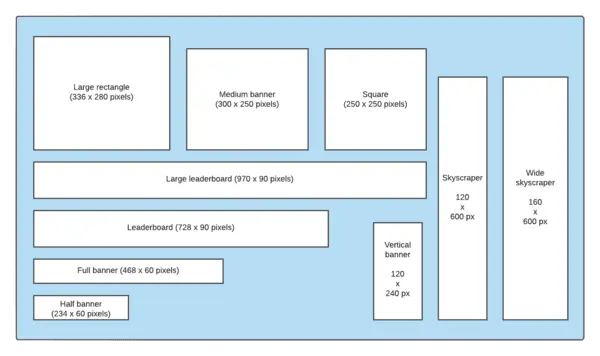

How banner ads work
There are two sides to the world of digital advertising: buying and selling.
- Buyers are the people with ads. Aka advertisers. These buyers have ads that they want to display across a number of webpages.
- Sellers, also known as dealers, are the owners of websites. For a price, they allow people — the buyers — to display ads in certain locations on their web page. Think of it as a virtual real estate market: Sellers have several available “plots” to display ads. And naturally, prime real estate (we’ll get into this later) is more expensive.
For this post, we’re going to assume you’re a buyer — someone with banner ads to display. At this point, you might have one looming, big question: How do you go about locating sellers?
Display networks and pricing
Enter a display network of your choice, the middleman that will connect you with sellers. (You’ve likely heard of Google AdSense, Google’s display network, but there are many other options to choose from too!)
A display network does the heavy lifting on both ends. Sellers add a few lines of code to their website’s codebase, and the display network will automatically populate the site with ads. For each click the ad gets, the display network pays the seller a commission.
Advertisers — like you — bid on advertising spots. The display network takes the highest bidder’s banner ad (and money) and displays it on various sites across the internet. As an advertiser, you’ll likely have control over the types of sites your ad is appearing on. Placement, however, is up to the seller.
Pricing models: CPM vs. CPC
Before you start bidding on ad placement, it’s important to know exactly what you’re paying for. Display networks typically use one of two pricing models for banner ads:
- Cost per mille (CPM) — With cost per mille, you’re bidding on how much you will pay for 1000 impressions (or views).
- Dost per click (CPC) — Cost per click is what it sounds like. You are bidding on how much you will pay each time a viewer clicks on your banner ad.
One pricing model isn’t necessarily better than the other — it all depends on your goals with an ad. If you’re trying to drive traffic to your site or generate leads, CPC might give you better ROI. But if you’re just trying to raise brand awareness, you might consider going with CPM.
Why use banner advertising?
To grow your business, you have to reach potential customers and convert them into paying customers. It’s as simple as that. Or at least it’s simple in theory. In practice, this process takes a lot of work — and time.
SEO is the tried and true method for reaching new customers. If you rank well in Google, your site will see a lot of traffic — and if you see a lot of traffic… You know the rest. You’ll steadily build your customer base. Here’s the problem: SEO takes time. It should be your long game, not something to rely on in a time crunch.
This is where banner advertising comes in. Compared to other marketing strategies — SEO, newsletters, etc. — web banners require relatively little work. You have to make the ad, sure, but you’re not responsible for getting it to an audience — you’re paying the display network to do that. Used in coordination with other marketing avenues, this can help create a steady and sustainable stream of leads.
Metrics to measure success
For a lot of marketing teams, banner advertising is all about click-through rates (or CTRs). How many people are clicking on your ad? While this is a great place to start, you should not rely solely on CTRs to measure the success of your banner advertising campaigns.
The truth is, there’s no “right” way to measure the success of your banner advertisements. The metrics you use to measure success will depend on your goals.
For instance, if your goal is to drive registration, you’ll need to look a little deeper than the CTRs of your ads — how many people are clicking on the ad and then registering? Or maybe your goal is to raise brand awareness. It’s hard to quantify your ads’ effect on viewers, but we can tell you this much: The CTR of an ad doesn’t give you any info about the impact it had. In these situations, views might be the best metric.
Best practices for creating a banner ad
Creating a compelling, effective banner ad isn’t always easy. And there are no hard and fast rules telling you how to create the best ads for your business. So we’ve included a list of best practices and various suggestions to help you get started:
- Use visuals: Banner ads typically appear at the edges of a browser window — areas where a viewer’s eyes will occasionally glance. A big ole block of text isn’t going to grab their attention, but a high-quality visual will. Browse our collection of banner templates for ideas.
- Keep it on-brand: Remember that your banner advertisements will be many viewers’ first impression of your company. So keep the ads on brand!
- Include a CTA: Visuals can help reel viewers in, but you need something to seal the deal. What’s your end goal? A call to action, also known as a CTA, can help convert viewers to new customers. Keep your CTAs brief and to the point.
- Keep it simple: Maybe it’s just us, but we rarely linger on banner ads — especially if they’re overly complicated and an eyesore. Viewers should be able to take your ad in almost instantaneously. This is only possible if you keep it simple: Include a visual and minimal text.
Banner ad examples
Before creating your own banner ads, let’s take a look at some examples. (A picture’s worth a thousand words, right?) We’ve encountered dozens of banner ads in the last week — the examples below are some of the highlights.
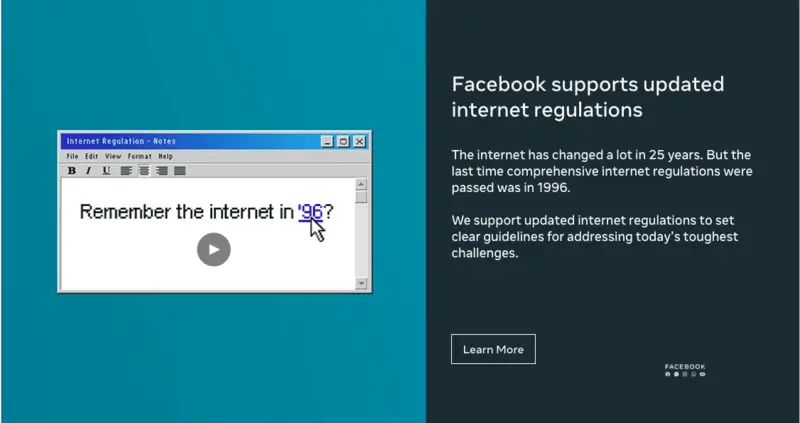
This Facebook ad may seem a little serious, but they considered their audience well — the ad showed up on the New York Times home page. The image on the left draws you in, while the text on the right communicates the ad’s point. There’s even a CTA at the bottom!

Another Facebook ad, really? This ad contains very similar content to the one above but in a much more compact format. Notice how they were still able to include a graphic, CTA and text.


This ad is a master class in simplicity. There’s an engaging image, catchy headline and succinct statement of purpose. And, of course, a call to action!

In this ad — available as a customizable banner ad template through Lucidpress — the central photograph is eye-catching but not distracting. The text succinctly communicates the ad’s purpose and includes a CTA.

This ad balances each half perfectly. There’s a pop of color and a neutral area; text and photographs. Together it creates a simple, elegant banner ad.
Ready to create your own banner ads? Get some more inspiration from our free banner ad templates! They’re completely customizable, giving you the flexibility you need to create unique, eye-catching ads of your own.
Creating banners for social media and display campaigns can be a daunting undertaking, especially if you don’t have a creative team to help out. As a small business owner, this task may fall to you. Here are 15 banner design ideas to check out and help you get started.
Banner ad ideas
Business medium rectangle banner (300 x 250)
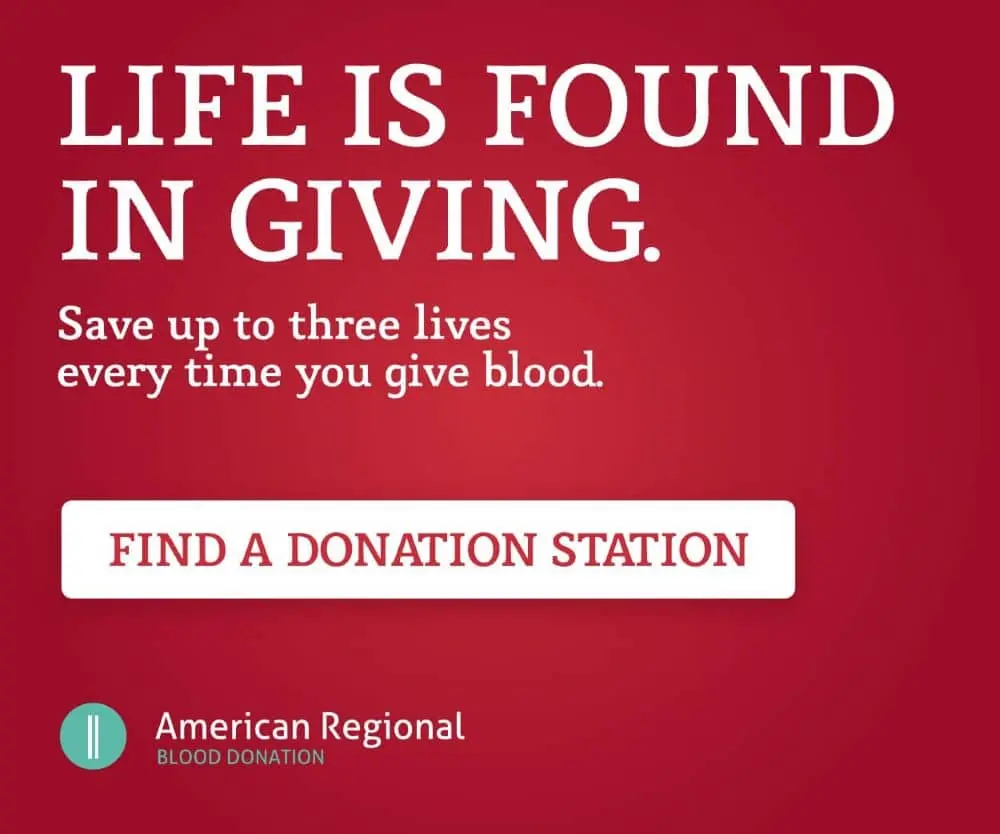
Of all our banner ideas, the medium rectangle banner is by far the most versatile. You can include this banner ad template in-line with text in web pages, news articles and other online communications.
Market full banner (468 x 60)


Inspired and designed after the very first banner to appear on the internet, the market full banner template follows that very size and format. This banner size offers the perfect space to show off your brand and product to thousands of potential customers.
Wide skyscraper banner (160 x 600)


A great pick for a digital marketing campaign, the wide skyscraper banner template can be used to show off products in various applications. Following this template, you can change images, colors and text to reflect your brand’s special offers.
Purple makeup banner ad
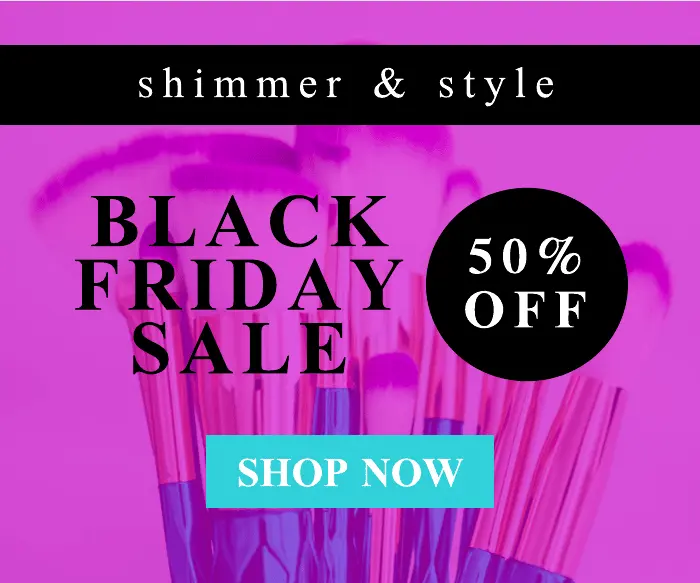

This banner ad works in a number of sizes, from a large rectangle (336 x 280) to a wide skyscraper (160 x 600). If you’re in the beauty industry, our purple makeup banner ad is a great template since it can be repurposed into multiple sizes.
Large website (1200 x 400)

A large website banner ad is the perfect option for today’s high-def screens. With this promotional large website banner template, you can upload your images and add text for your website banner, email header and more.
Print banner ideas
Job fair event (20 x 96)

Event banners are a necessity to advise and direct guests at a conference or job fair. In this particular template, the cityscape image will scream success and ambition. The neutral colors will allow you to sync it easily with your branding or the event branding.
Lush sale advertising (40 x 64)

Bordered by lush tropical green leaves, this beautiful sales advertising banner is a wonderful idea to promote products for brands that represent nature or use natural ingredients.
Executive business (40 x 128)

If you need a more professional template, the executive business banner is right for you. Designed with a professional air, this banner is sleek and modern.
Vibrant business (20 x 96)

We’ve converted the infographic into a vibrant banner template that will highlight the stats you’re proud of quickly and effectively — the more simple, the better.
Athletic event (40 x 128)

This dynamic athletic event banner is one of the best banner ideas out there for athletic events. You can use it to mark distance, give detailed stats, or showcase sponsors involved.
Social media banner ideas
Grand opening Facebook cover photo (851 x 315)

If you’re prepping for a grand opening and are hoping to advertise it on Facebook, using the right-sized banners is key to inviting people in. You can use this Facebook cover photo template by updating the fonts, colors and details to match your business.
Restaurant YouTube banner (1440 x 2650)
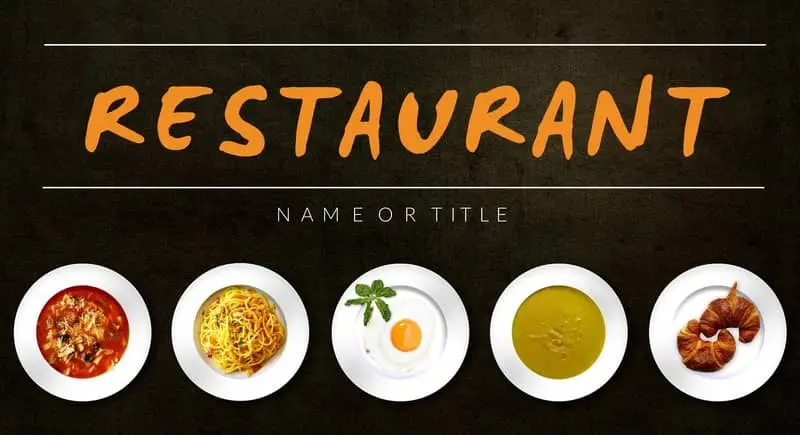
Your business is more than simply what happens in the kitchen, and if you’re trying to expand your social media reach through YouTube, this restaurant banner template is right for you. YouTube banners can highlight your food and immediately show what your channel is all about.
Travel blog Twitter tweet (1024 x 512)
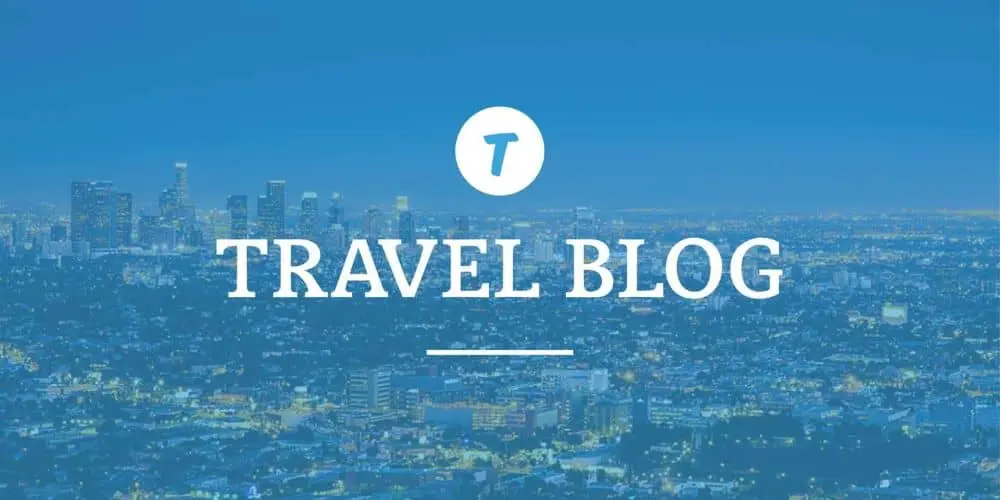
As a travel blogger, you most likely use Twitter to share content with your followers. But a link may not be getting the response or reach that you had hoped for. By implementing images into your tweets with this travel blog Twitter tweet template, you’ll keep readers engaged and entice them to click.
Band YouTube banner
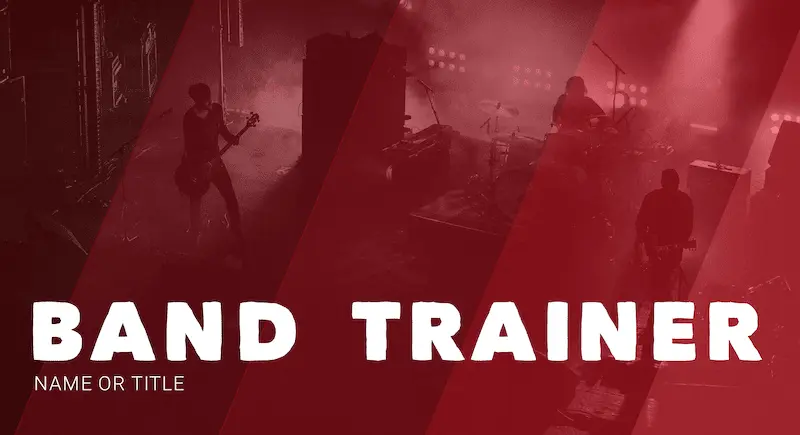
Create visual interest with a gradient overlay. This band YouTube banner design does a great job of creating a sense of mystery to pump up excitement for your next performance and drive subscribers to your YouTube channel.
Photography YouTube Channel Art

This photography YouTube channel art keeps things simple yet interesting with a box around the headline and a nearly black photograph, all on a plain, yellow background. Every element of the banner works together to let the viewer know that this channel is by artists and for artists.
Now it’s your turn to start designing your own banner! And if you want to make it extra easy, try our free banner templates.
If you’re diving into the world of display advertising with website banners, you’ll need to know what standard banner ads sizes are going to get the most attention.
Banner ads appear at the top or along the side of a page, or partway through text, and they help drive brand awareness and sales as people click and visit your page. Some banners get more attention than others, though, and people have become quite skilled at ignoring advertisements. Choosing the right banner size will help ensure your ads get noticed.
Whether you’re using Google Ads or not, it’s important to know the different sizes of banner ads and how you can best use them. We’ve created a quick outline of the most common standard banner sizes to help you pick the right one to maximize your campaign reach.
Here are the most commonly used standard banner ad sizes:
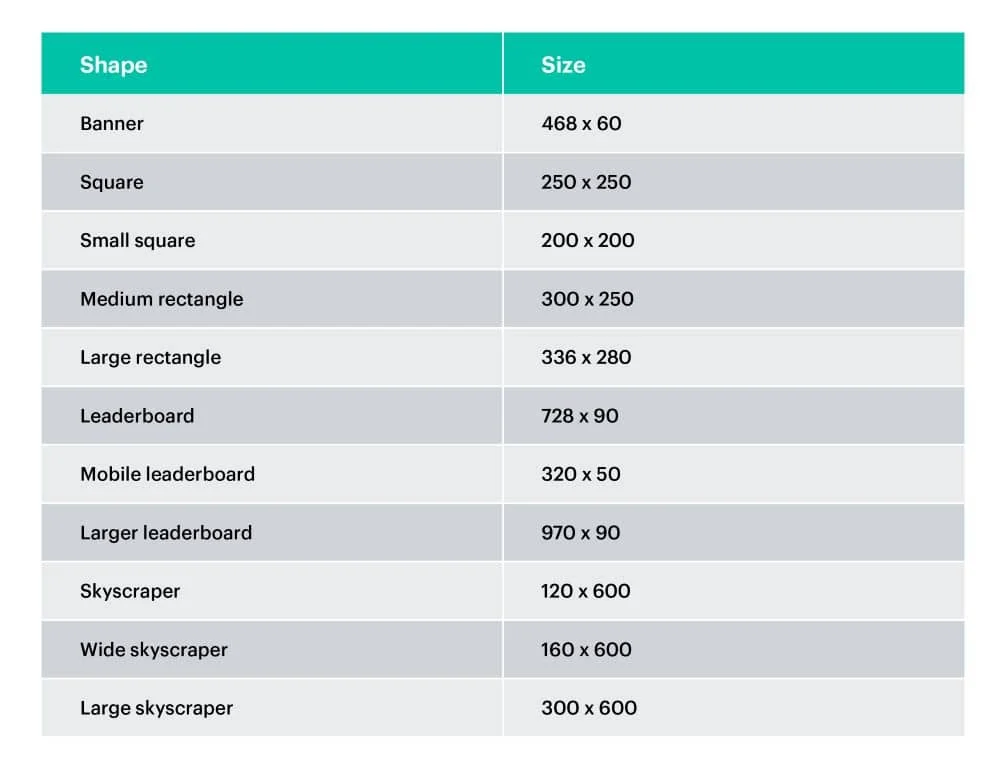
These five banner sizes have the highest click-through rates and will offer the most bang for your buck:
Mobile leaderboard (320 × 50)




Small but mighty, mobile leaderboard ads perform better than all others. It might be because mobile ads are hard to ignore on a tiny screen, or it could be their charming, diminutive size. Either way, take advantage of mobile advertising, but make sure your text is big enough to read!
Medium rectangle (300 x 250)

Medium rectangle banner ads are small enough that you can sneak them in just about anywhere. They work well in the middle of large text blocks and can be sprinkled liberally across a page. They’re short, sweet and to the point, and you won’t have to worry about the design dynamics of a larger banner.
Large rectangle (336 × 280)

Large rectangle banners are nearly as popular as the medium rectangles and offer all the same benefits in a slightly bigger package. They look good almost anywhere, including in the middle of an article, and they hit that sweet Goldilocks spot: Not too big, not too small — just right.
Large skyscraper (300 × 600)

The biggest of the bunch, large skyscrapers (sometimes mysteriously called a half-pager, even though it doesn’t really take up half a page) are, as the name implies, tall. And big! They will get the attention of the user, so make sure to pull out the big design guns here. Bright colors and eye-catching fonts are a must.
These banners are great for your flashiest campaigns, and the size alone tells people that whatever you’re advertising is important.
Leaderboard (728 × 90)

Leaderboards lord it over the rest of the banners by standing right smack dab at the top of the page, turning heads even if the user decides not to scroll or poke around at all. Given their prime real estate and top position, they get a lot of views. And where the views go, the clicks follow.
Now that you’re more familiar with standard banner ad sizes, you can get started on your designs. If you need a little extra design help, why not try our free banner ad templates. We have tons of options to help you get going, and our drag-and-drop editor makes the design and export process super easy.